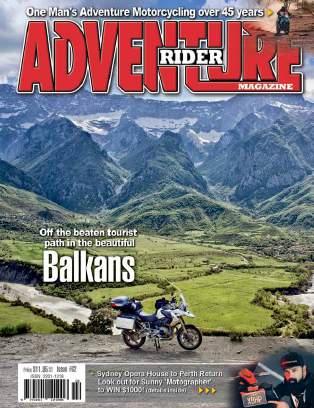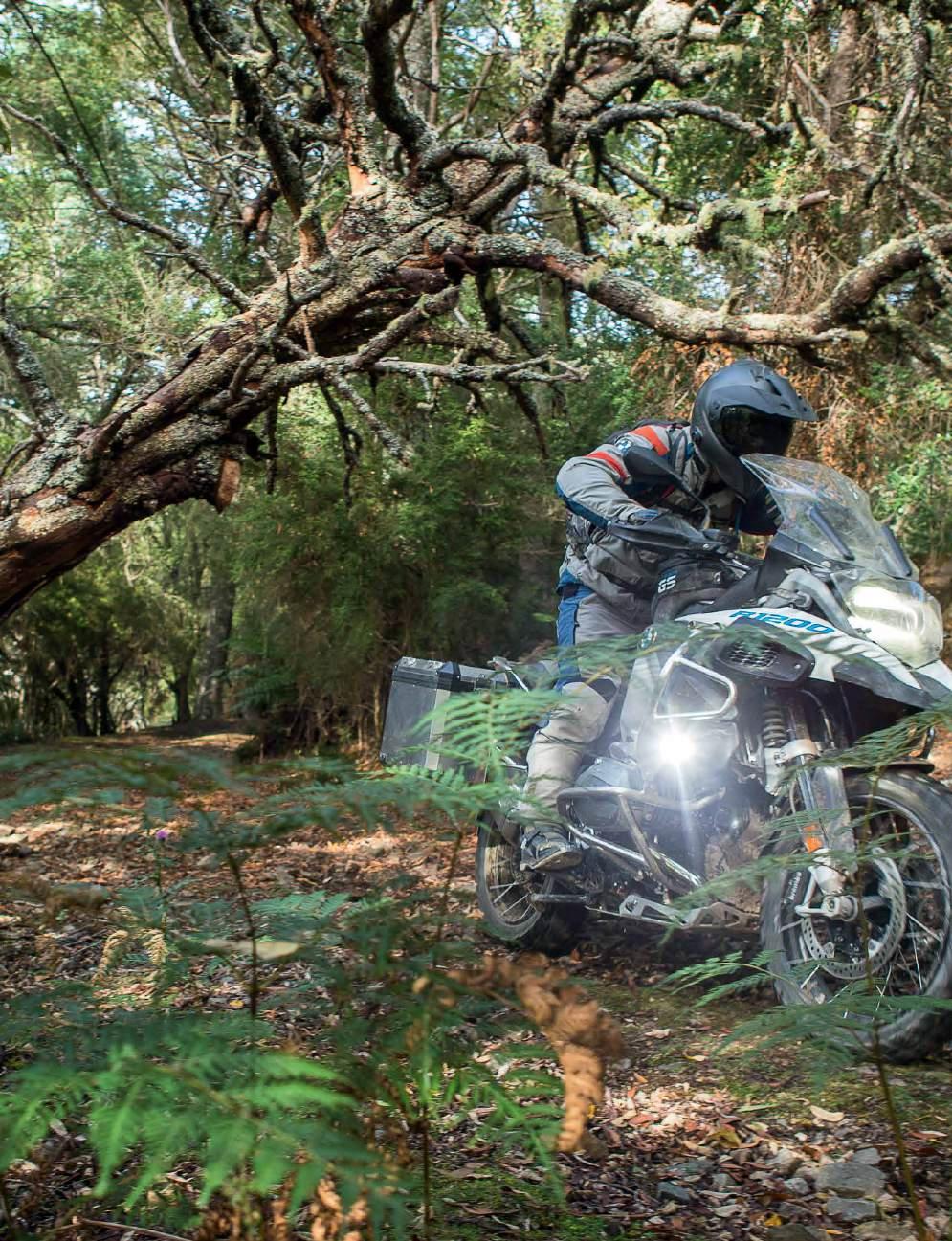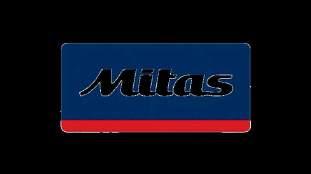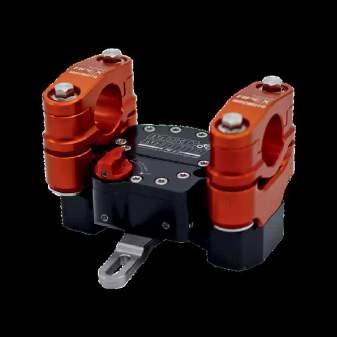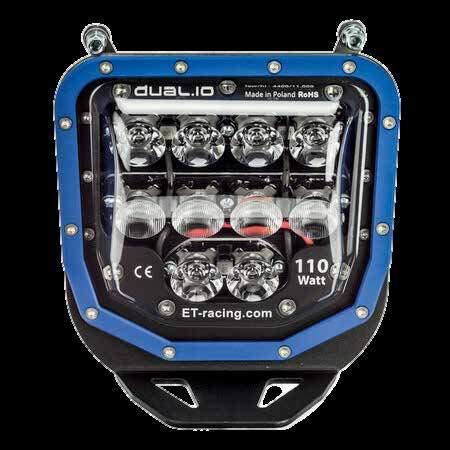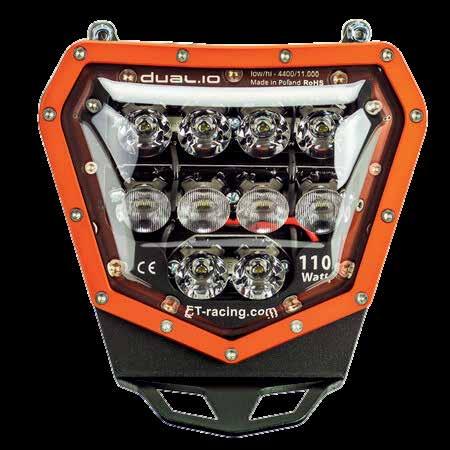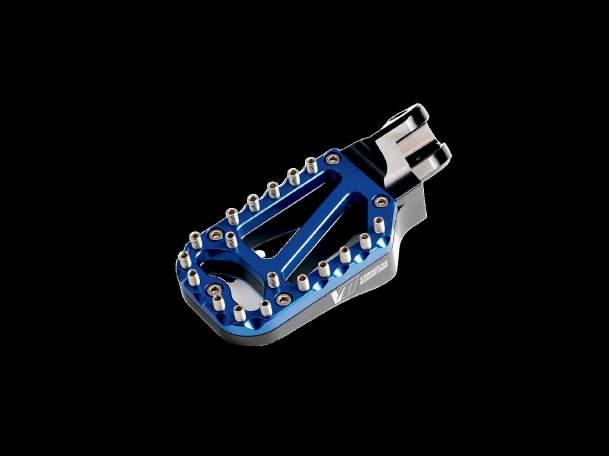
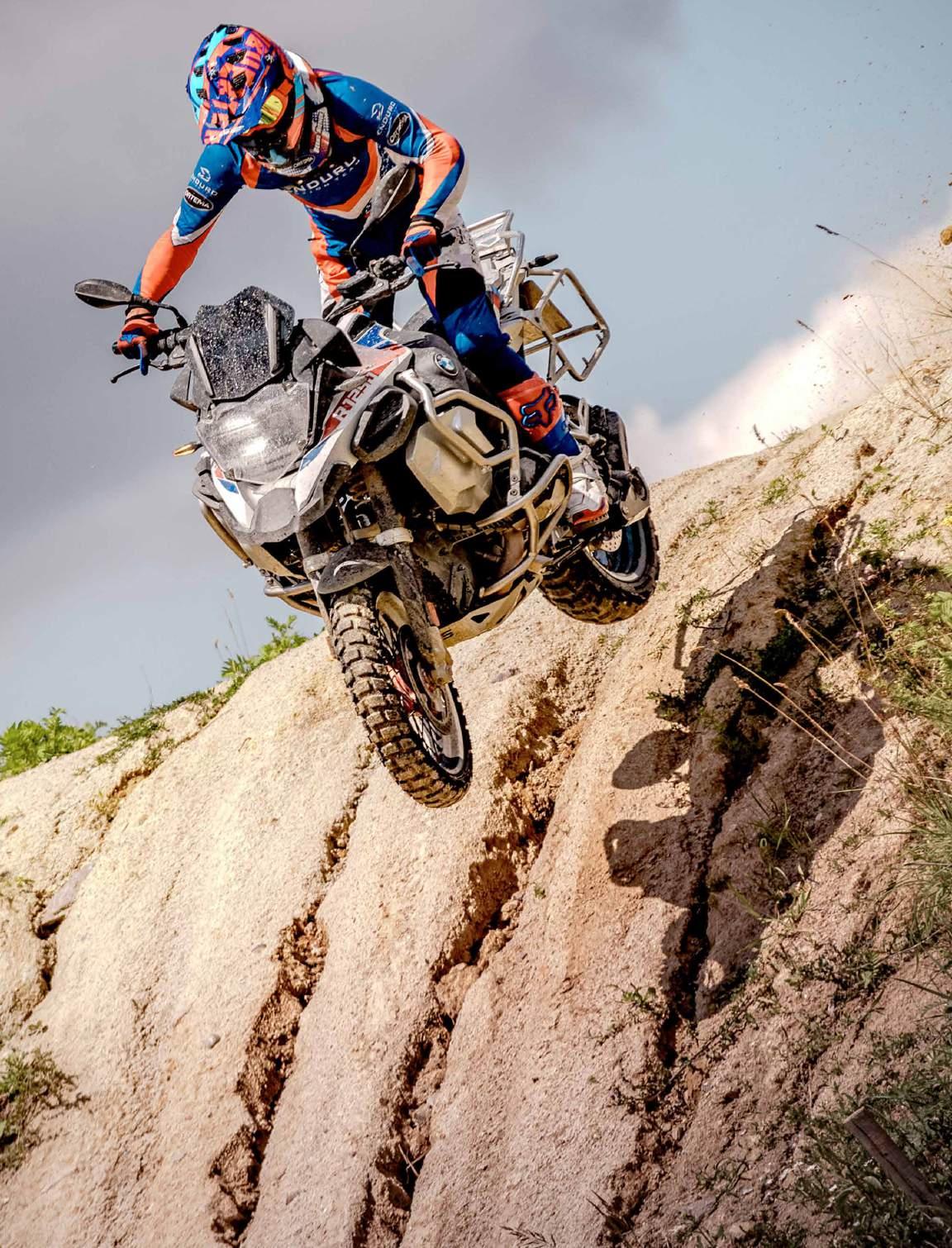
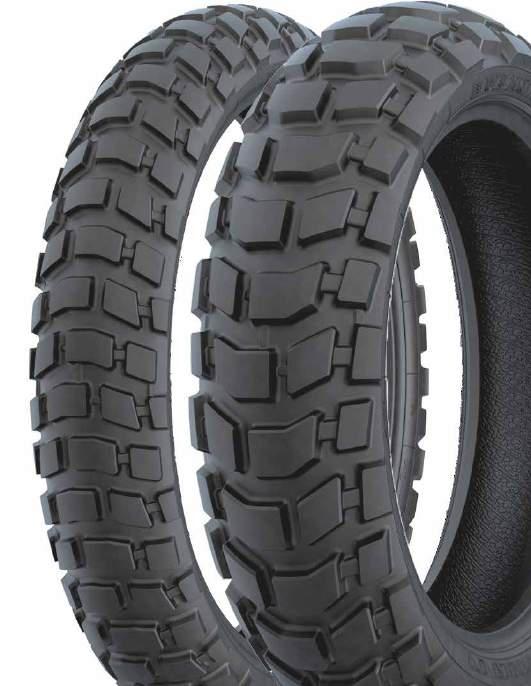






Adventure Rider Magazine is published bimonthly by Clemenger Media.
CEO Tony Clemenger
Editorial Manager Susan Plunkett
Contributors
Bob Wozga, Heather Ellis, Kathy Walsh, John McLennan, Sunny ‘Motographer’, Tim Walker, Mark (Dual Sport Australia), Col Whelan, Andy Strapz, Martin Blatman AND others
(If you would like a chance to have your adventure in print = please email susan.plunkett@clemengermediasales.com.au)
Photographers:
Bob Wozga, John McLennan, Sunny ‘Motographer’, Thanh Phan, Dean Walters, Tim Walker, Adriatic Tours, Mark (Dual Sport Australia), Col Whelan, Kathy Walsh, Andy Stapz, Martin Blatman
Design Danny Bourke Southern-bear@bigpond.com.au
Subscriptions
Phone: 1800 995 007
Website: www.advridermag.com.au
Copyright Adventure Rider Magazine is owned by Clemenger Consulting –Clemenger Media Sales and published by Tony Clemenger. All material in Adventure Rider Magazine is copyright and no part may be reproduced or copied in any form or by any means (graphic, electronic or mechanical including information and retrieval systems) without written permission of the publisher. We welcome ALL contributions but reserve the right to accept or reject any material. While every effort has been made to ensure the accuracy of information, Clemenger will not accept responsibility for errors or omissions or for any consequences arising from reliance on information published. The opinions expressed in Adventure Rider Magazine are not necessarily the opinions of, or endorsed by, the publisher unless otherwise stated.
© Copyright Clemenger Consulting, 2024
Articles
All articles submitted for publication become the property of the publisher. Editors reserve the right to adjust any article to conform with the magazine format.
L1 397 Chapel Street South Yarra 3141 P: +61 1800 995 007 tony.clemenger@clemengermediasales.com.au www.clemengermediasales.com.au

Ireceived a letter last week from a reader that made me chuckle. “Why?!” they questioned, do so many adventure riders talk about multiple negatives in their stories?
Quote:
Halfway in and the author had whinged about the Hume, staying in pubs, uncivilised Australian speed limits, his pub meal price and quality, Bonegilla (even though his parents were grateful?)
- I was about to jump in front of a train. Skimmed the second half, more whinging, Bright, cyclists, dairy farm flies, inadequate “mountains”, ski resorts........he really should go ride somewhere he enjoys. Wonder why he’s riding solo?

thanked State Roads (mental note to email positive feedback) for the fun obstacle course the road surface offered. Luckily that more than reasonably priced lunch I just had at a lovely original servo/café, kept me grounded.
“ “Why?!” they questioned, do so many adventure riders talk about multiple negatives in their stories? ”
Apparently there are people out there that actually enjoy riding. Let’s hear from them.
Fair enough. I have thought after this several times since.
How about this brief anecdote: I hit the highway and immediately needed to weave through a 20-metre long field of potholes. Luckily that expensive lunch I just had at the decaying old servo café, sat heavily and anchored.
Let’s remove the negative: I hit the highway and immediately
Hmmmmm. Now I just sound sarcastic? I appreciate hearing reader thoughts but I’m not sure mentioning ‘negatives’ suggests a rider does not appreciate or enjoy a particular ride.
Then again, maybe we do need to be mindful of including all the positives if we tend to first consider what went wrong.
As a pillion I have enjoyed many a ride but very few didn’t have some ‘thing’ negative. Freezing cold winds, sudden swarm of insects, crazy drivers, sudden appearance of cows.
But that feeling of exultation and freedom; of finding new, unexplored places, is always the crown.
Maybe we need to remember to always talk about that - and underscore it!
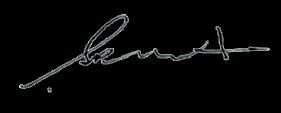
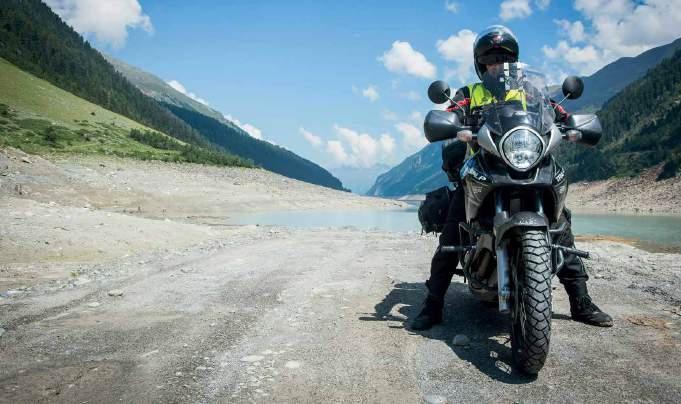

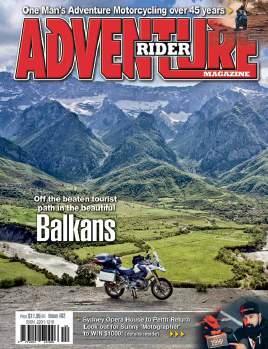

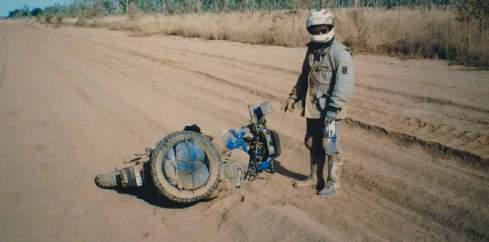
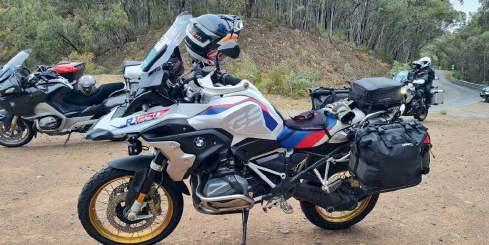
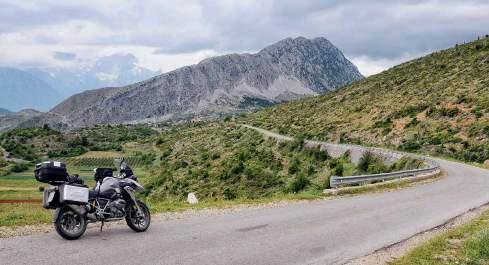
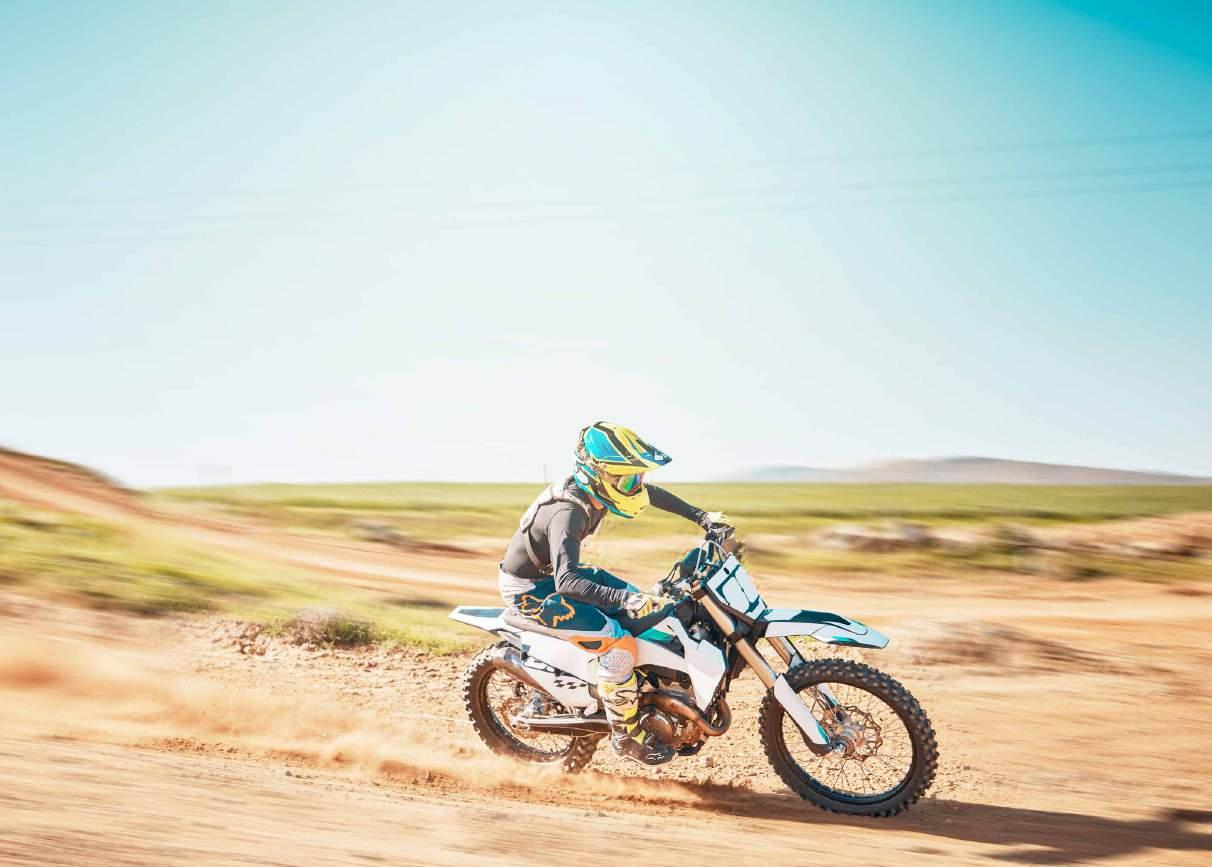


zoleo.com.au

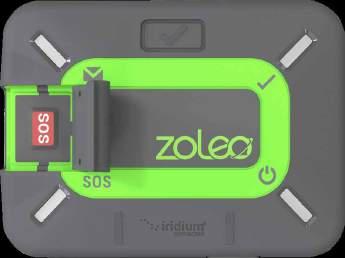
Travelling remote, stay connected
Keep connected with loved ones, ZOLEO extends your phone from mobile to satellite coverage. Take advantage of seamless app to app messaging with 900+ characters and FREE Check-ins.
Affordable and award winning satellite communication for your adventures, GO with ZOLEO.

The 46th Dakar Rally has been deemed one of the toughest yet. It included 13 full days of racing, 12 stages, and a 48-hour stage that saw riders sleeping under the stars with no assistance from their teams.
Defending champion, Kevin Benavides, came into the 2024 Rally with some fitness concerns, but regardless, he set about his title defence early.
Starting with complex terrain and difficult navigation, a small mistake in stage two cost Benavides. The factory KTM rider put in a huge effort, working his way back up the order, to earn a very respectable fourth place overall.
“It’s been a really tough Dakar. They all are of course, but this year had some very, very long days of riding, especially with the 48-hour stage. It’s been good, I have been able to take three stage wins, so we can take some positives away
from the event. Both Toby and I finished inside the top five as well, which shows good consistency. It’s frustrating not to finish on the podium after all the hard work that the whole team put in. But we’ll go away now, get some rest, and then we have a few things we know we need to work on to come back stronger next time.”
This year was Toby Price’s tenth year racing the Dakar rally. A navigational error on stage one cost Toby some time

which he could not, ultimately, make up.
But, following his navigational error, Price showed why he was a previous Dakar winner, with fast, consistent riding over the remainder of the rally.
Toby earned several fifth-place results in individual stages and finished runner up in the final stage.
Toby finished fifth overall, following his teammate, Kevin Benavides.
“For us, it’s definitely been a really tough event this year. Thankfully, it’s always a good result when you can get to the finish line in one piece at the Dakar, and here we are, happy and healthy. Looking back over the week, we were never far off the pace, just made a few too many mistakes out there and as you know that can cost some serious time at Dakar. The whole Red Bull KTM team have been incredible over the two weeks and have worked so hard. It’s a shame we’ve not been able to reward them with a podium. Big credit to the top guys as well, they got it done this year, so congratulations to them.”
Results as follows:
1. Ricky Brabec (USA), Honda, 51:30:08
2. Ross Branch (BWA), Hero, 51:41:01 +10:53
3. Adrien Van Beveren (FRA), Honda, 51:42:33 +12:25
4. Kevin Benavides (ARG), KTM, 52:08:56 +38:48
5. Toby Price (AUS), KTM, 52:15:36 +45:28
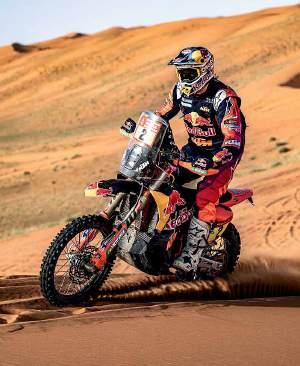
The Yamaha WR450 has been a long-time, tried and true machine. Based off the highly successful MX model, the YZ450, the 2024 WR450 has seen a host of new improvements. It’s now slimmer, lighter, and more tractable than ever.
The aim was to make the new bike easy to ride fast, and more versatile. Significant changes have been made to the new model, longer and stronger power delivery, suspension and handling designed uniquely for this model. If the latest changes to the YZ450 are any indication, then the WR450 will be a leader in off road machines.
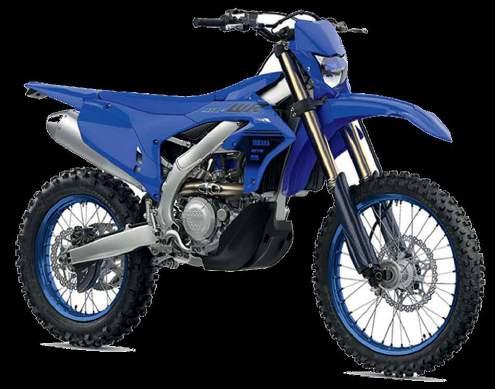
Keep an eye out for the upcoming edition of Adventure Rider magazine for a full review on the 2024 WR450.
Ifyou’re serious about adventure riding, no doubt tyres are something you think about a lot: differing terrain, what tyre is best suited for your next adventure. But the worst part about tyres is changing them. Well, Ballards have produced this beaut little set up to make changing tyres at home a little easier, and to save you constantly running to the tyre shop.

It has pin-down points allowing you to peg the changer down to the ground or bolt it to a workstation, keeping it stable during use. It has a rim-lock assist-point, making it easy to lever your rim-lock back into place, and is easily adjusted to different tyre sizes. Simply unbolt and adjust to your requirements. This tool is specifically designed to take the grunt work out of changing tyres. Check them out at: www.mxstore.com.au/p/Ballards-Tyre-Changer-with-Bead-Breaker.

RideADV is running an intermediate level introduction to adventure riding course from the fifth to the seventh of April.
The ride will commence at Singleton before heading to Tamworth and returning.
These rides are designed for people who are relatively new to adventure riding and wish to learn how to do it properly and safely, while also catering
More German magic, now in a can
for those who wish to brush up on their skills.
Open to all makes of bikes, this ride features inputs from Ride adv’s Greg ‘TB’ Yager, Mick ‘Strongy’ Strong, John ‘Johnboy’ Harrison, and others.
These blokes have a wealth of knowledge when it comes to adventure riding, from practical experience to bike set-up.
During the introduction to adventure riding experience, all aspects of riding are covered, from rider technique, personal tracking, luggage packing,
Bike maintenance is not something to be taken lightly. No-one wants to be ‘that person’ on a ride with mates, broken down and holding everyone up.
Sure, you clean your air filter, change oil, check your chain, brakes, and wheel bearings, etc.

But have you ever given a thought to the fact that plastic deteriorates? Maybe you have? But, your consider there’s not really much you can do about it, right?
Well now there is. The champions at Wurth have just released their product, RPR (rubber and plastic rejuvenator) in an aerosol can.
RPR is not like other products that only shine the plastic.
Wurth RPR is designed to seep into the plastic or rubber. It’s designed to get into the base material and rejuvenate it as the name suggests. It then puts a protective film over the top with a satin finish.
The harsh UV we get here in Australia causes plastic to deteriorate quite rapidly, and with so much plastic used on modern bikes, Wurth RPR is truly worth a look.
RPR is designed to be used on any unpainted, plastic, rubber and even vinyls surfaces/items. www.eshop.wurth.com.au/
understanding GPS, bike set-up, what tools to carry, tyres and how to change them track-side, and much more. Get your tickets at: www.rideadv.com.au
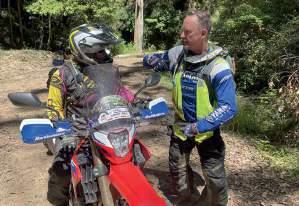
Comfort, practicality, durability, and safety are all to be considered when choosing a jacket.
The Alpinestars Andes V3 WP jacket is designed using Alpinestars exclusive Drystar construction.
The technically-advanced construction of this jacket offers abrasion resistance, protection, and is adaptable to all weather conditions. Alpinestars claims this jacket is 100 per cent waterproof and offers high levels of breathability.
This jacket features waterproof front cargo pockets, a large external utility pocket on the lower back, plus internal pockets, and a waterproof wallet pocket.
It also features a removable long-sleeve thermal liner, pre-contoured sleeves with stretch panels on elbows for freedom of movement, as well as hook-and-loop closing waist adjustment for a customisable fit. Internal impact protection provided by the removable elbow and shoulder protectors, and the chest and back compartments, are designed to accommodate the Nucleon chest and back inserts as an accessory upgrade.
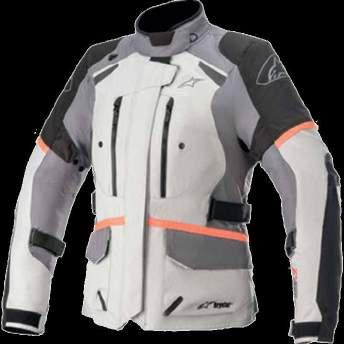
Well worth a look if you’re in the market for a new jacket.
www.mxstore.com.au/p/Alpinestars-Andes-V3-WP-GreyGrey-Womens-Adventure


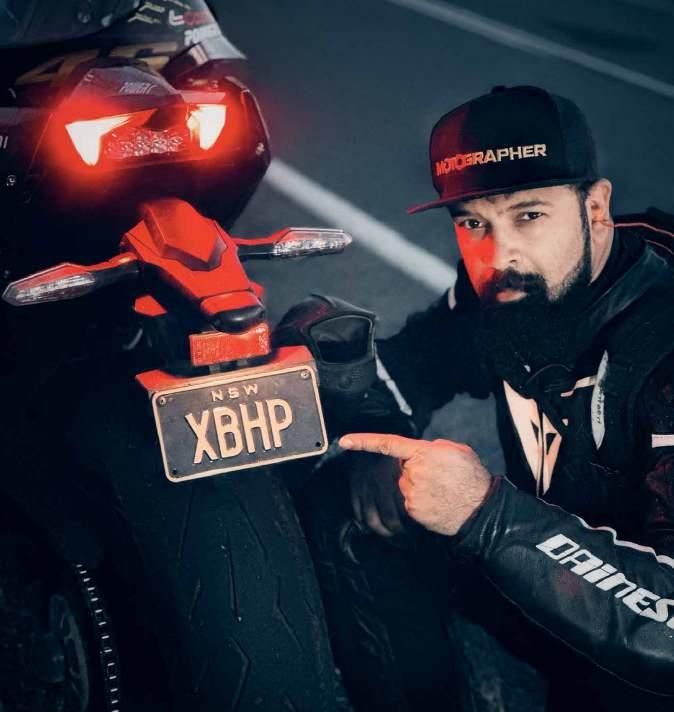
On page 12 of this publication, Sunny Motographer will be heading off to Perth from Sydney on March 20th 2024 on a special ride to explore our glorious land. He plans to arrive in Perth around 1st April and will return to Sydney around 14th April.
To be in the draw you will need to take a selfie with Sunny
anytime after March 20th until Sunny returns to Sydney. You might be in Port Augusta or at the Nullabor Roadhouse - but if you spot Sunny ask to take a selfie and then send your photo to yourview@clemengermediasales.com.au
Sunny will select from the draw via a random selection process and we will announce the lucky winner on May 1st.
Photo (with date stamp) to yourview@clemengermediasales.com.au
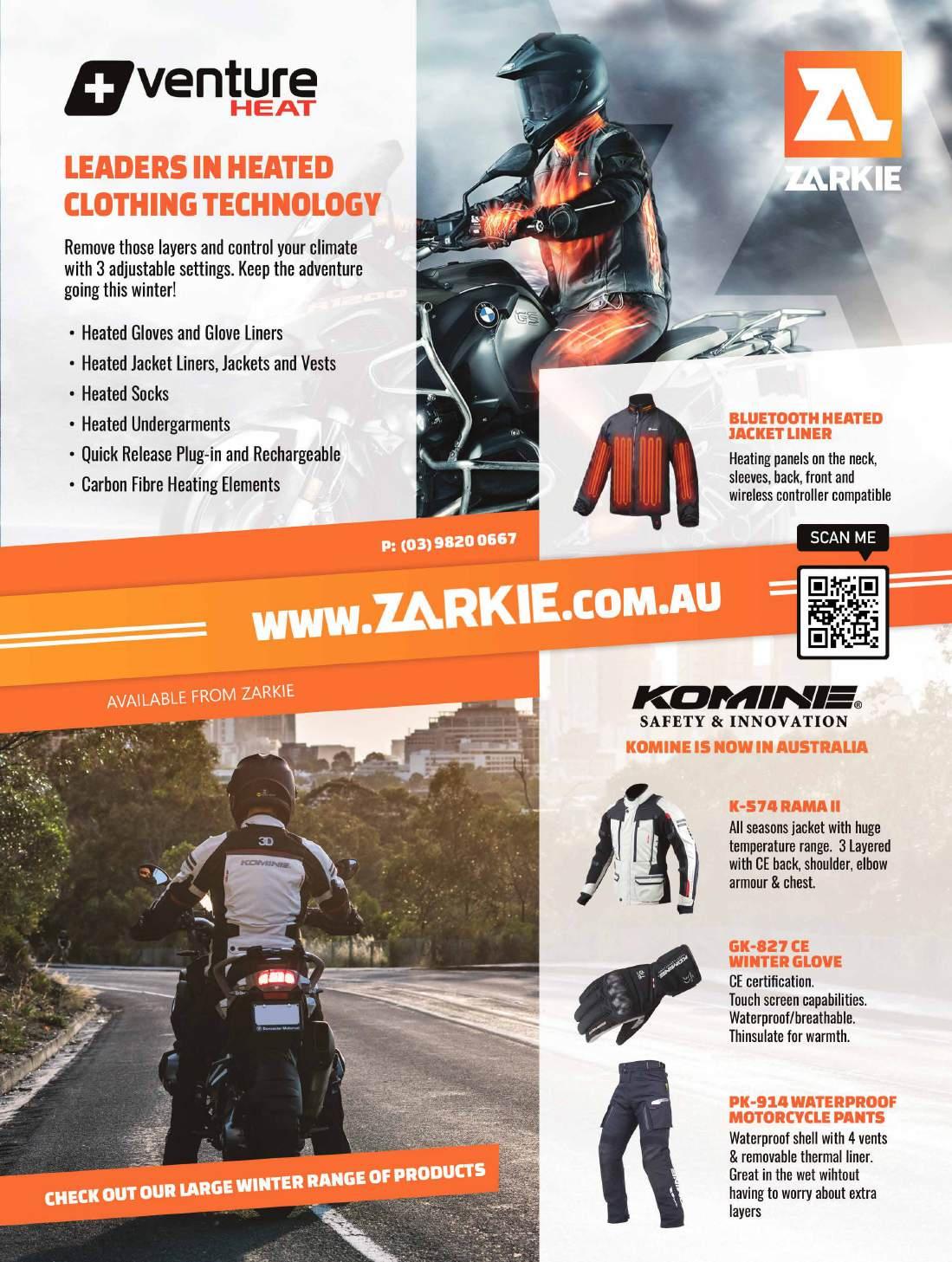
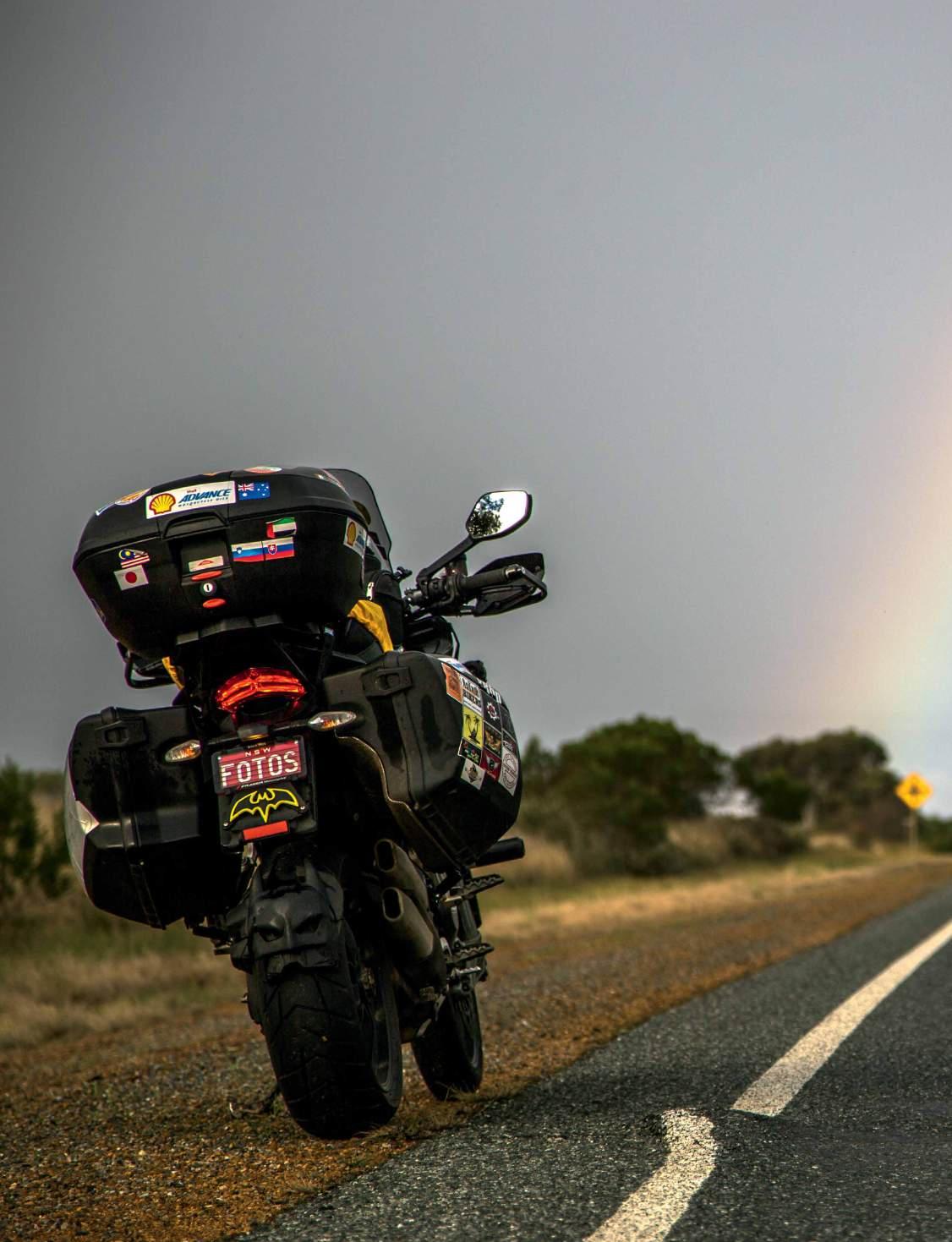
Across a Continent: Sydney to Perth and……?
Words and Images: Sunny ‘Motographer’.
Australia has the privilege to be a continent and a country at the same time. It makes for much grander communication when you hear roadtrippin’ across a continent. And it makes for an even grander one when you can say you have gone around this country of a continent not once, but three times. Yes! I have done three big laps of this insanely vast country that was once part of ancient Gondwanaland. First in 2007 with two relatively modest Hyosung GT650Rs, then in 2013 with a Ducati Multistrada 1200, and then in 2017 with a Kawasaki Ninja H2 and a Ducati Panigale1299. Each time at least 20000 kms, the big lap and the center included.
And here we are, six years later, still flippin’, still twistin’ and still wanting to have another go at this land with two of the world’s ‘best’ motorcycles.
Starting from the megapolis of Sydney, the lure of the highlands of NSW and VIC gives way to the beautiful, albeit over-marketed, Great Ocean Road.

And then the nothingness slowly builds up as we will leave Adelaide and enter into the Nullarbor. The beautiful Great Australian Bight, Australia’s longest straight road and more of such curiosities on a vast plain treeless landscape makes for an otherworldly road trip. We will end this relatively shorter ride in Perth. Or will we ?
There are two choices. The first one, that we will ride back to Sydney and not ship the bikes back. Turns out its cheaper and we just want to do it, less paperwork. The other, we will do an Iron Butt on our way back. Almost 1700 kms in much less than 24 hours.
The bikes would be a bit odd when you talk about touring, but as long as they have two wheels!
A 2017 Kawasaki Ninja H2 and a 2022 Aprilia Tuono V4. Four cylinders each but with vastly different natures. Let us continue with the preparations. We will catch you in the upcoming issues of the ADV RiDeR MAGAzine!



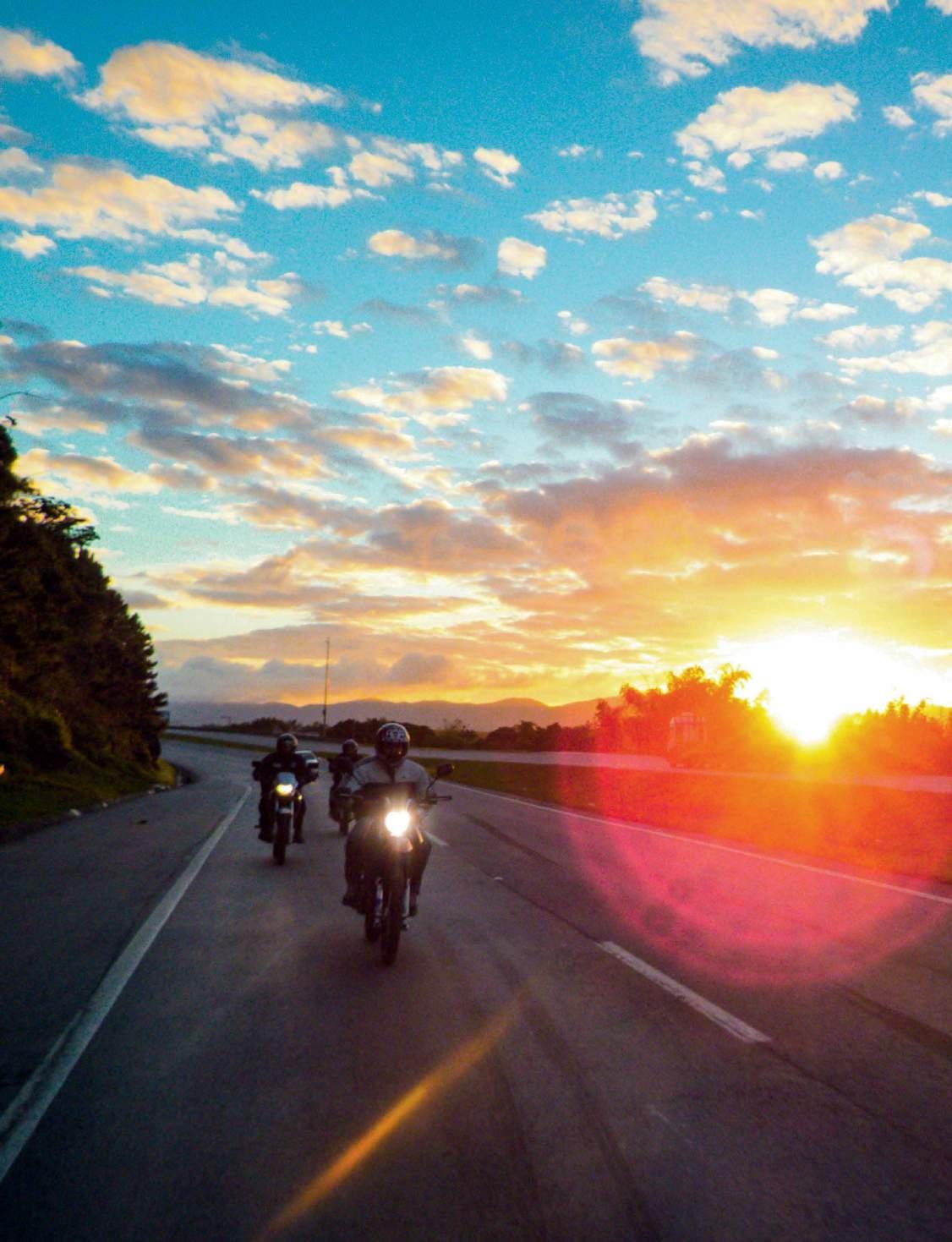
Words: Bob Wozga

Ever since our ancestors clambered through the trees, we have been communicating with each other; Initially in close quarters from branch to branch or tree to tree. Then further afield, from grove to grove. The voices became louder to cater for the longer distances. All the surrounding primates knew your business, whether you needed to bring home nuts and berries at the end of the day and why were you talking to the ranga at the bottom of the gully.
As we became wiser and left the safety of the trees, we stopped grunting loudly over distances and started the thumping of drums and trees to alert our friends and neighbours. This eventually evolved to the spoken word and language, where I’m sure there would have been some that looked in the direction noise, bewildered, thinking, “I didn’t understand a word of that”.
Later, when we only wanted to direct the conversation to one or a few people, we started using semaphore and morse code. This worked well, however, there was still the odd grammar nazi that complained that the sender did not know the difference between there, they’re and their.
“ With human evolution came the evolution of communication devices for motorcycles. These devices are there to keep us safe, well informed and entertained. ”
These forms of communication worked well in their uses but are cumbersome for the motorcyclist. Yelling through the helmet is very muffled, morse code via the headlight of the bike distracts you from watching the road, and reading semaphore via the revision mirror creates spelling mistakes.
Thank God that over the millennia, man has evolved from riding tree branches down hillsides to get his adrenaline fix to riding motorcycles down hills, motorways, and dirt roads. With human evolution came the evolution of communication devices for motorcycles. These devices are there to keep us safe, well informed and entertained. Some riders like to chat all the time, some like to keep their fellow riders informed of road conditions and obstacles. Others like to ensure all the riders in the group are OK mentally, physically and mechanically. Having the device attached to your body at all times in the case you do come off the bike, means you don’t need to crawl the 15 metres to the resting
place of your bike to inform the rest of the riders that you are having a little lay down. Instead, it allows them to hear the Wilhelm scream in real time.
There are numerous devices on the market that can be used for motorcycle communications. 2-way radios can be used due to their low expense, relatively good range and can be used between motorcycle and support vehicle if one being used. Though they are not always waterproof, they do have a listed range of up to 10 km depending on the surrounding topography but you more than likely to get 2 or 3km range. Third party kits are available to attach a microphone and speaker mounted in the helmet while the 2 way radio is attached to your hip. Working on the UHF CB (Citizen Band) frequencies, they will communicate to other devices on the same channels and do not need a license from the ACMA to use them. Charging is generally via a 240v outlet or the 12v from the cigarette plug. These are generally asynchronous, and you need press a button on the device to speak. This can be awkward while riding. The can Prices range from $150 upwards and can be

Below: Classic two-way radios (walkie-talkie).


sourced through 4x4 outlets, motor vehicle spares suppliers, Jaycar etc.
Mobile phones on their own can be used but again, you need to stop the bike to look at the screen before pressing buttons to make the call and the wrong person gets the Wilhelm scream. If you are out of mobile coverage, this will also hinder your communications.
With motorcycle intercom systems, the two technologies currently used are Bluetooth and Mesh. Both have their merits and need to be considered when selecting which technology and device best suit your needs.
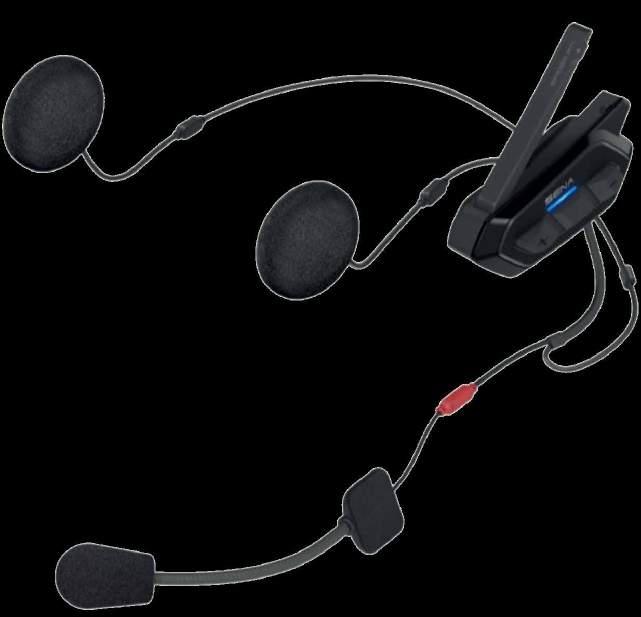
Bluetooth intercoms are more affordable than Mesh, easy to set up and have a relatively short range roughly 400 to 600m. Mesh intercoms can cater for 2 to 15 participants, has a larger range roughly 1 to 2Km. Mesh links all devices together so they communicate and give a wider network coverage as opposed to the redundant daisy chain method of sending signals that worked on a hierarchical system. In layman terms, Bluetooth is like using coax cable and token ring instead of Cat 5 and ethernet.

As always, determine what uses and how often the communication device will be used. Consider the price, audio quality, communication range and number of participants – 2 or 10. Make sure you can find the buttons with your gloves on. Ensure it is waterproof and has ample battery life / talk time that will cover your ride as well as the ease of recharging. Also consider additional features such as on-air software updates, handsfree functions, voice assist, GPS, and for light entertainment, a radio. Depending on who you ride with, don’t forget to ensure everyone’s devices are compatible so you are not sitting at a service station for half an hour trying to connect everyone up just after spending half an hour showing everyone how good your new intercom device is.
The two main contenders for intercom units are Cardo and Sena. Both have several products available using Bluetooth and Mesh.
As an example, Cardo Spirit Single retails for $179:00. It will connect 2 riders using Bluetooth technology at a range of 400m. Most riders travel closer than that. It is waterproof, will connect to any Bluetooth headset, and has voice control for your phone and GPS.
Sena has the Spider RT 1 Single pack retailing at $345:00 It will connect up to 24 riders to a range of 8km with riders 1.6 Km apart – not a bad range for a large group. It will connect to your smartphone and utilize the phone’s Bluetooth to access your music, GPS and phone calls.
On the grander spectrum for those travelling to more remote places and want to keep those at home informed of your progress, safety and well-being, there are a range of communication satellite devices on the market. These do require connection plans and are cheaper than a sat phone. They use the Iridium Satellite network when out of mobile coverage. It works by being paired with your mobile phone and allows you to send messages to anyone with a mobile phone or email address. It also has a panic button if you need emergency assistance.
Zoleo Global Satellite Communicator Retail from $319:00
Spot X 2-way satellite messenger with Bluetooth. Retail from $417:00
Garmin satellite messenger Retail from $499:00
Now when you see a buffalo in a corn field, you can tell your riding mates. We have come a long way with the advances in technology and communicating, I just hope AI does not come into these devices and start transmitting my thoughts while riding.

Top right: Garmin inReach® Mini 2. Below: Spot X 2-way satellite messenger with Bluetooth.
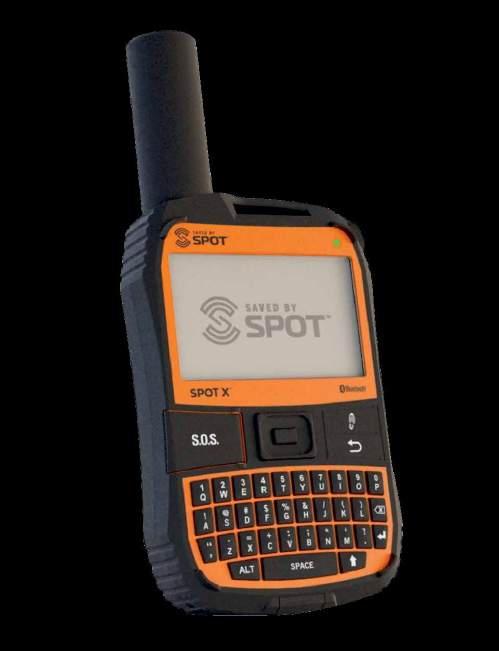

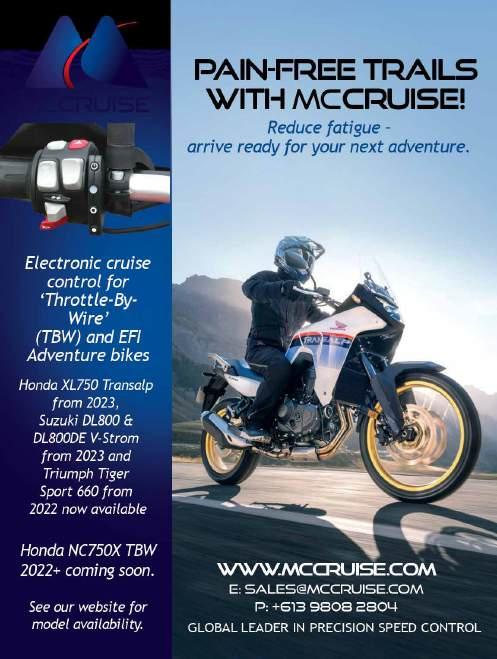

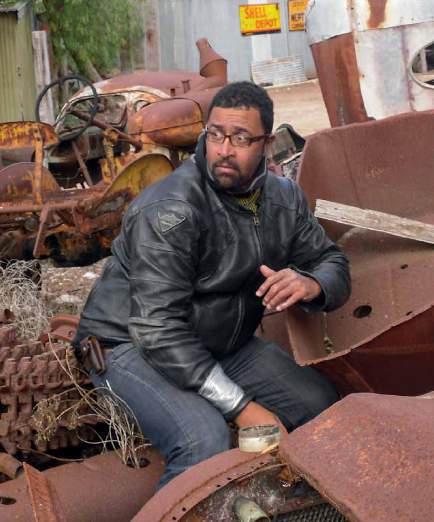


Landing on these shores twelve years ago by plane from London via Los Angeles, it wasn’t long before I stood staring out at the Spirit of Tasmania in Port Melbourne. This was the same place my infant mother and family arrived as refugees after the second world war. Her parents were Holocaust survivors and they all ended up calling Australia home. I was born in London after my mother fell in love on her travels as a young woman.
Despite being registered as an Australian Citizen from birth, I had never been to the “Lucky Country”. As my 40th birthday came and went I decided it was time to come check it out. I had the advice of my good friend Phil, a fellow motorcycle courier, ringing in my ears. Phil was a Sydneysider biker who escaped the enthusiastic attention of NSW Highway Patrol, for a little more forgiving road attitude, in 1980s London…and the
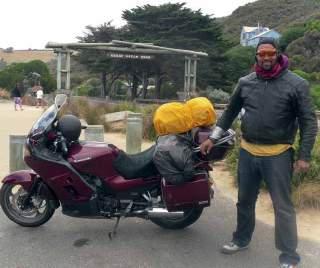
promise of all manner of pleasure with that short hop into Europe.
“Marty, get yourself a bike as soon as you get there. Get a Swag, strap it to your bike. Grab a big map and go explore. You won’t regret it.”
A few short days later after recovering from seeing the prices of the bikes I first looked at, I found one within my price range which was comparatively cheap as chips. Soon after I roared out of a showroom in Elizabeth Street, on an old Kawasaki GTR1000. The broad grin that came from knowing an adventure lay ahead, was painted on my face. The
Top left: The Kawasaki GTR1000.
Above: The timber sign welcoming travellers to The Great Ocean Road.
Below: Cape Otway Lightstation.
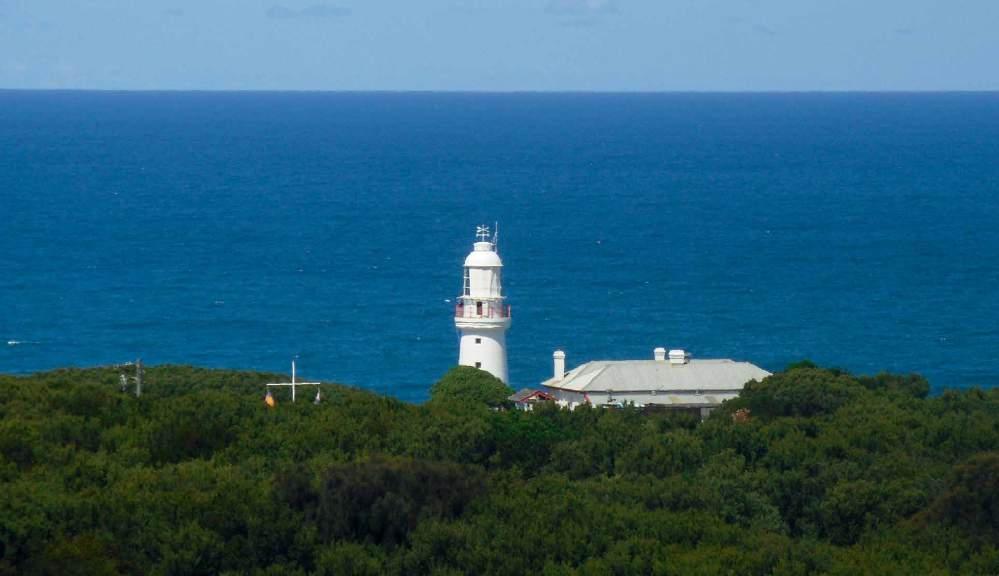

previous day the Maroon Kwak bedecked in rally badges had been unloaded from a trailer after being tearfully farewelled from a white-haired Ulysses Club member who was hanging up his riding boots. I never found out whether the white hair was induced by age or his experiences on bikes. Next stop was Rays Outdoors on the Nepean Highway to buy my Swag, maps and other sundry accoutrements, then a bit of tinkering in a mates lockup, strapping, unstrapping, re balancing and strapping up again. Then repeating the whole process several times. At this point I was loaned a rather splendid Tom Tom that was bolted into place and connected. I didn’t use it much between towns but it was a godsend

when arriving in new cities. Genius device. When setting off from Melbourne the obvious first direction is The Great Ocean Road. I was aiming for Adelaide to meet up with Phil’s brother Tim who was promising to show me a good time riding around the Adelaide Hills and the delights of South Australian public houses. The Great Ocean Road stretches for 242 kms
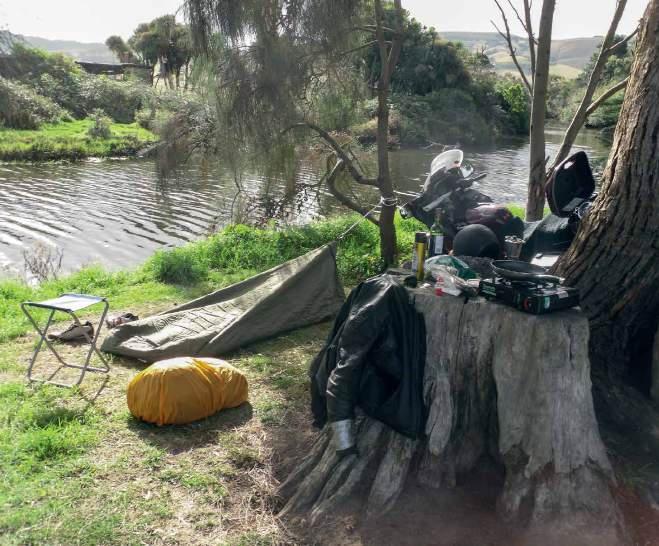
and is known as a scenic and stunning blast. It seemed rude not to kick off the fun by experiencing it. As I wobbled off down the road, it dawned on me the bike was definitely overladen with all my gear and my 125kgs of flesh and bones. With just a puncture repair kit and a couple of spanners as a tool kit, I planned to rely on the plastic fantastic, the Royal Automobile Club of Victoria and the goodwill of mechanics and strangers. The rest of the ballast were my “essentials” including a small foldaway stool…ya never know when you are gonna need to sit down somewhere. I resolved to take it very easy for the first few days, getting used to
Top left: My first wild Koala.
Above: Twelve Apostles
Left & below: A nice spot for a camp and a good meal. u
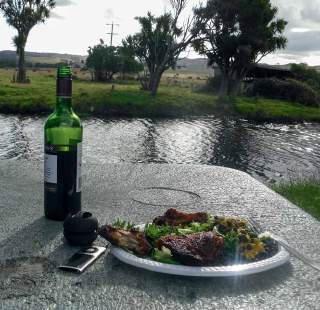
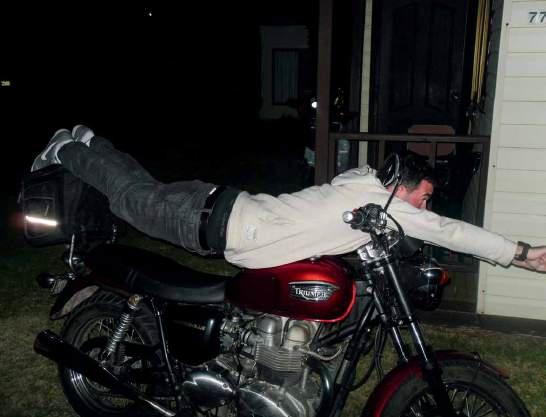
the bike and the excess weight. She handled like a Cadillac and it would take me until Adelaide to feel truly comfortable.
Once I passed under the timber sign that straddled the road welcoming travellers to The Great Ocean Road, the first things to strike me were the amazing Malibu style houses built on stilts and platforms every few miles coming out of the side of cliffs. They were futuristic,

almost alien constructions that looked like HG Wells machines that could burst into life. I had to stop and gawk in awe and only imagine what living in one must be like. I doubted I would ever sleep soundly in a bed that in my dreams was on the verge of plunging into the sea.
Navigating my first set of twisties astride the Caddy were interesting. I was lucky nothing was coming the other way as I rounded several corners and crossed the
Above left & above: No motorcycles were harmed in the pursuit of this activity.
Below: Some people are not just traveling Australia.
centre line, straining to restrain physics all the way. Soon after I found myself cautiously picking my way through fallen branches on track to Cape Otway to see a lighthouse, more memorable however, perched in the crook of a bough of a gumtree, was my first sighting of a wild Koala.
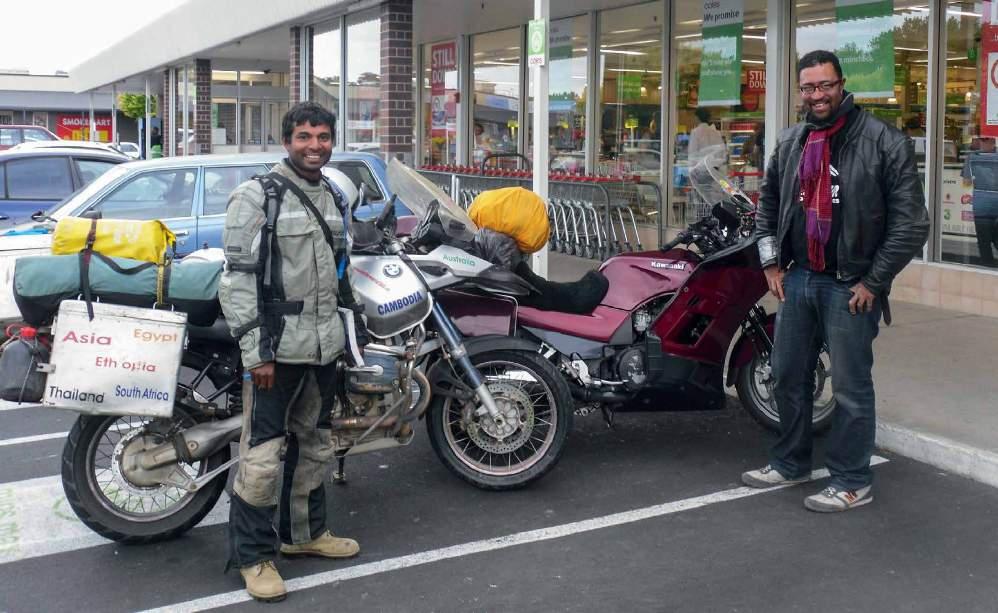
I don’t wish to mislead, it was no man vs nature encounter as the koala’s presence was flagged to me by other fellow travellers on the road, however everyone was respectful and I like to think we were only a minor distraction. Further on that day the sandstone arches and towers of the Twelve Apostles rose biblically from the sea and stopped me in my tracks so I | dismounted to stretch my legs, take a closer look and get some pictures. It was a beautiful meditative spot to pause and take in the beauty of what lay in front of me. Bathed by glorious sunshine, I faced the bike out to sea, popped her on the centre stand, lay back and catnapped thinking what a lucky boy I was.
As evening beckoned, I pulled off the main road and found a stream to pitch my swag, if “pitch” is the right verb with a swag, or does one simply string it up? I’m not sure, but it got erected by a stream and a couple of trees. I cooked up some well-seasoned chicken on a camp stove, and sat on my little chair, drank red wine, read a bit of a book, listened to some BBC comedy on my iPod, got an early night and BLOODY loved it.
Further down the road I met a Canadian fella riding a rented Bonneville. Garrett and I bonded over coffee and compared our trip so far. Seems we had a common goal, which was to meet friends in Adelaide and drink beer. He let me try out his bike and was lovely to be on a smaller lighter machine for a while. That evening we swapped stories and shared a few beers at a campsite before an inebriated balancing competition. No motorcycles were harmed in the pursuit of this activity.
As the miles slipped by and the roads and scenery got ever more magical, the motorcycle meditations became more focussed. I reflected on how it must have felt for the original pioneers on horseback and those huddled in wagons with little suspension bumping along rutted tracks. I gave thanks to the engineers and designers who developed my gloriously comfortable machine.
Millicent was the small South Australian town where a good London friend called Biggles came from. I had told him I would swing by and have a look. I found and took a picture of a street name bearing his
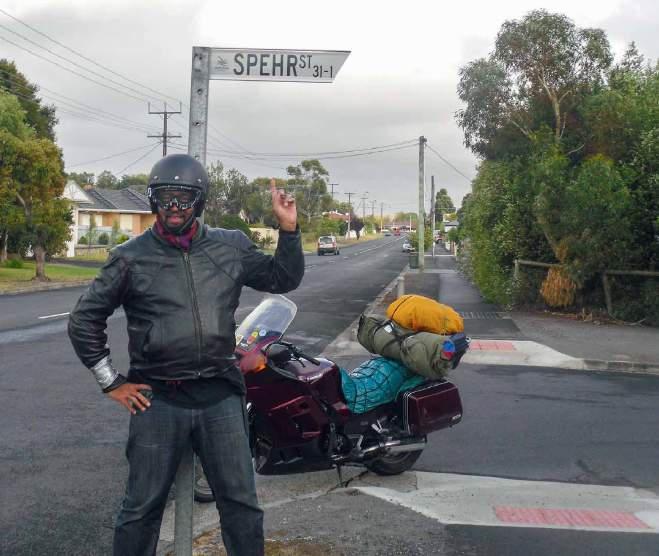
family name Spehr before realising that the street sign was the town’s number one attraction. I’d passed the even smaller town of Tantanoola a few kms back so headed back to take a look. Unbeknownst to me, Tantanloola was to become my Waterloo. If Millicent was a one-horse town, Tantanloola was definitely a half
horse town. I felt I had the hang of this whole “I can pitch a Swag anywhere” lark so I scanned its layout for a suitable place to get my head down unnoticed. I settled on the abandoned looking train station and using my bike as a fixing point for my Swag, I made best use of the daylight left and after an uneventful
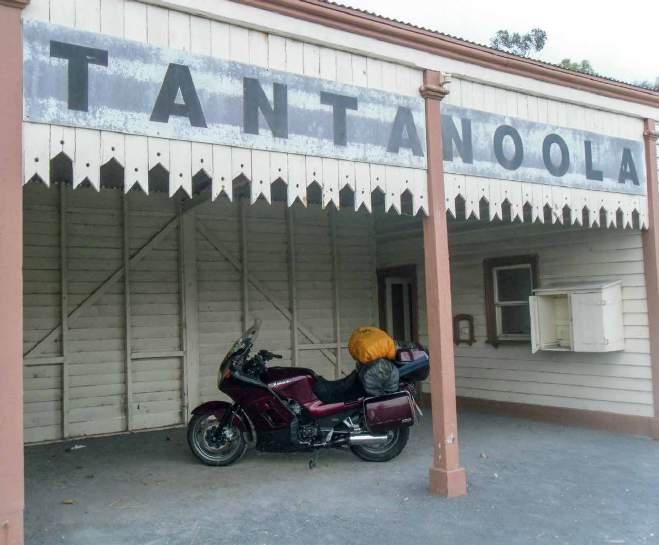

visit to the pub fell asleep.
The first crack of thunder made me jump and the drumming of rain that followed sounded even louder than the thunder. The words of the salesperson at Rays Outdoors on The Nepean Highway in Melbourne, bounced around in my head like the rain on my canvas Swag. He had promised, “This Swag is 100% waterproof”.
As any motorcyclist should know, especially one with several years under their belt as a motorcycle courier in London, there is no such thing as “100% waterproof” especially in relation to boots and gloves. As moisture turned into liquid, and then into a puddle at the foot of my Swag, I curled into a foetal position. This is no mean feat for a 6’5” 20+ stones man in a one-man Swag. As I lay awake for the remainder of the night, I resolved in future to always take a bed under a solid roof in preference to sleeping under
the stars, if the choice was offered to me.
In Robe, I stopped for an ice cream, when I came out of the ice cream parlour an older retired fella in short Khakis and a battered old Akubra was checking out my bike and we struck up a conversation about all manner of things. Motorbikes (obviously) London, Australia, what I was planning to do… Turns out Roger was on a little holiday himself, with his wife and he ended our impromptu chat by telling me they had a property near Renmark and if I was ever in the area, I was welcome to come by and stay a few nights. Taken aback by his friendliness I put his details in my pocket book and six weeks later I looked him up. Visiting Roger and his wife became one of the most memorable experiences of hospitality I have ever had, but that story is for another time…
From the sublime meeting of Roger and his wife to the ridiculous which was the experience that confronted me next.


Left: Sure it’s 100% waterproof.
Above: The Big Lobster is a tourist attraction located in the town of Kingston SE, South Australia. Below left & below: Not your average street signs.
I stopped at a small town, the name of which I thankfully have forgotten and upon arriving I pulled into a pub looking for a quick bite to eat. As I ordered, a young woman with a fella and a six- or seven-year-old boy walked past me at the bar. Out of my peripheral vision I caught a glimpse of an image so bizarre that my mind dismissed it as something impossible. When I went into the garden to choose a table and wait for my food, I sat about ten feet from the woman. Well, the image I had thought I had seen was real, I had not made a mistake. Upon the upper arm of the woman was a full portrait of an arm crossed, uniform wearing, swastika armband toting, Adolf Hitler. I was stunned into inaction. I sat and did nothing but stare in disbelief. My food came, I ate, and then I left. Obviously, this played on my mind, I thought of all the things I could have said, or done to express my disgust, my favourite was to go and compliment her and ask for a picture so I could have recorded it and then shared it far and wide. The incident reminded me of a
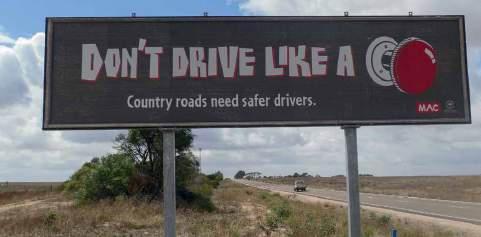
story my mother told me of her father who, having survived concentration camps in World War Two, once saw a skinhead with a swastika in Melbourne’s Queen Victoria Market where he and his surviving brothers had a fruit & veg stall. Legend has it that my elderly Grandfather marched over to the guy and with the pocket knife he always carried, grabbed his jacket and cut off the offending symbol. The guy bottled it and ran off. This at least, made me smile.
Towards the end of the day, I pulled up at the Pioneer Village of Old Tailem Town, for a serious fix of Grade A Australiana, ramshackle buildings, railway carriages, cacti gardens and various rusting farm equipment. A very friendly lady took my phone number in lieu of an entrance fee introducing me to some more South Australian hospitality. Upon leaving there, I finally approached the outskirts of Adelaide. If you are familiar with the ride into Adelaide, you may know there is a long winding dual carriageway that is fairly steep. When you add to the mix a tired biker, an over laden bike, a cross wind and a slippery surface…progress can be a bit hairy. I was relieved to get to the bottom where not far away was Phil’s brother, Tim waiting for me in a pub with a very cold schooner of Coopers Stout.
In the near future were more biking adventures, great characters, and friends to make to make as I explored in and around Adelaide, the Hills and slightly further afield. For now, I was happy to yarn with Tim, sip my beer and rest up.

Below & bottom: The Pioneer Village of Old Tailem Town.
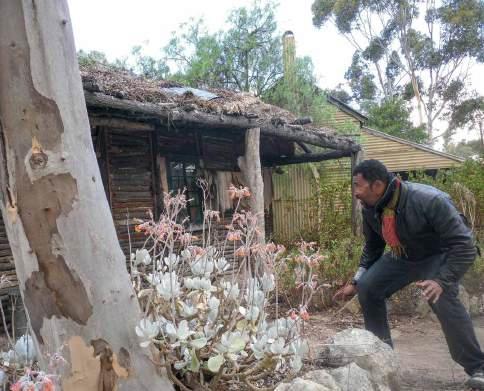
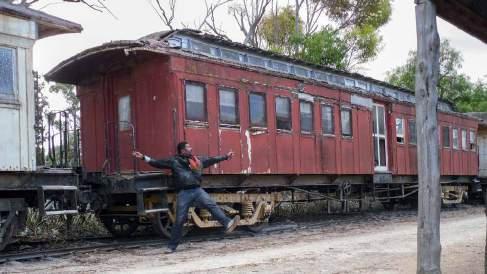
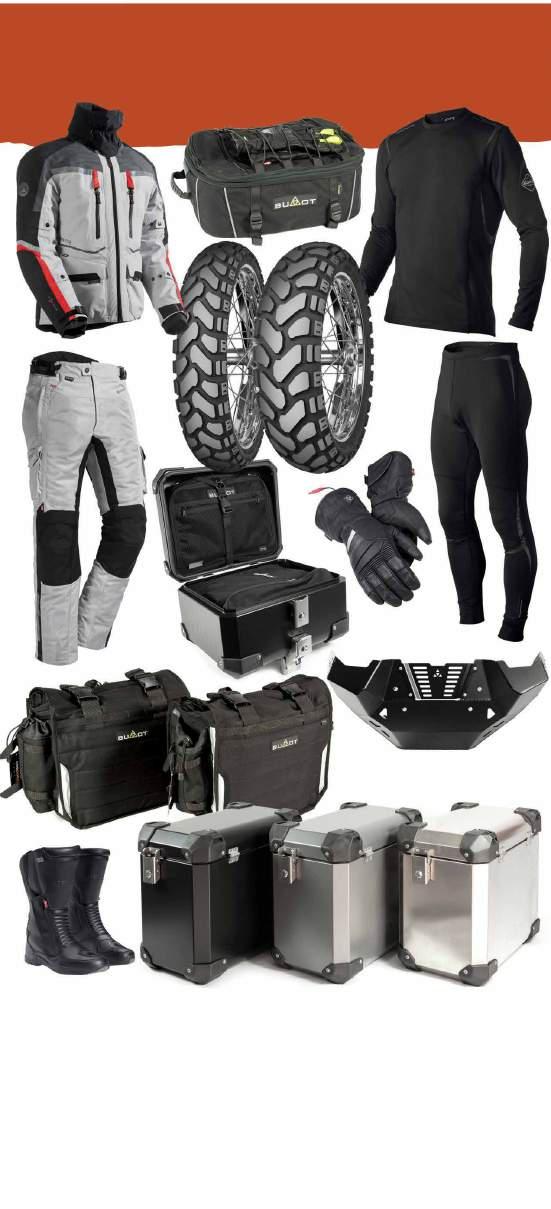













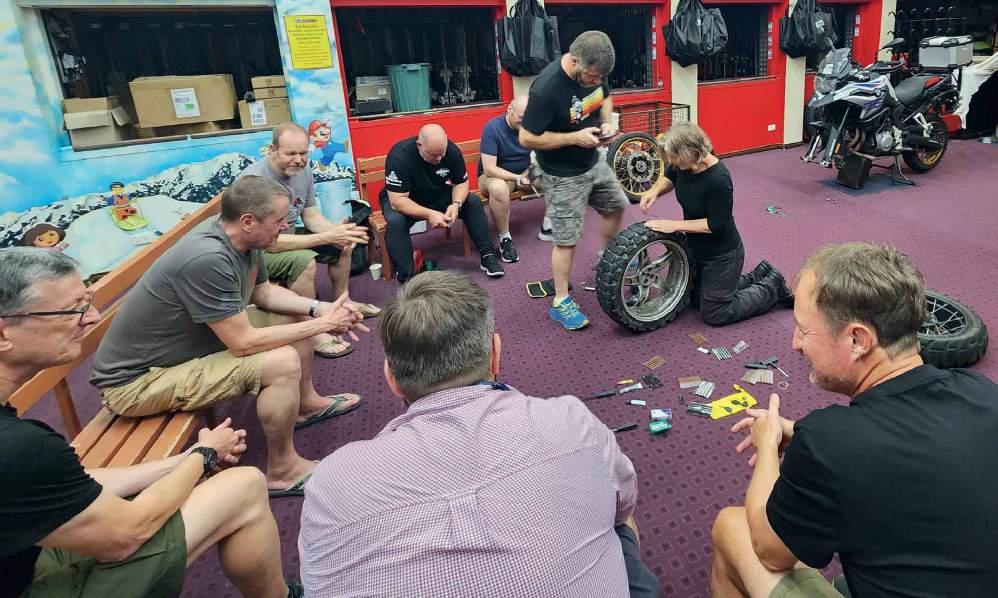
I’ve never had any rider training; neither on or off road. I started riding motorcycles aged eight years on a sheep station in outback South Australia. Back then it was a Honda Z50. Later, working in Kakadu, it was a Honda XL185 and soon after a Yamaha XT250. This was later superseded by my beloved Yamaha TT600, which I rode through Africa, couriered on in London and rode home via Central Asia: a world motorcycle adventure from 1993 to 1997. Since then, I’ve been a road rider with my present ride a Triumph Thruxton. There’s been no off-road riding since 1997 when I ended my travels in Vietnam. Life moved in a different direction and my TT600 sat in my shed waiting… patiently. So when, by chance, I came across Simon Pavey’s Off Road Skills course and saw their 2023 course was in Mansfield, just up the road from me, it was perfect timing. And even more so as my TT600 is booked in for its rebuild with Just Dirt Bikes in Derrimut, Victoria, who are flat out rebuilding old model big thumpers like mine.
Simon Pavey is one of the world’s most experienced off road motorcycle riders and a renowned Dakar Rally racer. In recent years he’s been teaching offroad riding skills through Off Road Skills (based in the UK), which partnered with
a
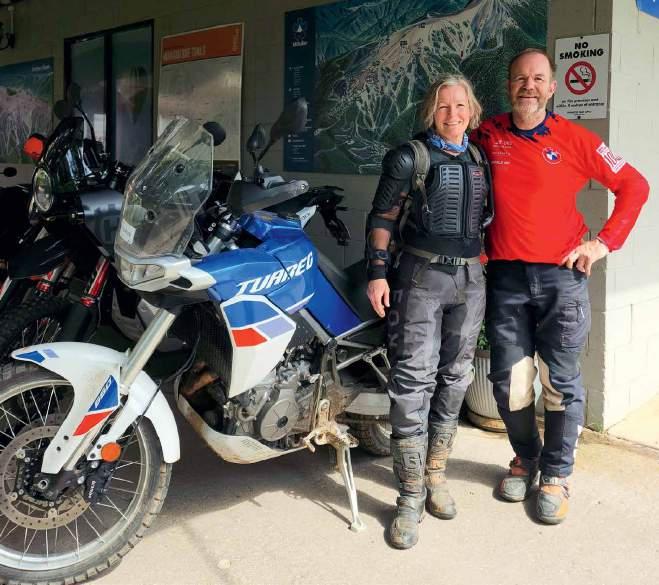
world motorcycle tour operator Compass Expeditions (based in Melbourne) to run the course down under each year. For 2023, it was a sheep farm and state forest trails near Mansfield with the option for riders to join a five-day ride-out with Simon and his team of instructors deep into the wilderness of the Victorian and NSW high country.
To refresh my maintenance skills (it’s been 27 years since I used a set of tyre leavers!), I also booked the optional Adventure Riding Maintenance workshop run the day before the Off-Road Skills course. Before my travels, I pretty much had no mechanical knowledge but armed with my tools and the bike’s workshop manual, I did a few road-side repairs plus regular servicing. Simon Pavey’s maintenance workshop was very much hands on and, for a novice, would give you the confidence to change brake pads, fix a tubeless puncture and you’d learn how to use tyre leavers. Simon and his team also covered what tools (only those unique to your bike), and what equipment to carry, including the must have metal weld for fixing a cracked crankcase and leavers. This came in handy on the Aprilia Tuareg as leaver protectors are not standard issue. Yes, you could watch a few You Tube videos or study your bike’s workshop manual but there’s a lot to be said for doing a confidence-building, hands-on maintenance workshop.
For the Off-Road Skills course, I had the use of Aprilia’s Tuareg 660. I’ve already gone into detail about how FOPFD I was with this bike in my review. And while I began the first day rather nervous about how ‘off-road’ things would get, I breathed a sigh when all the course newbies, like me, were in Level 1 with Sarah Taylor and Sam Davidson as our instructors. The newbies included 10 of us with the other 11 riders having done Simon Pavey’s course before. They were placed in either Level 2. For some, the course was their third or fourth and for one guy, it was his seventh.
As well as the Aprilia Tuareg 660, the line-up of adventure bikes were mostly a mix of BMW GSs 850s and 1200s plus two KLR650s, a KTM 890, a KTM 690 and a Norden 901.
The first day started with mastering the lifting technique followed by clutch and braking control. With most adventure bikes being over 200kg, this was a two-person lift. However, my lifting
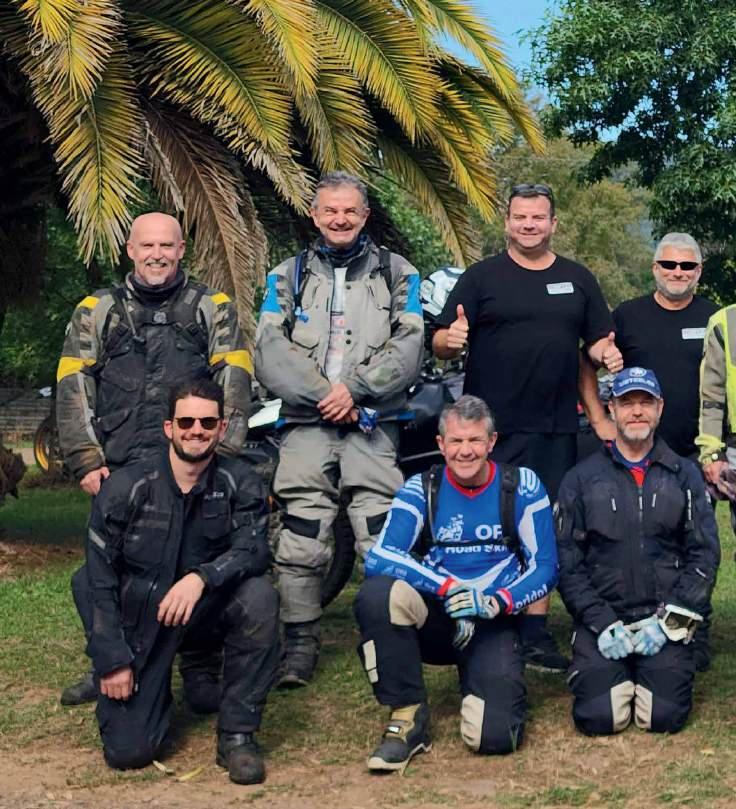
Above: The 2023 Off Road Skills riders and instructors. Who will be back next year?
Below: Practicing downhill clutch control, braking and steep descent stopping, which did not end well for me and the Tuareg.
Right: The 21 riders were split into two groups: Level One and Level Two for riders who’d completed the course in previous years.



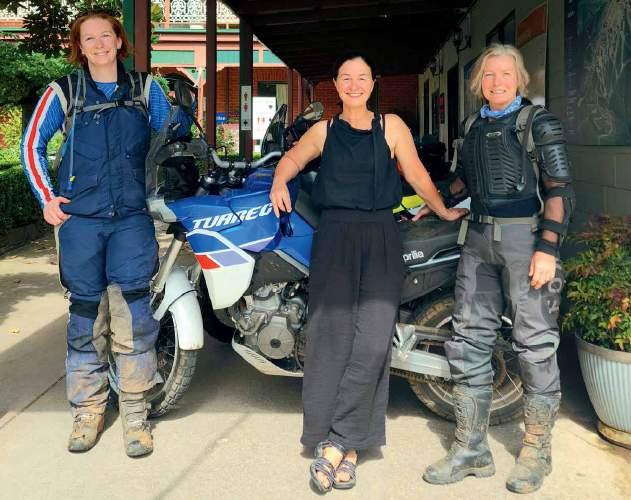
For Fiona David, 52, from Canberra, the 2023 Simon Pavey Off Road Skills Course was her third. Fiona has been a ’weekend’ motorcyclist for 21 years. Her first adventure motorcycle trip was 2010 on her BMW F650 GS with husband Jake, when they rode from Perth to Darwin including the Gibb River Road. Today, Fiona rides the 750 GS. Her only off-road training back then was a BMW off-road course. However, after completing her first Simon Pavey Off Road Skills course in late 2010, she was an instant convert. So why does Fiona, like half the other riders, keep coming back?
Fiona who is 161cm rides her BMW 750 GS with ease. And it’s a confidence she says comes from a combination of the bike’s low centre of gravity, off road training plus practice and having the 750 GS factory lowered to a seat height of 770mm.
Fiona recommends all riders do Simon Pavey’s Off Road Skills course and the five day ride out.
‘The ride-out is hugely valuable as you get to put the skills you’ve learnt over the weekend into practice with Simon. He’s pointing out things the whole time on how to improve. It’s five days to practice and embed all the skills you’ve learnt,’ she adds.
Fiona says she keeps coming back as each time she will advance to the next level and this not only improves her off-road riding skills, but also gives her the confidence to ride in countries like Morocco, where damaged roads, pot holes and road works are part of ‘road riding’.
‘When I first started riding off-road, I really lacked the confidence and each year I come back, I’m a better rider on dirt and this is a skill everyone should have,’ Fiona adds.
Fiona says the shorter you are the more riding skill you need.
‘The taller guys can muscle their way around riding the bike on dirt, but a lot of women don’t have the height and strength to do this. We need to be good at off-road riding, even if it’s just navigating bad roads and road works,’ she says.
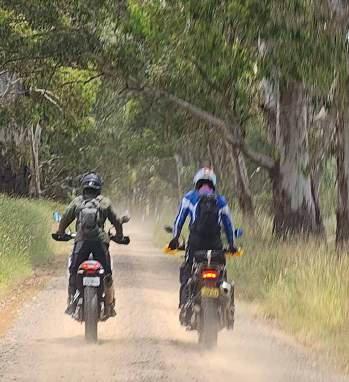
Above: Having never ridden standing up, I needed a bit of one-on-one instruction.
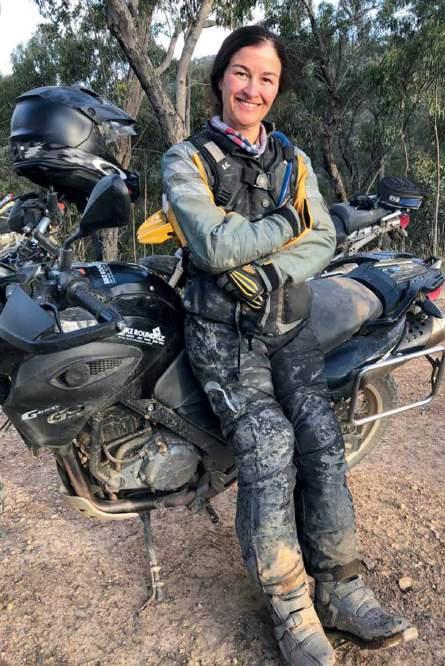
partner advised I’d taken most of the weight of the BMW GS 1200 so technique does work! And it was a technique I got to practise with the Tuareg on a few occasions over the weekend on my first attempt at tight turns and stopping on steep hill descents. For shorter riders, seat height to weight ratio on any motorcycle, I believe, is critical to avoid a topple. However, Simon Pavey repeatedly told me that perfecting my off-road riding skills would make the height and the weight of the Tuareg irrelevant. Maybe I need to another course or two, before I’m convinced.
With no off-road training, I’d never ridden standing up and this concept was totally foreign. Through mud, sand and over rocks on my world adventure travels, it was always sitting down. But with some one-on-one instruction from Sam Davidson, by the end of the weekend, I was blasting along the trails in the forested hills near Mansfield.
In learning the art of tight turns, my first attempt on the Tuareg did not end well. But I climbed back on and with a few more goes, I had my ‘aha’ moment. It was a skill that we practiced numerous times on the trails and with my new found confidence, I felt I’d nailed it. The next step would be just to get out there and practise. Off Road Skills also offer an online course ‘Off Road Skills Learning World’. The basic course is free. If online learning works for you, there is a premium section with a subscription fee where you get feedback from the instructors. You also join a community of riders and can attend weekly Zoom meetings and webinars as well as access to new practice drills.
Unlike many other off roads skills courses out there, the Simon Pavey course is run in conjunction with an optional five-day ride out where you get to practise all those skills acquired over the weekend in some of Australia’s stunning wilderness regions only accessible off road. For 2023, the ride out was deep into the Victorian and NSW high country with the 21 riders spilt into three groups. For December 2024, the course and ride out will be in Tasmania. Riders have the option of doing just the ride out or combining it with the off-road skills course.


www.compassexpeditions.com and www.offroadskills.com

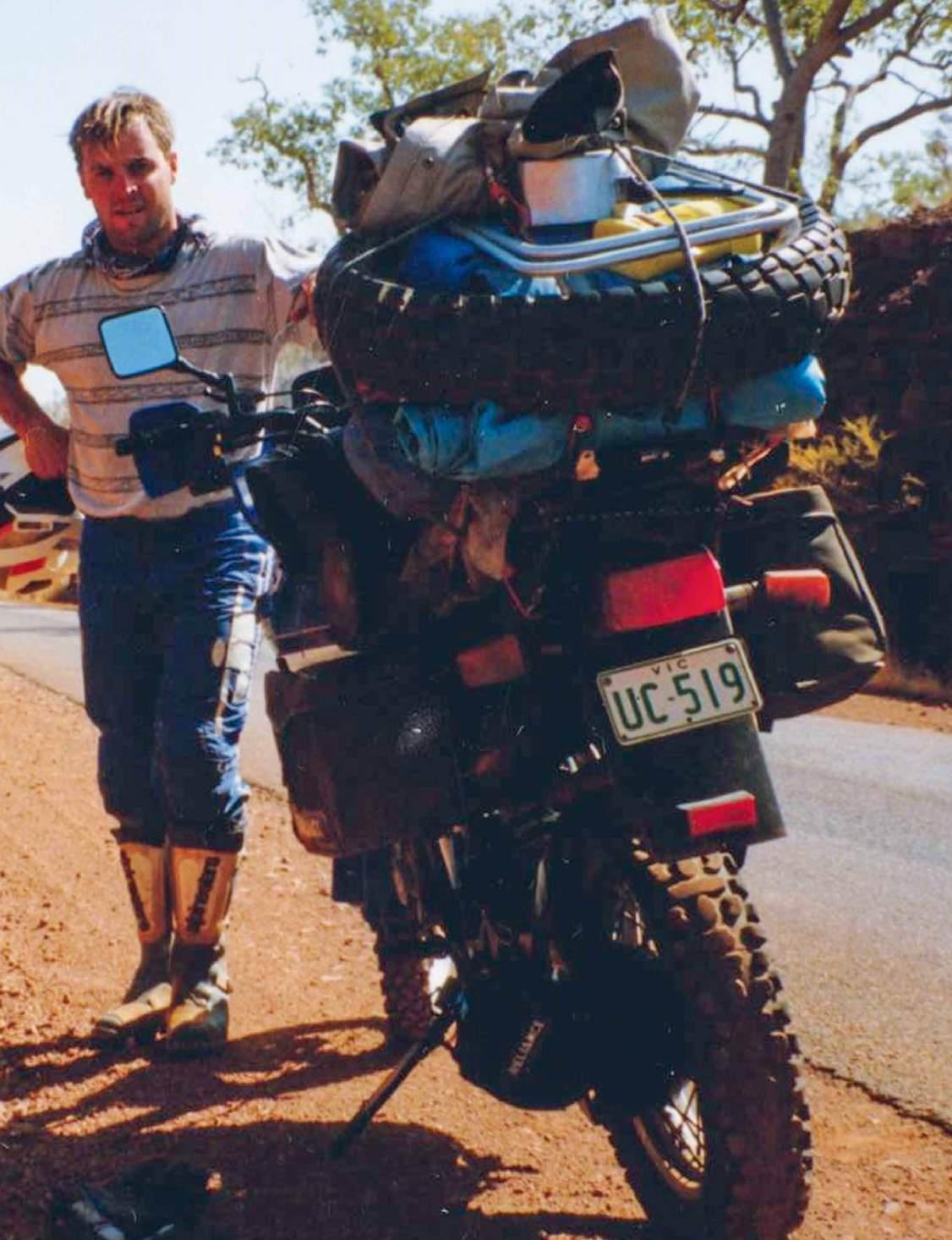

Above: Taking a break and admiring my bike at the entrance to Gregory National Park Northern Territory. Below left: Down again and this time it hurt! Below right: Travelling solo again the road is long, and it’s a milestone for a Victorian to enter Western Australia.
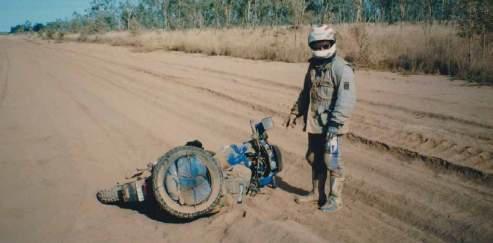
For motorcycle enthusiasts, the thrill of adventure is not just a fleeting experience on the open road – it’s a lifestyle that evolves with each bike, each journey, and each passing year. My first big adventure was to ride a DR650RS 1990 model around Australia in 1992. I was 26 at the time and it had been on my bucket list since I was very young. Six months later, I repeated the trip, visiting places I missed the first time. I have held a passion for adventure bikes ever since and it’s amazing how the pastime of adventure riding has literally exploded over the past two or so decades. Motorcycling has given me many great memories; many broken bones and I have lost a lot of skin! It’s all part of it! If you have been thinking about doing a big trip, my advice is to do it. Make it happen. Life is short!
Below: On Cape York my rear subframe failed out on the track due to the combination of rough tracks and too much weight on the rear rack. After some temporary bush repairs, I limped into Coen and thankfully a mechanic was able to weld new supports, they were super strong.
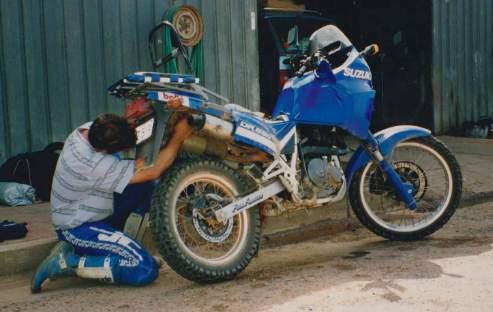
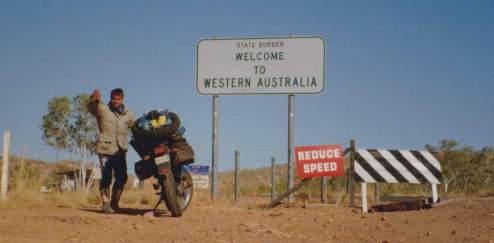
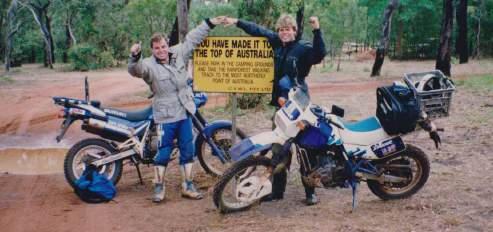
Above: When you travel you meet likeminded people. I was lucky to meet Fred from Holland. He was on a Suzuki DR 650 Dakar. We travelled together for about a month, went to Cape York and become close friends. He was a tough son of a gun. He hit a kangaroo up in the Gulf of Carpentaria and unfortunately the kangaroo did not survive this run in with Fred from Holland!
Below I started the trip staying in caravan parks, but after a while we would just ride into the bush from the road, and we wouldn’t even bother putting up the tent. The stars in remote Australia are mind blowing. What’s better than to fall asleep beside a campfire under the stars?

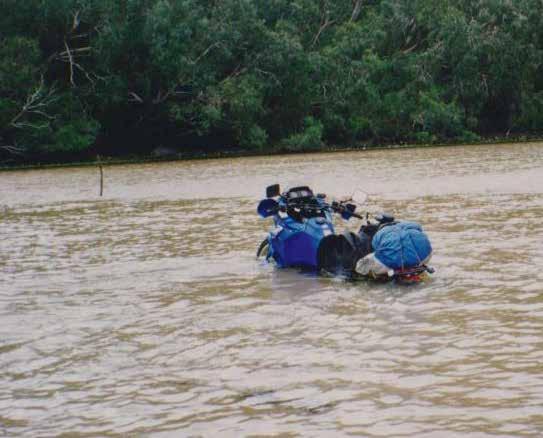
Above: The Jardine River. We heard there was a hard way and an easy way to cross the crocodile infested Jardine River near Bamaga on Cape York. So of course, we decided to go the hard way. The picture tells the story; however, the picture doesn’t tell the full story. It started raining heavily. It took us four hours to get the bike out, dewatered and running again. The evening ended with a ‘two scruffy dudes walk in the pub, pub goes silent’ scenario at Bamaga. Needless to say we came back across on the ferry on our return trip.
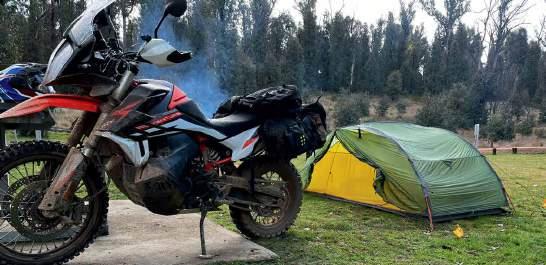

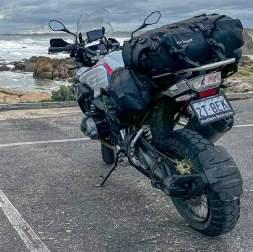
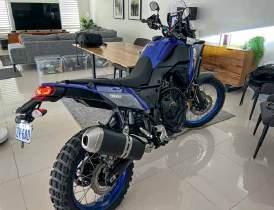

Over the past 45 years, I’ve embarked on an extraordinary two-wheeled odyssey, owning a total of 20 big adventure motorcycles and numerous enduro bikes in the last 20 years alone! This includes 11 BMW GS motorcycles.
Each motorcycle was chosen with a specific purpose, whether it’s conquering rocky off-road trails, tackling long-distance touring, or mastering the twists and turns of mountainous roads. Riding different types and brands of adventure bikes has honed my abilities on varied terrains and enriched my understanding of motorcycle dynamics. Each motorcycle I have owned has its own story – a chapter in the book of my life’s adventures. From camping under starlit skies to navigating through challenging terrains, every ride has left an indelible mark on my memory, creating a mosaic of experiences that define my love for adventure riding.
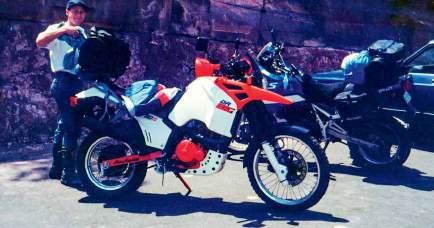

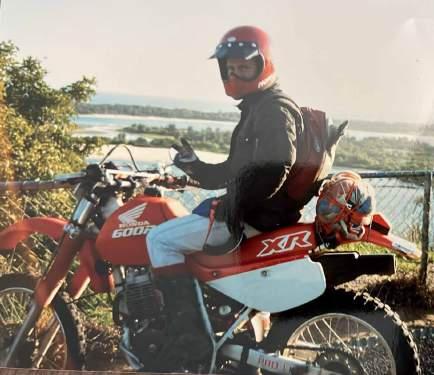
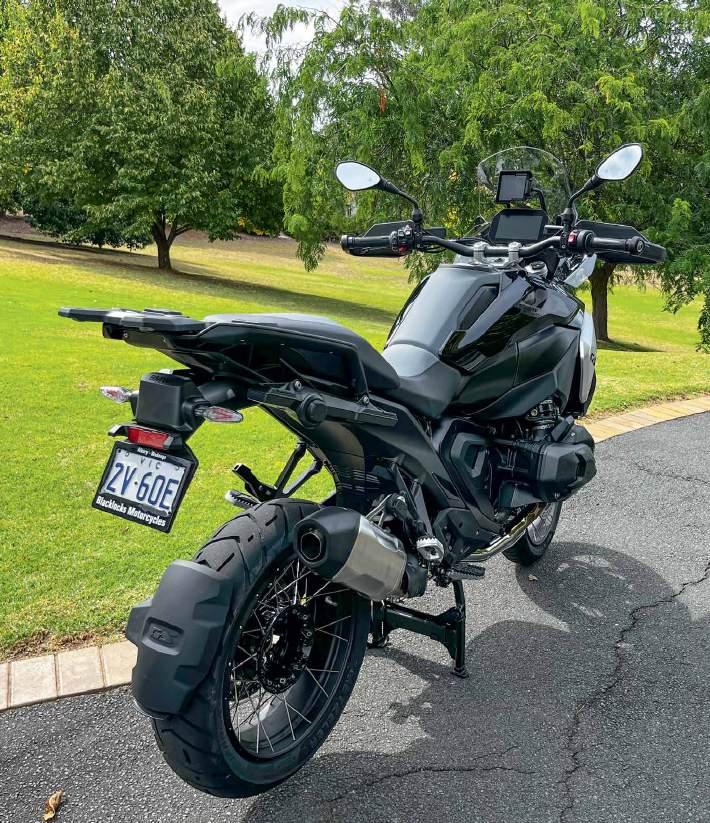
Over the years, adventure motorcycles have undergone a remarkable evolution, transcending conventional boundaries with cutting-edge technology, new models, innovative features, and design trends. Modern advancements include
adaptive cruise control, electronic suspension systems, and state-of-the-art navigation interfaces. These motorcycles have become a synthesis of raw off-road capability and refined on-road performance. Adapting to these changes has been an

exciting part of the journey, as each new acquisition brought with it the promise of fresh experiences and uncharted territories. I have never been able to understand people who go through their lives loyal to just one brand. They are missing out on so much! If I see a beautiful motorcycle, I will desire it. Doesn’t matter which brand it is. Now I admit however most of my bike adventure bikes I have owned in the past have been BMW and KTM. And my enduro bikes have been KTM and Yamaha. It doesn’t matter to me I just look for the bike that will suit my needs and desires! After you read this article, I urge you to go into a BMW dealership, find a quiet spot, and just look at this new GS. Study it from every angle. It is truly a thing of beauty. It is not only beautiful, but it also has the mystique that comes with being the world’s most popular adventure bike, many years of heritage that has accumulated and been refined over four decades and began with the R 80 G/S. And speaking of refining and perfecting a motorcycle over four decades, imagine what we would have if Suzuki had refined and perfected the DR650 over the past four decades? Or even the DR400?
Now, for some lucky GS riders, its decision time! Visiting the BMW dealership (again) to admire the beautiful curves of this magnificent work of art they call the BMW R GS 1300. And it is a sight to behold! Pure beauty from every angle! To upgrade or not to upgrade? Stay tuned for the answer at the end of this article. I was provided with a beautiful BMW R GS 1300 Triple Black for the weekend just passed, for the purpose of this article. The only instructions from the dealer was, “enjoy!”
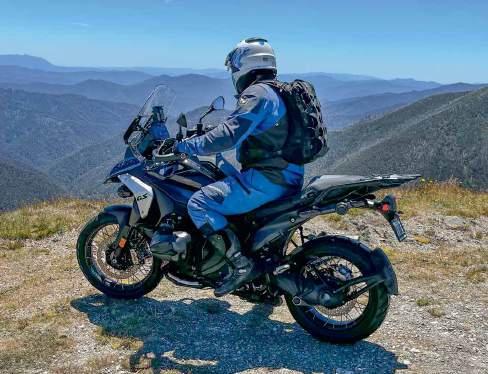
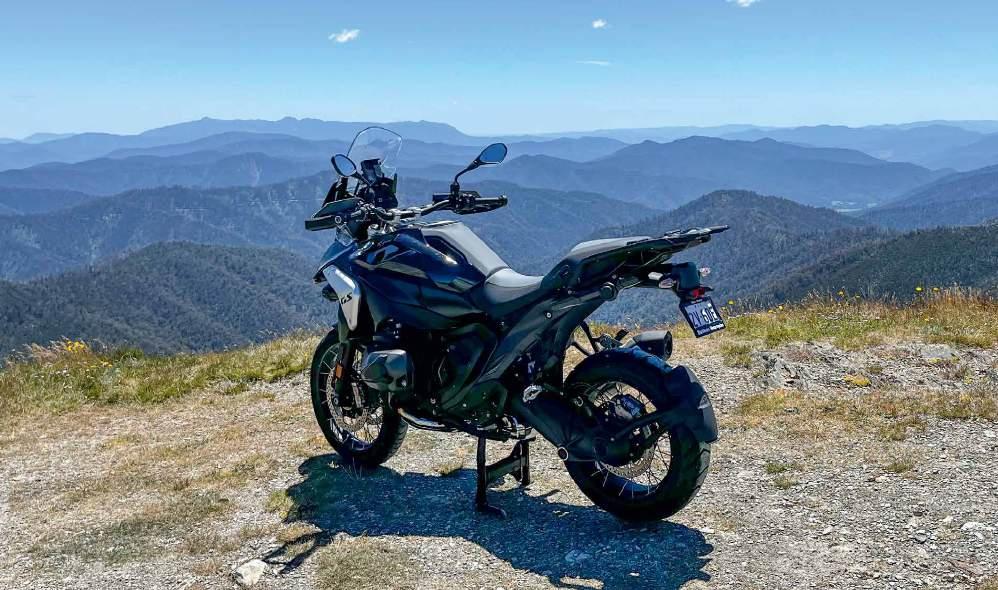
This latest offering from BMW Motorrad, the R 1300 GS, elevates the GS experience and adventure bikes in general, to the next level. This adventure touring motorcycle introduces an almost entirely new design, featuring a revolutionary boxer engine and revamped suspension, resulting in a significant weight reduction over its predecessor.
At the heart of the R 1300 GS is the legendary two-cylinder boxer engine, which is now more compact due to a redesigned gearbox placement and camshaft drive arrangement. BMW say it is the most powerful BMW boxer engine in series production to date. My trip on the R GS 1300 Triple Black took me from Wodonga to Mount Beauty, over Fallscreek to Omeo (shout out to the Crazy Cow) then back over Mount Hotham. Some of the most prime riding in Australia! Miles and miles of twisties!
In this article I will attempt convey my thoughts for someone who has spent thousands of hours riding GS, and as my last bike was a 2022 R 1250 GS Rallye, an excellent comparison. While this bike is substantially different, it feels very familiar. Having spent 3 days riding the R GS 1300 there is a noticeable difference. And when I say difference, I mean improvement. First, the bike feels lighter, smaller, more responsive, and nimbler in the tight corners. The power delivery on this new GS compared to its predecessor is smoother, more refined, and yes it feels faster. Of course, there has always been awesome acceleration on the GS, and it continues right through the rev range, smooth, not scary, but addictive. And the braking has improved significantly. I got off the bike at one stage and said to a mate that I could not put my finger on it, I was thoroughly enjoying the ride; it was
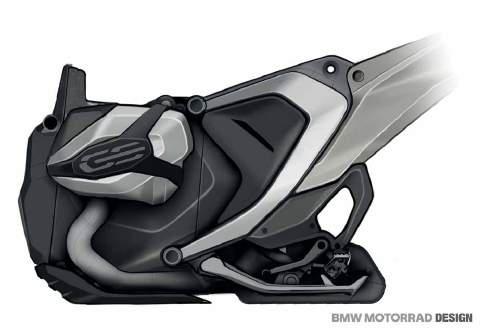
such a pleasure. Was it the bike? Was it the fact I love riding? His response was it was likely a combination. Good answer.
BMW has earned a reputation for incorporating state-of-the-art technology into their motorcycles. The R GS 1300 is equipped with the latest advancements in rider aids, electronics, and connectivity, including features like adaptive cruise control, enhanced suspension systems, and an advanced navigation system. For me, safety innovations take centre stage with the new Riding Assistant option, incorporating Active Cruise Control, Front Collision Warning, and Lane Change Warning. These features provide a safer and more convenient riding experience for us older guys.
These upgrades contribute significantly

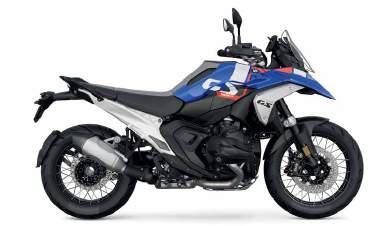
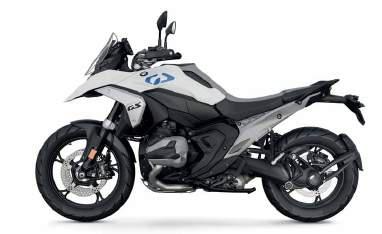

to an elevated riding experience. During a bustling Sunday morning on the road to Fallscreek, encountering cyclists, slow vehicles, or road works around corners is common. Here, the advanced technology and rider aids of the GS 1300 prove invaluable in maintaining safety and control.
The R GS 1300 offers improvements in rider and passenger comfort, such as a
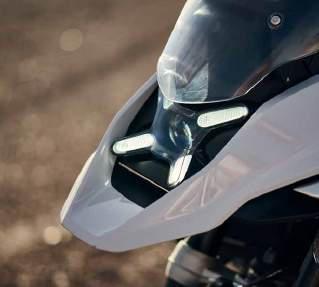
redesigned seat, adjustable windscreen, and optimized riding position. I am a big fan of this seat, not only in comfort but in looks. How it flows seamlessly into the tank. And about the seat, with the optional adaptive vehicle height control, the new R 1300 GS offers fully automatic adjustment of the seat height depending on the operating condition, thereby ensuring the greatest possible comfort without having to compromise on riding dynamics and banking freedom. And for many this is a game changer. The bike lowers when you slow down to stop, allowing you to place your feet on the ground with confidence. Good for the more vertically challenged, those who would not normally consider a GS have been catered to.
The adjustable windscreen was a revelation for me. It became very useful to the point I wondered how I have done without it. For instance, on the open longer straights between Mount Beauty and Wodonga, I could raise the screen with the touch of a button, to give me protection form the wind and the variety of extra-large bugs that seem to reside in that region. Then, once we were on the road above Mount Beauty on route to Fallscreek, I could lower the screen with the toggle switch beside my left thumb to give me a better field of view when I needed it for the tight twisties and hazards such as cyclists and slow traffic. This set the theme for the ride, and I used this feature throughout the day as we travelled through the different terrain and environments. Additionally, the power assisted centre stand, how on earth did I ever live without this feature? Did you know that the headlights shine around corners ahead? If you have ever been caught out on Australian roads at night you will certainly appreciate this technology. The Matrix LED headlamps
As per BMW, the Matrix LED headlamps come with an innovative design as the standard feature, featuring cutting-edge LED light units all around. The turn indicators are seamlessly integrated into the hand protectors, and the Headlight Pro is available as an optional factory-installed accessory. The newly introduced R 1300 GS boasts a compact full LED headlamp as a standard feature, characterized by a unique and distinctive light icon. This illumination provides an unprecedented clarity on the road, ensuring enhanced visibility in traffic. The headlamp comprises two LED units for low and high beams,

and the optional “Headlight Pro” that adapts the beam to the banking position for improved visibility during turns.
The latest chassis has been artfully crafted, it is stronger and lighter. The new sheet metal main frame is the centrepiece of the revamped suspension. This component is constructed from steel, optimized for installation space, and exhibits heightened stiffness compared to its predecessor. Additionally, the rear frame has transitioned from a tubular steel structure to a die-cast aluminium construction. The suspension system has undergone a significant transformation, now has adaptive damping capable of dynamically adjusting to changing road conditions, ensuring a peak balance of comfort and control. The impact of these enhancements is very evident, with the bike exuding a sense of compactness, nimbleness, agility, and sportiness, especially evident in tight turns and directional changes. The bike feels so much smaller, lighter and is inherently better in the corners, particularly tight corners. And for long day rides such as this, you are continuously flicking and leaning the bike from side to side, for long periods and a lighter bike substantially reduces rider fatigue.
accompanied by four additional LED units for the daytime running light and side light. The state-of-the-art LED light units also include newly designed LED turn indicators, integrated into the front hand protectors and seamlessly incorporated at the rear, completing the lighting concept of the R 1300 GS. Opting for the “Headlight Pro” optional equipment enables the standard full LED headlamp to dynamically adjust its beam according to the banking position during turns. This innovative feature ensures nearly complete illumination of the bend, directing light towards the motorcycle’s path.

A groundbreaking addition to the R GS 1300 is the introduction of adaptive cruise control. This intelligent system allows riders to set a preferred cruising speed while automatically adjusting to maintain a safe following distance from other vehicles. This feature can be used to set the desired riding speed as well as the distance to the vehicle in front.
Lane Change Warning monitors the lanes to the left and right and can help ensure a safe lane change while supporting use of the rear mirror.
Front Collision Warning with brake intervention is designed to prevent collisions and help reduce the severity of accidents.
The R 1300 GS comes in various model variants, each offering a distinct aesthetic
and technical appeal and the R 1300 GS lineup caters to a diverse range of rider preferences.
Whether driven by the quest for more power, cutting-edge technology, enhanced comfort, updated aesthetics, or a combination of these factors, the R GS 1300 presents a compelling case for riders seeking the pinnacle of adventure touring. As you weigh the pros and cons, consider how each aspect aligns with your riding aspirations and whether the allure of the R GS 1300 is enough to elevate your adventures to the next level. For me? Yes, I have ordered a new R GS 1300 Trophy. An article for the Trophy will be coming next as it is an off-road focussed version of the GS, more suited t o the majority of my riding currently.
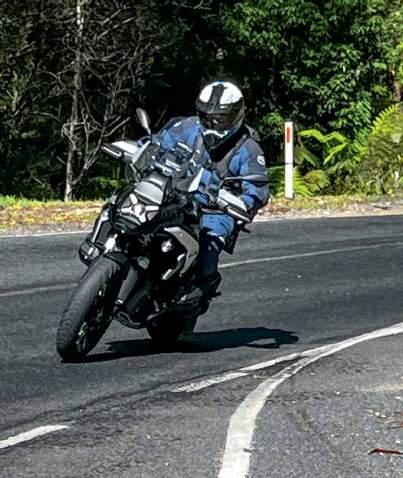
And in summary, the BMW R GS 1300 not only surpasses its predecessor in terms of power, technology, and comfort but also sets a new benchmark for the adventure touring segment. I will use this analogy, when I first got on the new GS 1300, and during the ride, I felt like I was with an old friend. I have spent literally thousands of hours on GS of different variants. This bike felt very familiar. However, the difference felt to me like my old friend had been to the gym. Has been working out. He was leaner, smaller, tighter, stronger, and more powerful. Smarter.
Shout out to Aidan Robertson at Blacklocks Motorcycles in Lavington for providing the beautiful R GS 1300 Triple Black used for this review.


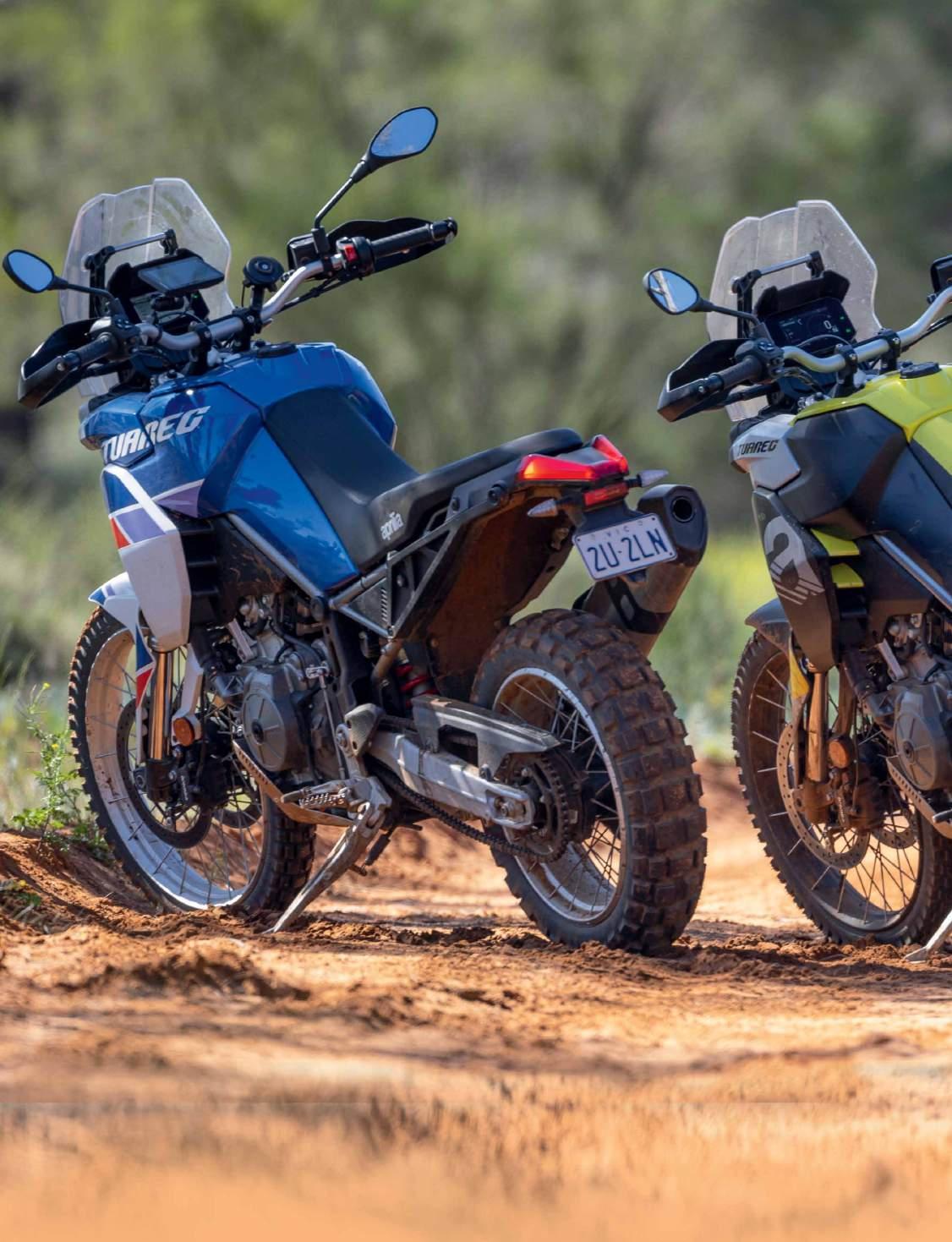
just want to have fun…

’m FOPFD’, was all I could think when I picked up the Aprilia Tuareg 660 from PS Importers in Melbourne. FOPFD was the acronym (Fear Of Putting Foot Down), I coined when I laid eyes on this new breed of mid-sized adventure motorcycle. PS Importers had kindly given me use of the Tuareg (pronounced twaa-reg), for Simon Pavey’s Off Road Skills course run in partnership with Compass Expeditions. The 2023 course was held near Mansfield, Victoria in early December.
The Tuareg is not a high bike. It’s just I’m on the shorter side of average at 165cm. Its seat height is 860mm: the lowest of the mid-range modern adventure bikes and sits 2cm lower (I know, not much) than its rivals. The Tuareg, at 204kg wet, is also the lightest by more than 20kgs than the current ‘rather heavy’ bikes in the same class.
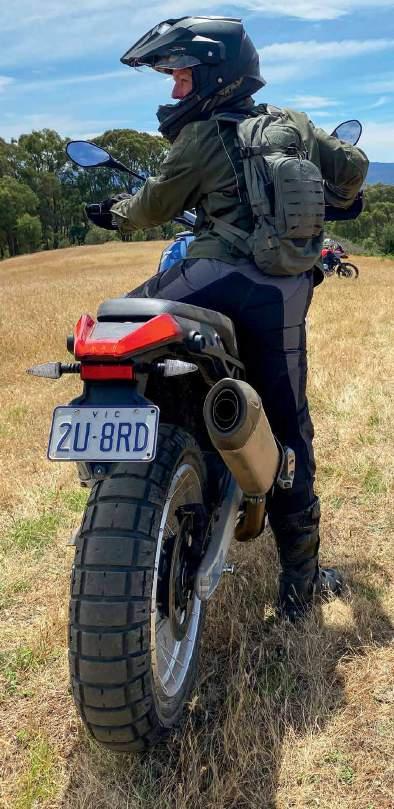
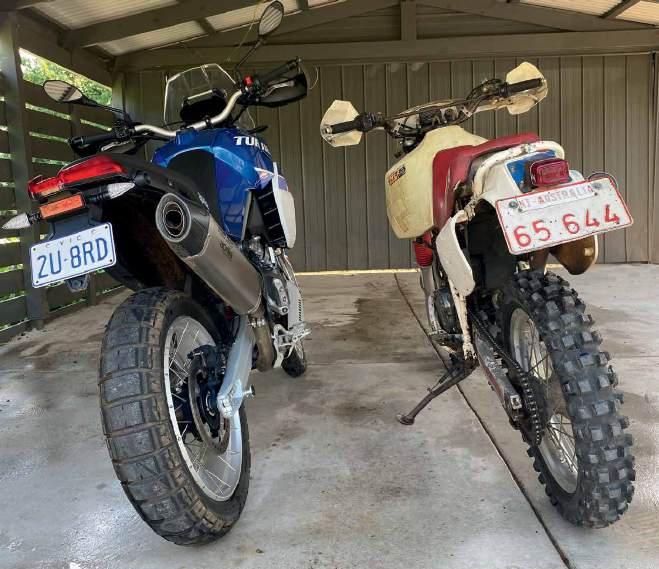
In their blurb, Aprilia even describe the Tuareg 660, (LAMS approved) as: ‘the most advanced, engaging and off-road-capable adventure bike for learner riders’. Maybe for tall learner riders but the Tuareg’s compact and narrow engine and slim-line seat does keep your legs in close to the bike which makes it easier for most riders to touch the ground. The low scalloped seat curve helps too, but I still had to plan my stops and be ready to quickly slip a bum cheek off the seat. I expect familiarity with the Tuareg and the off-road skills I gained from Simon and his team, would make this automatic, but I only had the bike for a long weekend.
So once I’d gotten over being FOPFD, I cautiously, at first, rode the Tuareg the 90kms home to the Yarra Valley before the ride to Mansfield early the next morning. I quickly discovered the Tuareg is so exceptionally well balanced that I could idle at traffic lights at almost a complete stop. Filtering through traffic was a breeze, and being a former London motorcycle courier, I quickly assessed the Tuareg’s higher upright riding position and handlebars gave me a distinct advantage in those tight gaps. The Tuareg
would make a great commuter with ‘huge fun factor’.
Reading the tech that evening, all was revealed about the magic behind the Tuareg’s low centre of gravity. The air filter sits high above the fuel tank, which is narrow and runs down part way under the seat. And the 2024 Tuareg, available in July, comes with an upgraded air filter to even better protect the engine from dust. This is the only new addition from the 2023 model. The Tuareg also has this super-doper cooling fan that comes on virtually every time you stop. But it was 35C+ over the weekend in Mansfield. Of the other 21 riders on the course, none had bikes with a fancy high tech ‘rather loud’ cooling fan. Personally, I loved it because the engine has an additional level of protection. However, I think the guys found it all a bit tedious having to wait for the Tuareg to do its thing as the instructor could not be heard until its whirring had stopped.
And that seat. Ouch! It is not comfortable contrary to what all the Tuareg reviews I’ve read online have said. On that 90km ride home, I was grimacing by the time I reached the Yarra Valley. It was only
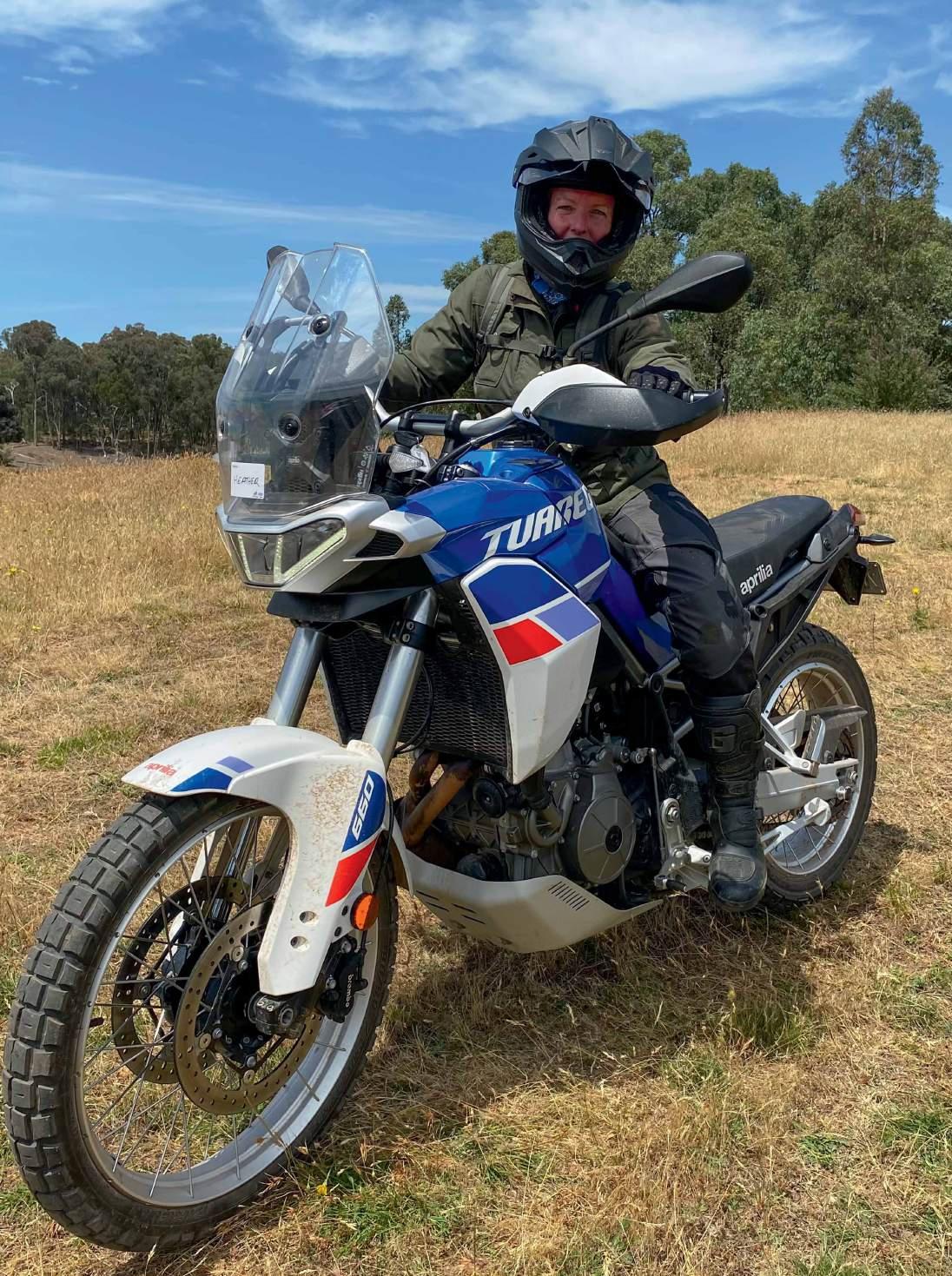
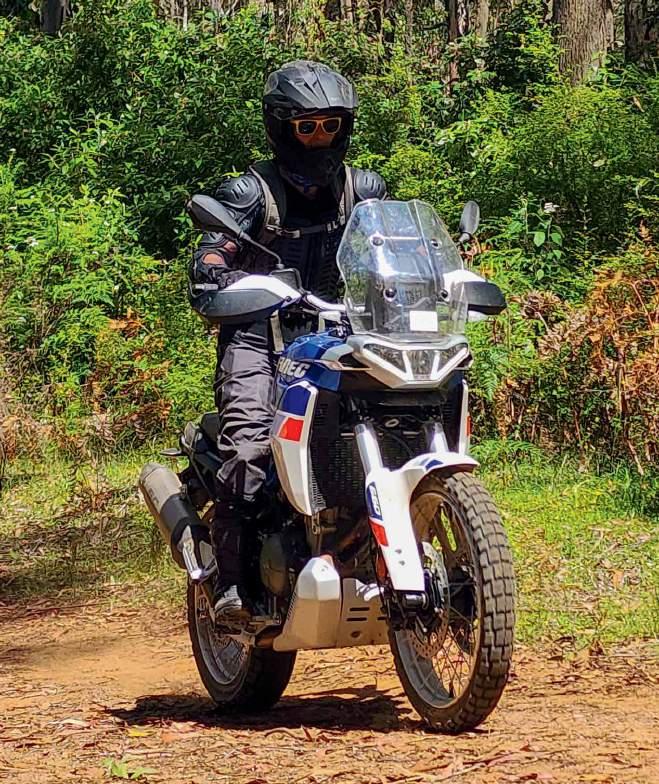

when I had the chance to open the throttle and blat through the gears, combined with the Tuareg’s deep throaty exhaust, that I forgot the butt ache. On those long rides on tarmac before reaching the dirt where I’d then be standing up a fair bit of the time, this could easily be fixed with a removable air cushion.
Leaving home early next morning for Mansfield for the optional maintenance day before Simon Pavey’s Off Road Skills course over the weekend, I headed up a Black Spur. Devoid of traffic, I could step it out and the Tuareg relished in its freedom. It took to the corners as easily as my Triumph Thruxton. As a 660 it feels like a 900; it gets up and goes. With the Tuareg’s standard issue Pirelli Scorpion Rally tyres, there was no vibration on the tarmac. Just a smooth ride as I laid into each bend. Over the weekend, while we didn’t encounter any mud, the tyres had great traction over gravel and rocks as we rode the trails. The Kayaba (KYB) suspension soaked up the bumps and with a bit of adjustment for my 65kgs combined with an improvement in my own standing position, there would be none of the light bounciness I had experienced zipping up some of the more rock-strewn hills during the two-day off-road skills course. And with its generous 240mm of travel, there’d be no bottoming out either.
There are four riding modes on the Tuareg: Urban, Explore, Off-Road and Individual. Fortunately, there was another Tuareg owner on the Off-Road Skills course who advised Urban is really rain mode which puts a bit of restriction on things. Explore gives the bike its freedom on road and on gravel, while Off-Road turns ABS off on the rear wheel for fun in the dirt. Individual is for those nonconformists. All modes can be changed while still riding and click in immediately. I learnt on the second day not to trust the electronic fuel gauge. The Tuareg’s 18 litre tank supposedly has a range of 450km including 50km on reserve. I managed 346km and when I refuelled, the trip read 15km before fumes.
There’s absolutely no latch points on the Tuareg. My only option to secure my small bag on the back of the slim seat, was to run the straps through where the pillion foot peg attached to the frame with one strap going under the rear guard. Not ideal especially if you’d be riding off-road
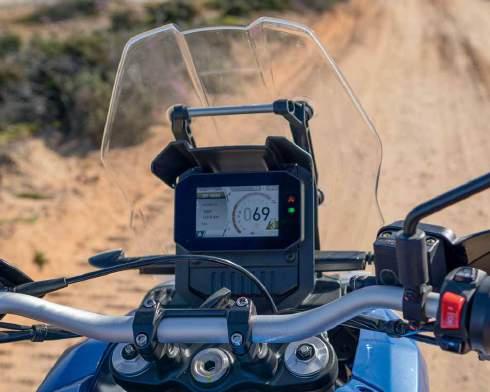
and wanted to camp. Not possible without first fitting a rear carrier rack, which is one of a number of accessories on offer by Aprilia. There’s also pannier racks and aluminium side boxes, but there’s probably aftermarket cheaper options. I’d personally go for soft panniers, which Aprilia don’t do for the Tuareg. I’d also fit a set of leaver protectors such as Bark Busters, which would be a critical addition for me as I dropped the Tuareg a few times doing tight turns and the stop-on-the-hill exercise on the OffRoad Skills course. When I handed the bike back, both leavers were a little shorter. I would definitely fit the Aprilia Quick Shift for clutchless up and downshifting, which would be a dream on the trails.
There is also an aftermarket lowering link for the Tuareg that drops it by 32mm, plus you could fit the low comfort seat giving an extra 2cm, putting you just over 5cm closer to the ground. The other ‘cheaper’ option, which does not lose ground clearance, is to trim foam from the seat where it’s scalloped near the front and is deceptively thick. An upholster who specialises in motor cycle seats would use various layers of high-density foam to not only make the seat lower but would also give comfort for those long rides on tarmac. All my FOPFD problems would be solved. And in the meantime, as I gained more off-roading skills, the Tuareg would patiently wait for me to catch up and then I could fully explore its enormous potential and agility in the dirt.
The Tuareg is the go anywhere bike. You’ve got a dirt bike. You’ve got a road bike… and a commuting bike, all wrapped up in a package that is pure ‘get-up-and-go fun’. But, would I buy one? As an adventure bike for long-distance travel, for me, I still think the Tuareg is too heavy, especially once loaded. For this reason, my Yamaha TT600 is still my adventure bike of choice.
The Tuareg 660 ride away is $22,530 for the Indaco Tagelmust (blue and white) or $22,230 for the Acid Gold or Martian Red with this being my personal favourite.
You can read more about the Tuareg and its specs at: www.aprilia.com
To learn more about Simon Pavey’s Off Road Skills course visit: www.compassexpeditions.com or www.offroadskills.com
Heather ellis is the author of Ubuntu: One Woman’s Motorcycle Odyssey Across Africa and Timeless On The Silk Road. Purchase on Amazon or from www.heather-ellis.com (Australia only).
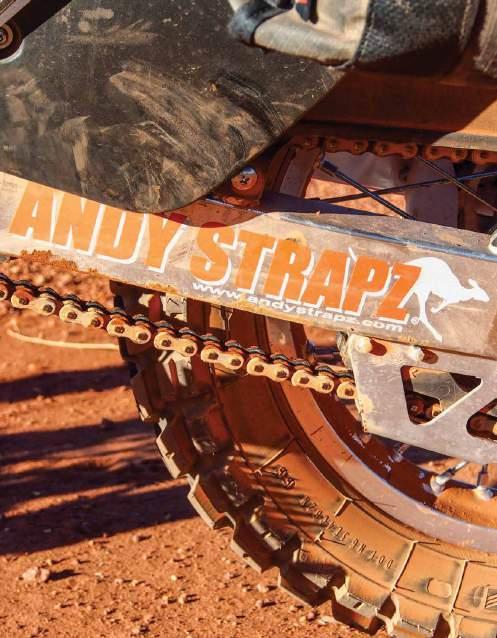




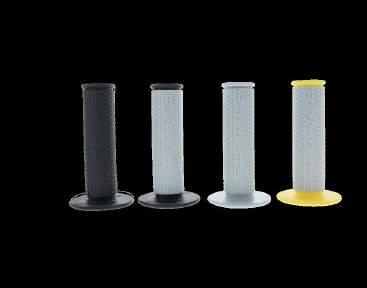
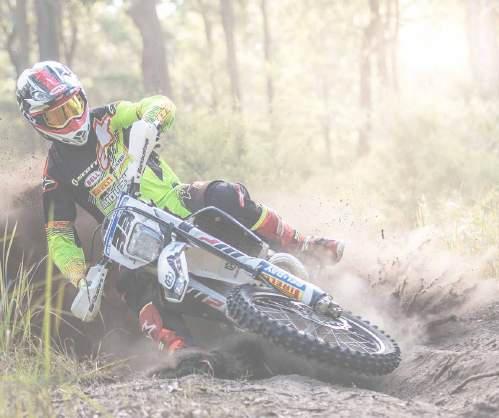

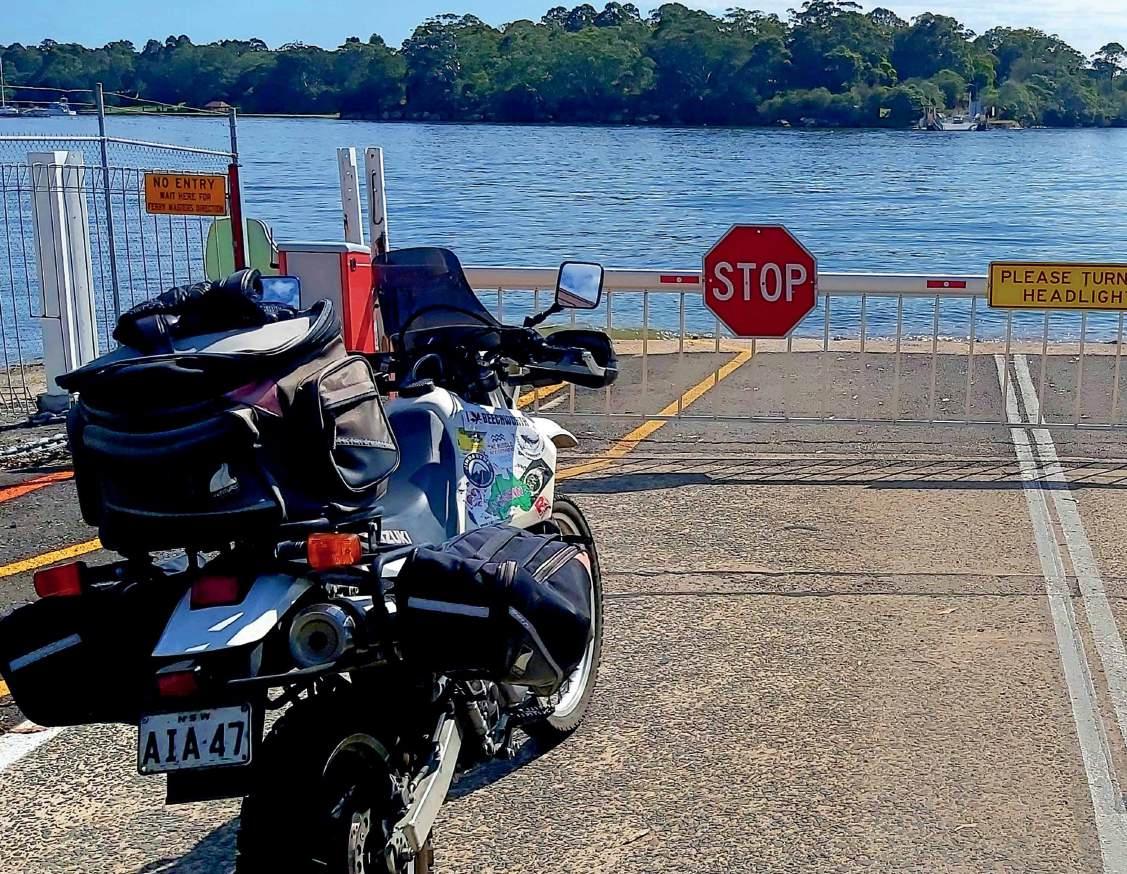
As antiquated as punts are, discovering the six of them in the Sydney region provided one of the most scenic and enjoyable rides I have done.
The last remaining punt in the Sydney metropolitan area is the Mortlake –Putney Punt. Just shy of its centenary and now heritage listed, it began operations
on 16 May 1928 and was built to ferry workers from the northern shore of the Parramatta River to service the gas works of Mortlake. The alternative was to travel to Medowbank and catch a punt where
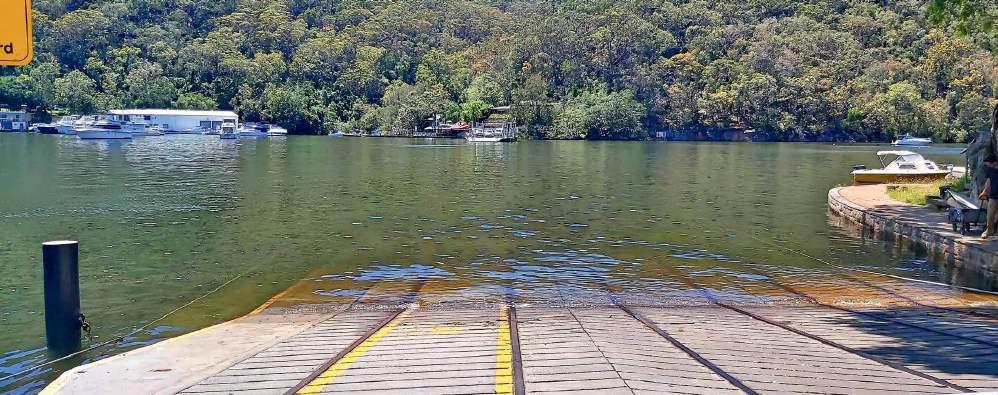
Words and Images: Bob Wozga
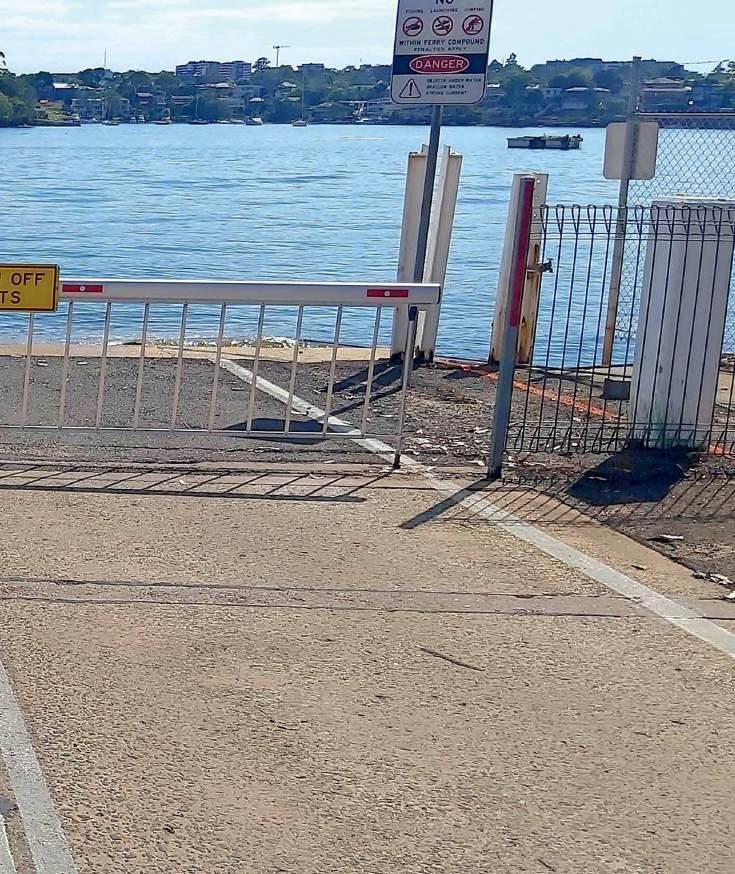
the Ryde Bridge now stands, or plan B was to take your chances and row across the shark infested waters of the Parramatta River.
Sitting at the boom gate watching cars being loaded on the distant shore, a cormorant bobs in the glass like water chasing breakfast while a seaplane flies up the river showing lucky passengers the beauty of our harbour and city. The foreshore has replaced the factories with residential units overlooking the river and old corner shops in the back streets have been replaced with coffee houses spilling with people and their dogs getting their morning fix. As the punt came to the bank, the ferryman waved his hands and told me there were no more crossings till the afternoon. So, when you are planning your voyage, be sure to be sure you are at the shore to ensure you don’t miss the boat.
Situated at the end of Hilly Street Mortlake and exiting at the end of Pellisier Road Putney, the punt carries 15 cars at a time and crosses the 300 metres of river at a leisurely pace. The 5 minutes it takes to cross gives you time to admire the river and is free of tolls and trolls (Everyone knows Trolls live under bridges). The punt operates daily. On weekdays,
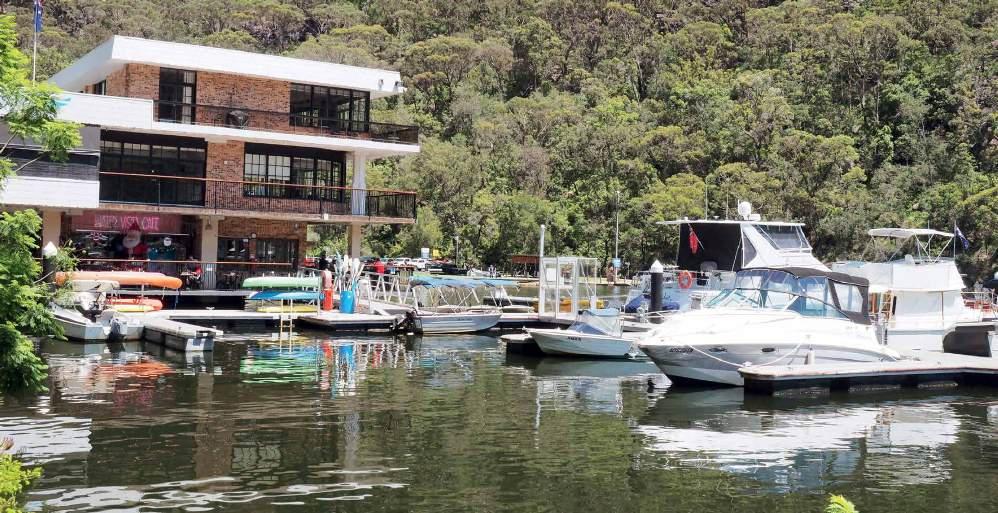
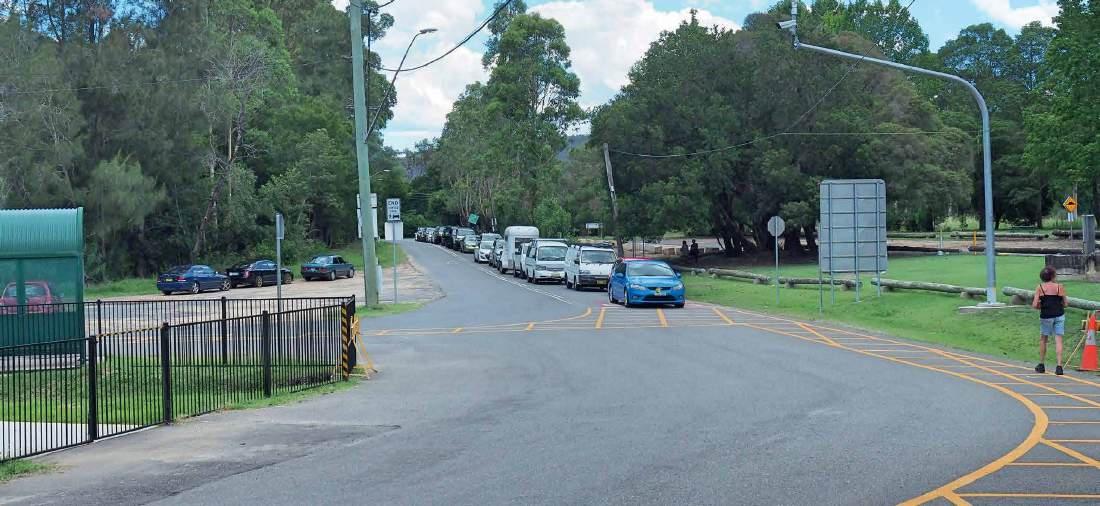
it operates on the Mortlake shore from 6:45am to 9:25am and resumes at 2:45pm till 6:15pm. On weekends and public holidays, it operates continuously from 10:30am till 5:30pm.
Berowra Waters Punt.
Having missed the boat, the next port of call is the Berowra Waters Punt. Secreted in the northern outskirts of Sydney lays Berowra Waters. Most people ride straight past the innocuous road sign in their rush to get to the central coast and beyond. Unbeknown to most, it has a spectacular narrow serpentine road that leads you



from the pacific Highway to the Berowra Creek where a punt transports you forty kilometres from Sydney and a million miles from troubles. Berowra Waters houses a marina, river charters, Italian restaurant, café and a place to park your bike and sit in the sun with a cheese board and a bottle of red. Kicking back in my saddle while the punt ferries me across the river, a German Shepherd takes his master for his morning exercise, paddleboarding between the moored boats. The punt was built in 1902 to transport produce from the food belt of the Hawkesbury Valley to the Sydney markets.
The Berowra Waters Ferry is at the bottom of Berowra Waters Road and crosses to bay Road. It runs 24/7, stopping for scheduled maintenance on the second Tuesday of each month between 12:00 and 12:30pm.
The road west up Bay Road to Arcadia is windy and narrow, so keep well within the double center lines as the occasional excited 4x4 with boat trailer races down the hill. At Arcadia, turn right at Wylds Road and follow it to the next T-intersection then turn right onto the Old Northern Road toward Glenorie, Maroota and ultimately Wisemans Ferry. Depending on the time of year and how much luggage space you have, roadside stalls offer fresh fruit, veg and eggs. The Great Northern Road (Old Northern Road) was constructed between 1826 and

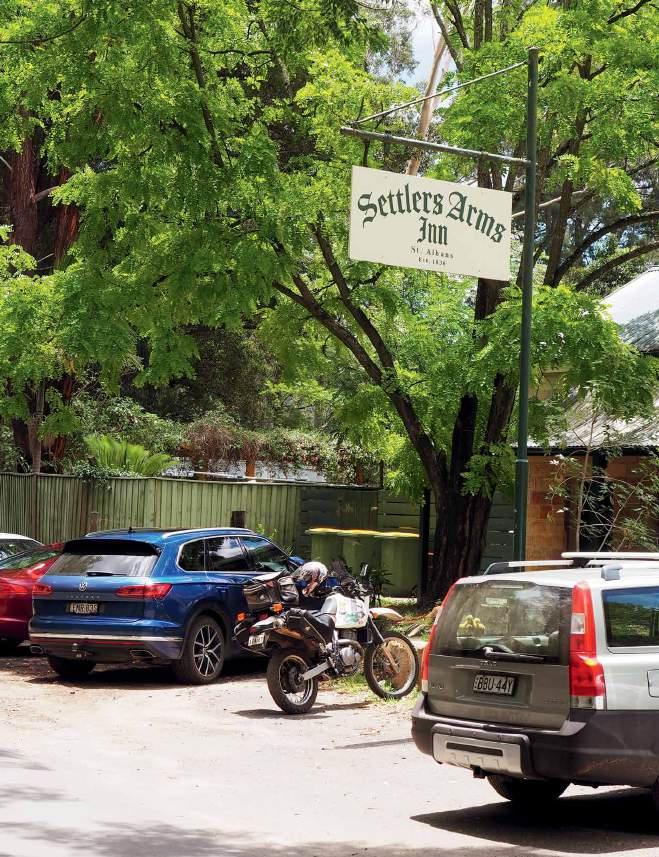
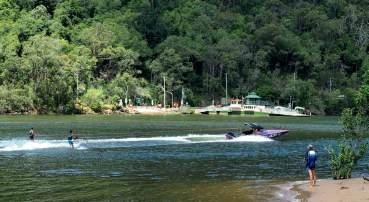
Above: Wisemans Ferry - fishing and Skiing.
Left & below: St Albans.
Right: Waiting Webbs Creek.
Bottom right: Lower Portland Crossing.
1832 with convict labour. An old friend years ago told me they used to get an eerie feeling jogging along parts of the road late afternoon. There are still relics of convict activity hidden in the brushes. I always thought she was crazy. On the roadside at Maroota lays a lonely grave commemorating McFarland buried 19.1.1871. Delving into the history of the grave, the body was found by a drover, Mr. T. Bowcork, a drover, along the Windsor Road. Inquests were conducted and reports from the Maitland Mercury & Hunter River General Advertiser 1872 concluded that the deceased was Thomas McFarlane having probably died from exposure to the sun. Maybe she wasn’t that crazy after all.
Arriving at the Wisemans Ferry punt, a queue already waits to board. Riders sit on the roadside talking about their ride along the Old Northern Road, an old couple sit in their camping chairs watching the cars queuing up or playing “spotto”, water skiers jut up and down the river
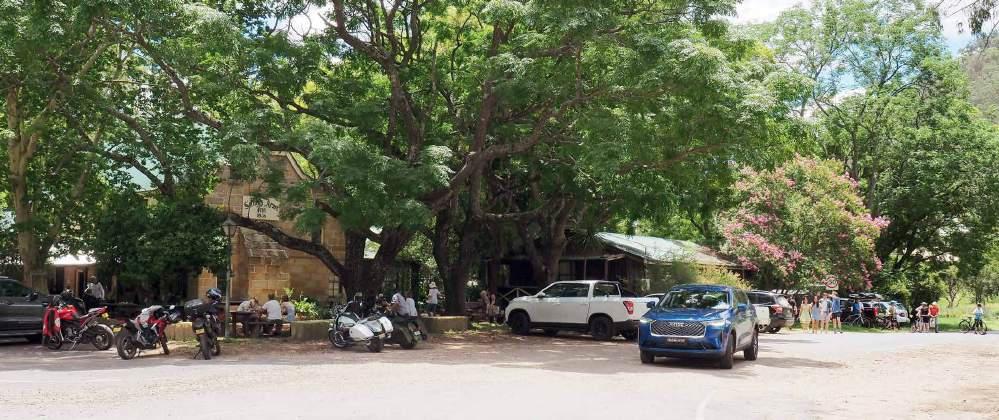

while others patiently wait for a nibble on their fishing rods. When it is busy a second punt is used to ease the flow.
Built by Soloman Wiseman in 1829 to ferry goods and travelers across the Hawkesbury as well as provisions for convicts building the road link to Newcastle and the Hunter. It was the main road until 1945 when the Peats Ferry Bridge was built at Brooklyn. Once across the river turn left along Settlers Road toward St Albans.
The Punt is at the end of Old Northern Road and operates 24/7. It takes about 4 minutes and there is no chance of sea sickness.
Taking the Settlers Road option, you head toward St Albans. Road works are still in progress due the flood damage experienced last year but by and large the road conditions are good. The road follows the rivers course and is mostly bitumen. Watch for cars coming out of driveways and people on mountain bikes. Stretch your legs at the Settlers Arms Inn or The Pickled Wombat in St Albans. The Settlers Arms is always a popular place to rest in the shade of the elm trees and listen to the sound of cicadas telling you it’s summer. Crossing the St Albans Bridge and turning left onto St Albans Road,
takes you along twenty kilometres of undulating road to the Webbs Creek Punt. A short queue and wait crosses the river and return you to Wisemans Ferry. Built as an alternative to the main ferry, it is upstream of the Macdonald River. Located at the end of St Albans Road, it is operated 24/7 with scheduled maintenance on the first Tuesday of each month between 9:30am and 12:00pm
Once across, turn right onto the River Road. This is a mesmerizing stretch with the river on your right and sandstone wall on your left. The road u

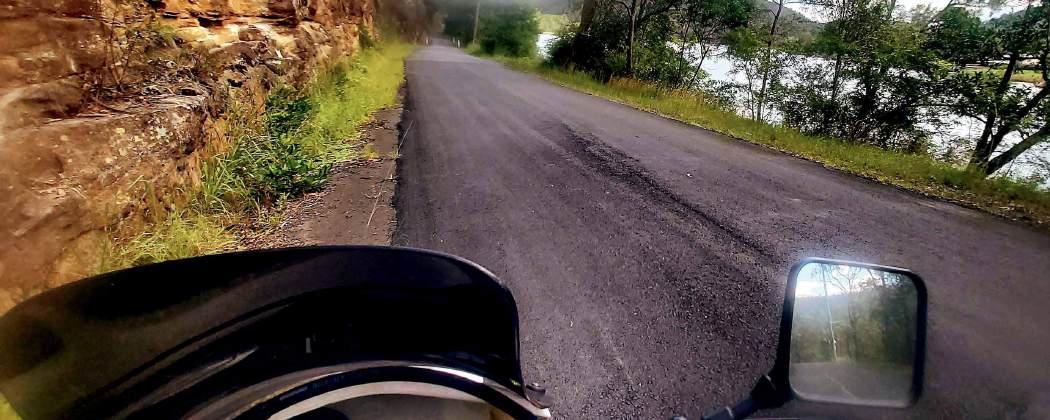

is relatively narrow and there are many 35km/h bends. The afternoon sun highlights the orange sandstone cliffs. In various places, the road winds under overhangs showing millions of years of weathering that’s created patterns in the walls of various colours and tones. Along the river, ski boats race up and down with a bodies, standing on wooden planks holding a rope for dear life while having the time of their lives. In Lower Portland you can stop for a snack at the Paradise café. Located on the River Road, the Lower Portland Ferry operates 7 days a week between 6:00am and 10:00pm. It is also closed briefly between 10:00am to 10:30am and 6:30pm to 7:00pm.
Crossing on the punt and travelling along West Portland Road, you head up the escarpment and look down on the Hawkesbury. Farmlets dot the landscape and traffic is very light and you can just cruise enjoying the road. Arriving at the T-intersection of Sackville Road, turn left, in a short distance you will stop at Sackville Punt. Operating since 1870, it was originally used to deliver produce to the Sydney markets as well servicing settlements along the river. Now, it links Ebenezer to Maroota and the Old Northern Road as well as giving access to the numerous ski parks along the Hawkesbury. Once across the to the northern shore, head back to Sydney via
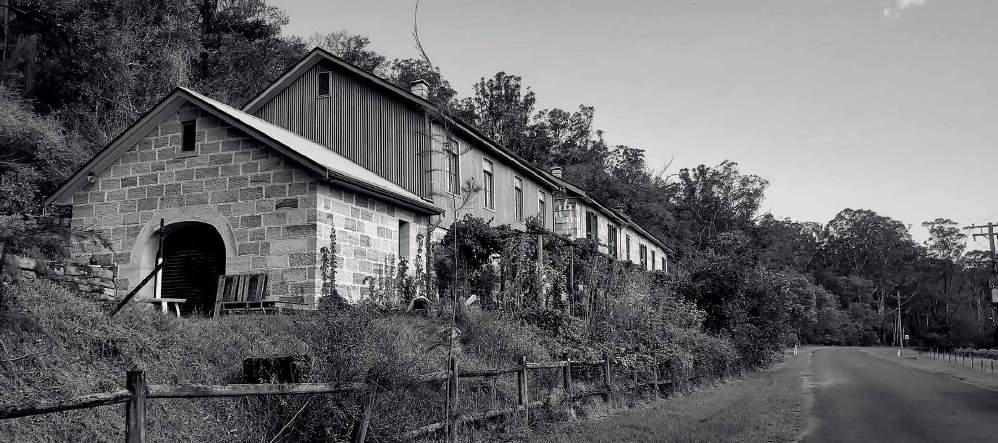
Maroota and the Old Noth Road or turn right onto Wisemans Ferry Road and travel through Cattai, Pitt Town and McGraths Hill before the journey back to Sydney. Option “C” is to re-cross the river and take the first left onto Tizzanna Road before looping back onto Sackville Road and returning to Widsor. This follows the river and brings you past Jubilee Vinyard Estate and Tizzana Winery. Established in 1889 by Dr Fiaschi and planted with French and Italian vine cuttings it is one of the country’s oldest wineries. The last of the original vintage was in 1949 and went into disrepair in the early 50’s. After being burned down in 1955, it rose from the ashes like the Pheonix and brought back to life in the 70’s and 80’s. Resembling a little piece of Tuscany hidden in the Hawkesbury valley, the cellar doors are open on weekends and public holidays from 12:00 to 5:00pm
Located on Sackville Road, the
Sackville Punt operates 24/7, scheduled maintenance is on the first Wednesday of each month between 15:45pm and 3:00pm.
All the punts are free. When planning a trip to visit the punts, ensure you check operating times and be aware that there will be queues and wait times to board.
Take something to keep you amused for 15 minutes. The good thing is you don’t need to pre-book the voyage, show boarding passes nor pay the Ferryman even when he gets you to the other side. In the cooler months when daylight is shorter, it might be worth doing this over two days.

The NSW Government website for Vehicle ferries can be found atwww.nsw.gov.au/driving-boating-and-transport/plan-your-trip/planning-toolsand-information/vehicle-ferries#:~:text=use%20this%20crossing.-,Operating%20 times,%3A00am%20and%205%3A00pm.
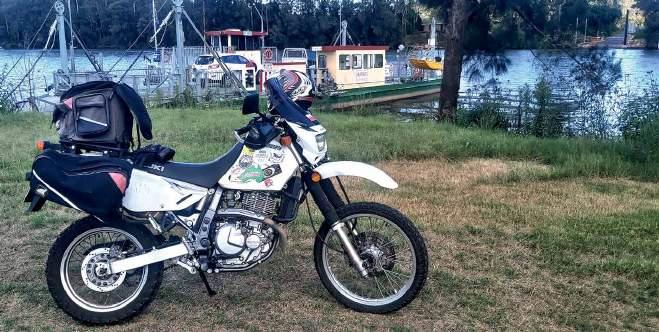

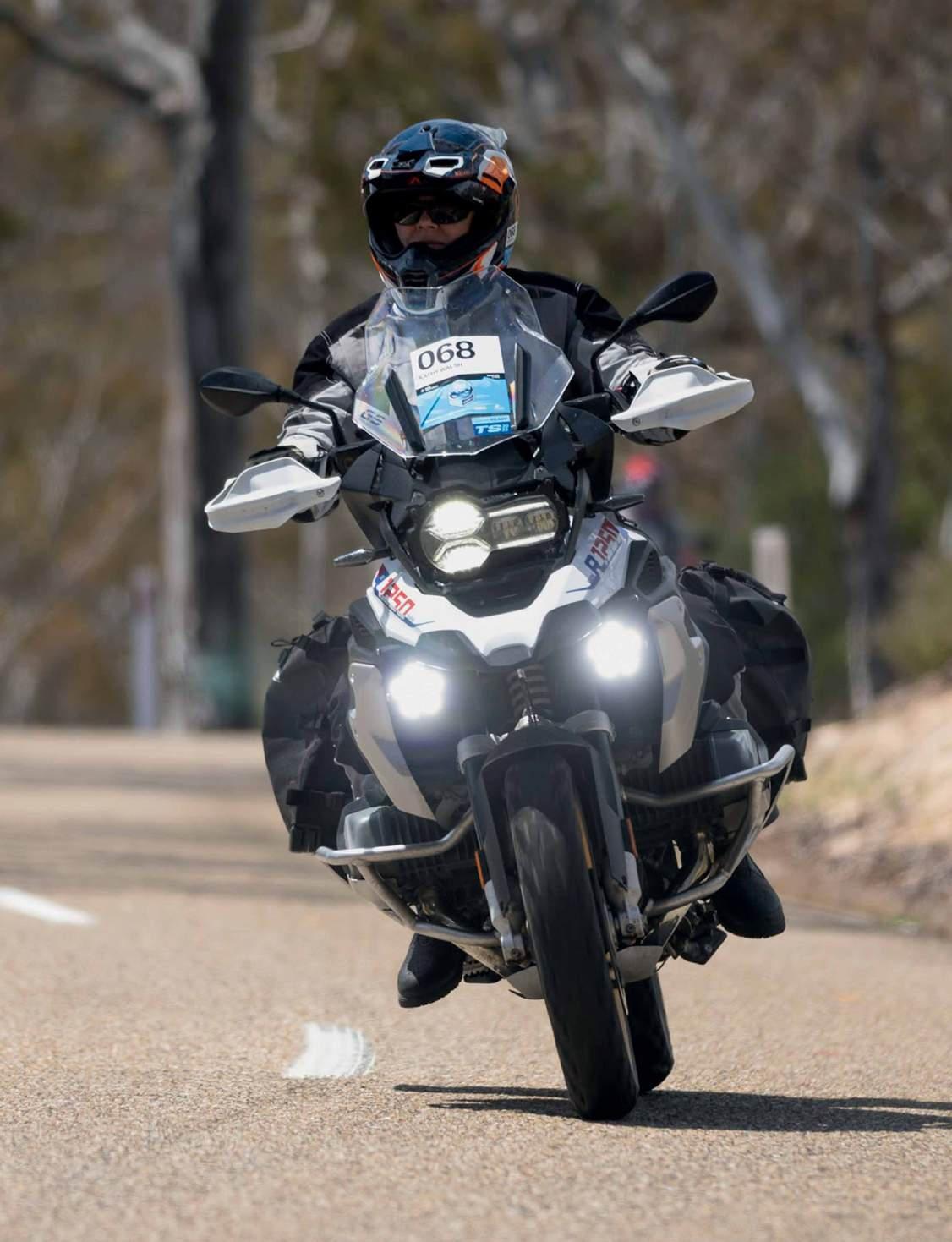
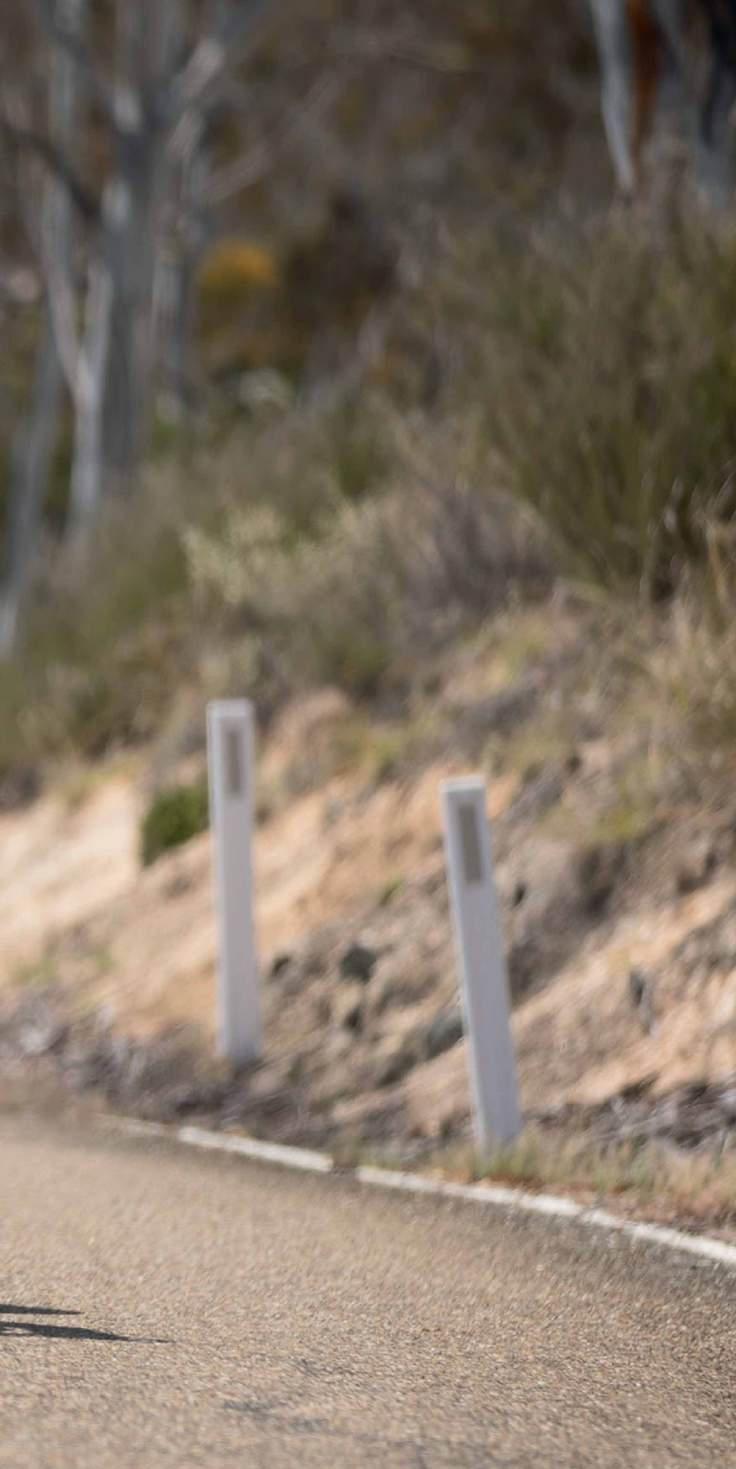
’d really like to do that one day!”
An email hit my inbox for the 2023 BMW TS Safari, riding the Victorian and NSW high country. I have been riding BMW adventure bikes only for about 6 years (F800GS and currently R1250GS Rallye X), and I’d always thought the GS Safari was something for my bucket list.
But what about the TS – I was always concerned that I wasn’t a good enough rider to handle the stamina needed for the GS Safari, but what’s the TS Safari about? It looked a whole lot more cruisy, bitumen the whole way, but taking back roads and seeing a whole lot of country.
Questions popped in my head as I tried to decide if I would or could, do this event: v What if I had to share a room with a big hairy biker who snored? Mmmm…. Well, that means I probably should take the Grand Tourer option for a room on my own.
v What if there weren’t any other ladies on the tour? I scoured the YouTube videos of previous BMW TS Safaris, and was a bit more reassured that at least there should be ladies riding pillion, if not on-bike themselves.
I clicked the link…
Geez, there wasn’t any of the premium spots left!
I decided a snoring, big hairy biker was a deal-breaker, so emailed the support email to go on the waiting list for the Grand Tourer option, not really expecting a reply.
A couple of days later, the lovely Anthea responded to say that they had a cancellation, and there was a Grand Tourer spot with my name on it.
Boom! I was going! Excitement hit. My first BMW safari. Woop woop! This is my experience as a newbie to BMW Safari.
Wow - exceptionally well organised! Registration, getting your event bag of goodies, and the first, welcome dinner appeared to run seamlessly, but was fun and laidback, meeting lots of new people. This was where we met all the team – tour owners and organisers, lead riders, sweep riders, tour doctor (riding too), tech specialist, luggage support, and weather girl.
After a pretty flash meal – thank you RACV Country Club Healesville – the first rider briefing kicked off. Lots of info to assimilate:

v Maps of the first day’s route
v GPS files for those with Garmins
v Route marking put out by the lead riders
v How to stay in front of the sweep rider on route
v And what to do if you needed help.
The tour ran for 5 days (6 nights) heading to Bright for 2 days, then Jindabyne, Canberra and Sydney. It was exceptional country and beautiful riding. Every day! And there weren’t any hairy bikers, that I was hoping wouldn’t be there. In fact, the
Left: Bike prep before Starting.
Below: Mount Beauty VIC from Sullivan’s Lookout. Top right: Bike at Eildon-Jamieson Scenic Lookout. Below right: Mt Hotham.
average age was around 60, predominantly gentlemanly fellas, and nine ladies with two on-bike (myself included). It was a lovely group. And there were many exceptional riders. So, the event wasn’t just a great tour, there were lots of lessons learnt riding with more experienced people.
Clearly, I lot of effort had gone in to making the route, and therefore the riding, special. Lots of alpine twisties and sweepers, some technical riding, and other areas just taking in the stunning scenery. Epic views, beautiful highcountry rivers, high alpine plains, winding national park roads. There was a huge variety in the type of roads that seemed to tick everyone’s ‘best road’ boxes.
In the high alpine areas above the tree line, we had some gnarly cross-winds on Day 2 that I found difficult, but most other riders didn’t seem too affected. Given that I hadn’t ridden any of the roads from Day 2 onwards, it truly was an adventure.
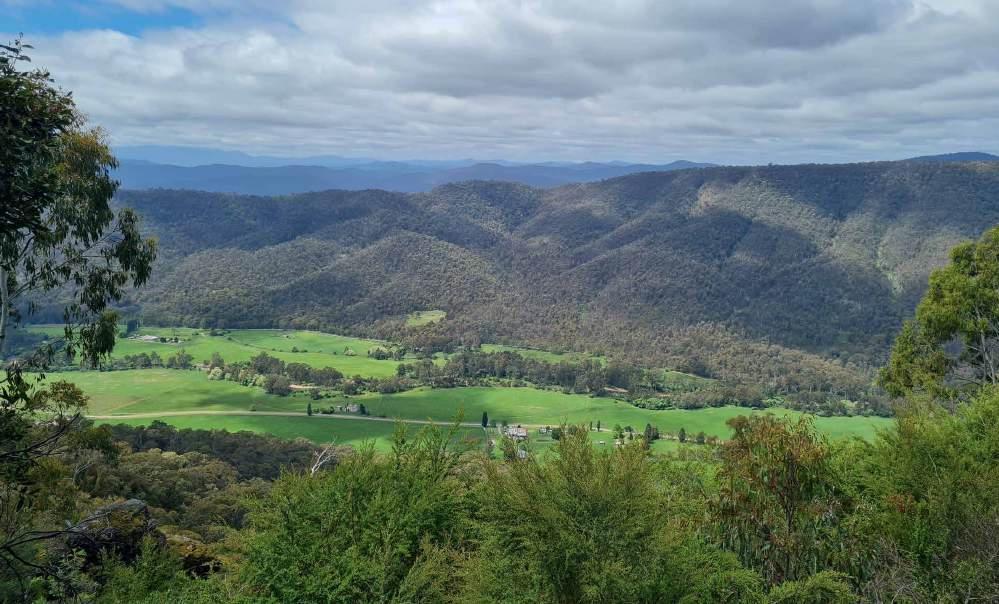
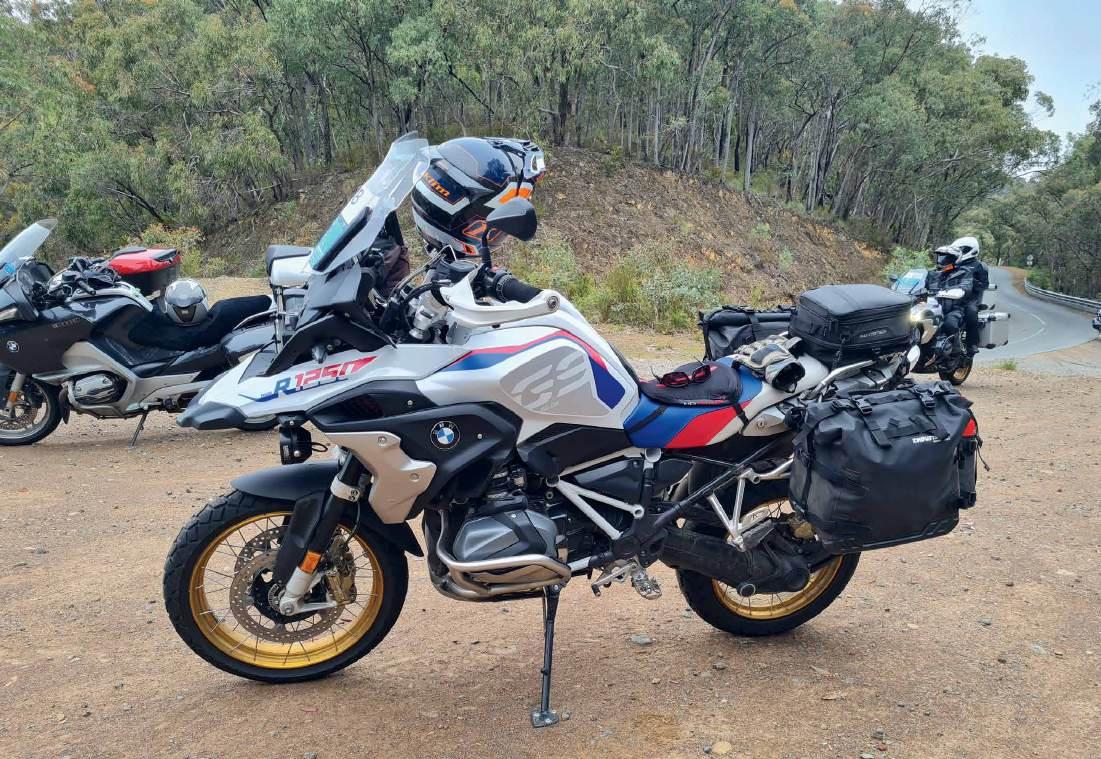
Every day had its challenging sections and it certainly wasn’t just a cruisy route.
On Day 4, the temperature leaving Jindabyne was a barmy two degrees and there had been a dusting of snow overnight on the higher areas we were riding through to start with. It was super cold! An hour into the route, Adaminaby became the stop for a coffee by what seemed like half the tour. There were about 30 bikes in the tiny main street.
Goodness knows what the locals thought! But the café did a brisk trade of coffees, muffins and cakes, warming up all the BMW icicles. And the group was having fun, regardless of the temperature.
There wasn’t much that didn’t go well. The whole event was professionally organised and I felt like I could just concentrate on riding and enjoying myself.
Hotel and food options in the smaller places we stayed was naturally more difficult, and if there were any areas that could improve, it might be around these. It meant that a couple of breakfasts and a dinner wasn’t provided as part of the tour cost. However, I cannot think of an alternative option when we were staying in smaller towns and the group spread across several locations. The accommodation and meals in the larger
u
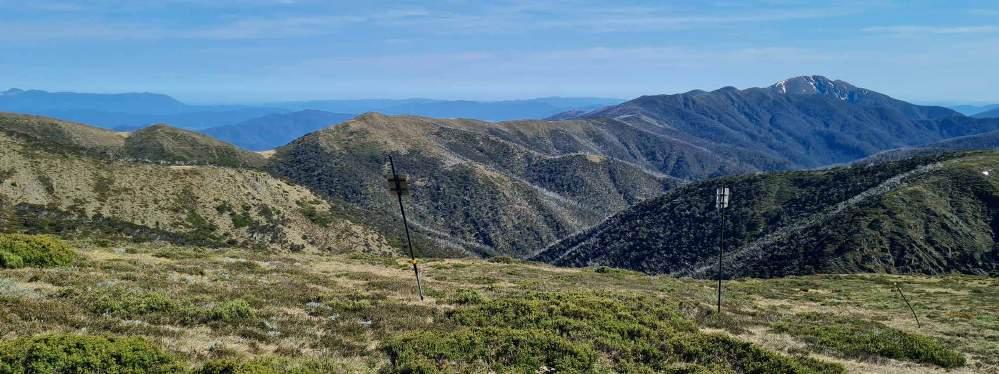
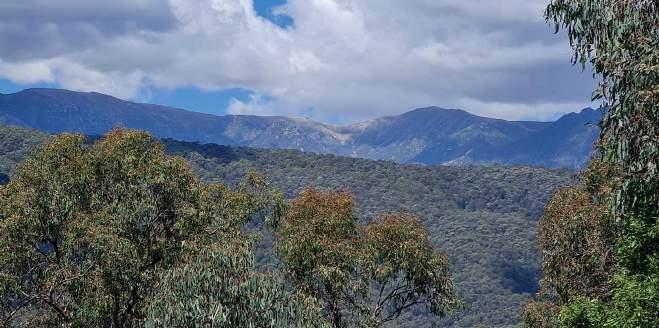

towns was top-notch and on target for the money.
I think there were a couple of ‘offs, a couple of riders overcooking corners, but nobody was hurt. And one tyre puncture that was plugged on the route and then replaced that evening by the techie. So quite different from the GS Safari. My 2022 R1250 GS Rallye X did not miss a beat, it ate up the kilometres and seemed to come alive on some of those twisties near Omeo!
As a newbie to BMW Safari, I was originally a bit anxious about navigating, staying in front of the sweep rider, and whether I would have enough stamina to ride for five full days. And like so many things we get worried about, all of these were, in the end, absolutely fine.
I found that I navigated using the placed arrows and the GPS file, so it didn’t matter if I was riding in a group or on my own. I didn’t really use the map provided during the day, but did like to study it the night before, so I understood the route we were taking. Other riders relied entirely on the arrows on the route, particularly if they didn’t have a GPS. It was very doable without relying on the Garmin.
Even though I wasn’t remotely one of the fastest riders (and the tour wasn’t about speed anyway), I think I spotted our sweep riders only once, when I was leaving a town after lunch, and they were pulling in. It just wasn’t an issue and the group seemed to find its natural rhythm –who liked to be out front and who liked to take it easy and stop to see the sights. And there was plenty of time to stop where you wanted to.
And what about energy levels?
That wasn’t a problem either. Six to eight hours in the saddle every day turned out to be doable. It was tiring and you needed to pace yourself. And I needed a couple of days to recover once home again, so if you plan to do one of these events, don’t go back to work the next working day!
Absolutely, yes! I had a ball and thoroughly enjoyed meeting lots of new, likeminded riders. And even if it turned out that I was the only girl on another BMW safari or tour, it just wouldn’t be a problem.
So, perhaps I will see you on the next one?

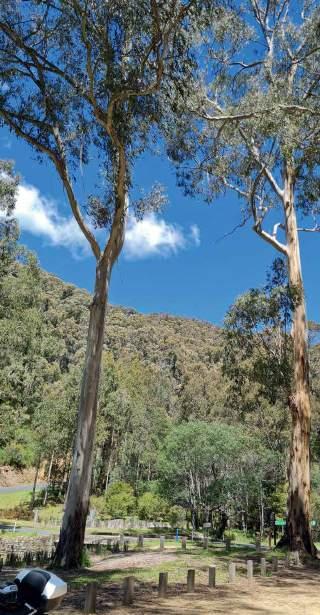
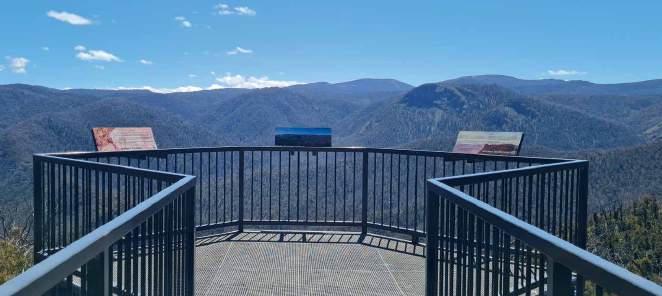
Kathy has been riding for about eight years, and only got her bike license in her mid-forties. She is a company owner and consultant in the pharmaceutical industry who loves to schedule riding time to decompress from business ownership. Kathy spends a lot of time riding near the Dandenong Ranges in Melbourne, getting into the Yarra Ranges State Park and other Victorian forests within a day’s ride.
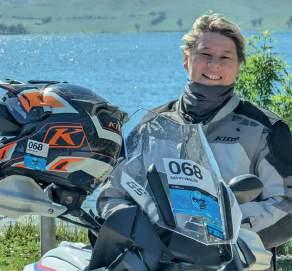
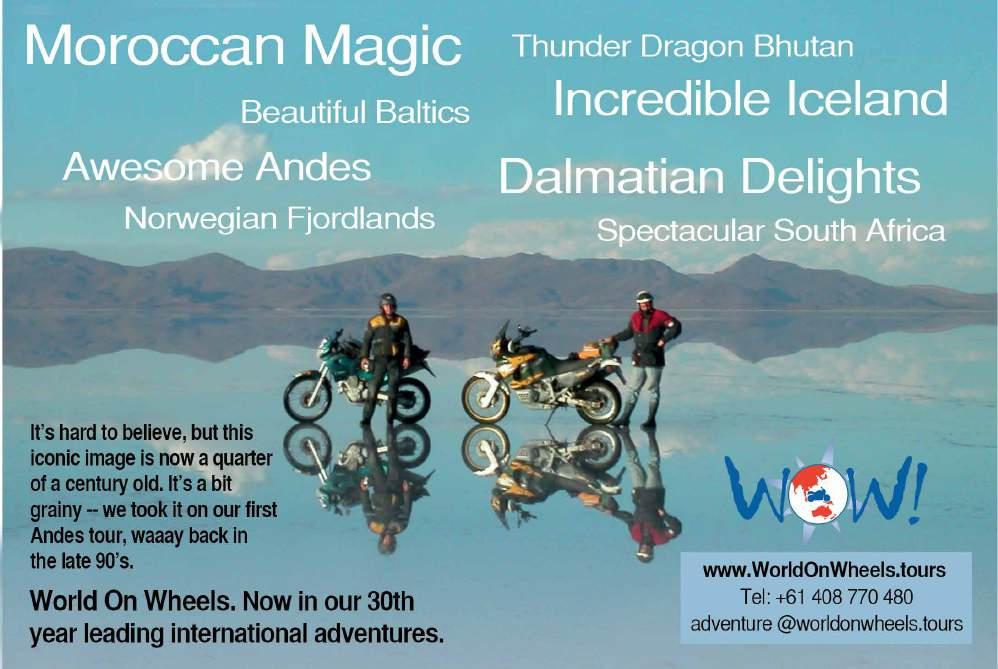




RATED 4 OUT OF 5 HELMETS RT
Archibald St, Lockington, Vic 3563
T: 03 54862501
FB: Lockington Hotel
(the page with the pub’s logo)
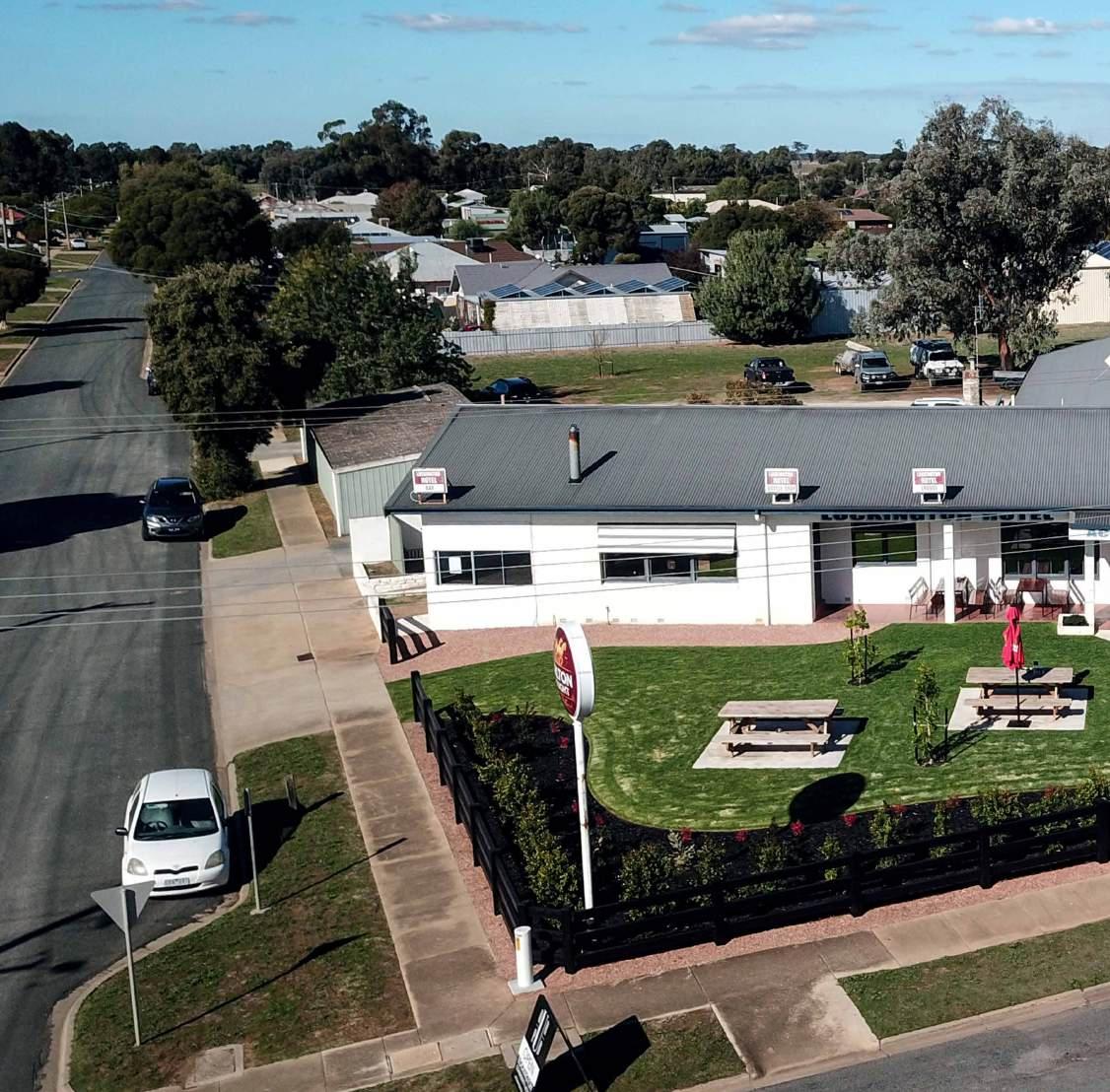
Words and Images: Col Whelan
Ah, Karma, you’ve gotta love Karma
When brothers Tom and John Mulcair raised £20,000 in one quid shares to form the Lockington Hotel Pty Ltd company and applied for a license in 1925 for a brand new pub they planned to build, it was Rochester, that stymied their plans.
The licensing board noted that Rochester’s pub was only fifteen miles from Lockington and so anyone with a thirst could just jump on their horse and head south. And then tell the Mulcairs to go take a jump.
Lockington remained pub-less for 21 more years before William Batt managed, in the face of
opposition from the police, assorted wowsers and of course Rochester, to convince the magistrates that his town’s people - especially those who didn’t ride horses, I’m guessing - deserved a pub and finally, on November 4th 1946, the bar doors opened.
Even then the buggers wouldn’t leave him alone. By the time he applied for his first annual renewal, the Rochester cop had booked him for Sunday trading, for delaying police entry and for people on premises after hours.
Apparently, Bill Batt ran decent (and needed) accommodation in his pub so the Magistrate gave him his license anyway and Locky, 25 miles south


west of Echuca, had signs its pub was in for the long run.
Bill batted on for almost three years and the four next owners averaged stints of around 5 years until Wendy Rolfe began a ten-year stint in 1989.
It was during this time that young Brook Nichol and his brother would be brought to the pub every Sunday by their dad and the boys’d have a coke and some tea whilst their father had a lite beer and caught up on news and yarn with mates, most of ‘em also farmers.
“Sunday here was one of the real highlights of grow ing up in this town. Twenty bucks would feed and water the three of us. With change. The place back then, I remember it always humming. My brother and I never wanted to leave,” recalls Brook as we sit
u
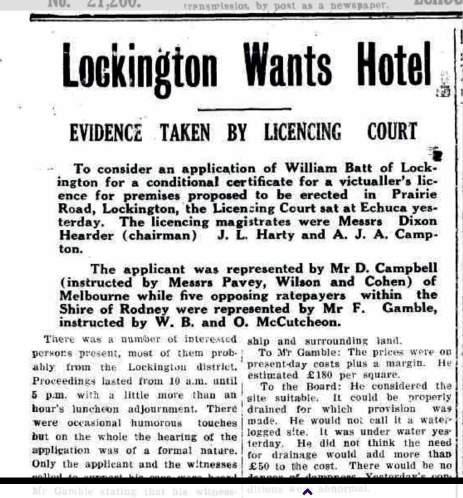


in quiet corner of the bar on a noisy Wednesday arvo.
Tonight he’s brought his two sons in for a drink and a meal; giving their mother a bit of a break.
The Lockington Hotel kept serving the town through the 80’s and 90’s and into the new century but in 2012 it was bought by the folks who had the town bakery, hoping to provide a business for their sons. Long story short, the kids weren’t too interested and the father, with a trucking business as well, had neither the time nor the drive.
Then he got Parkinson’s Disease and, with no buyer in sight, the pub’s doors were about to be shut and locked.
Well, a town that fought so damn hard to get a pub wasn’t about to lose it without a fight. A farmer named Terry Malone rounded up four of his mates and they decided the pub was too bloody important to the town.
In October 2017 the five of ‘em took a trip together over to the Wimmera and visited the community-owned pubs at Sea Lake and Nandaly. They met with the board members of both places
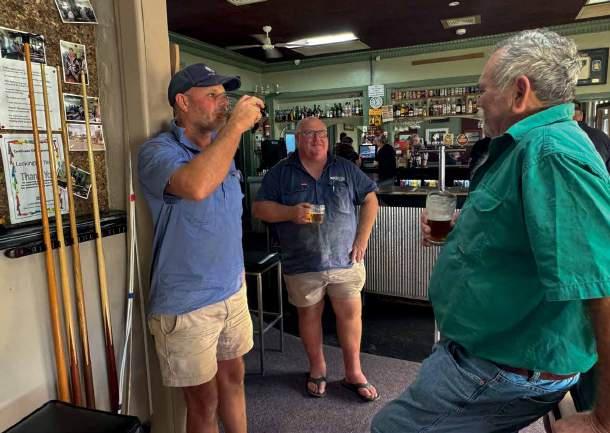
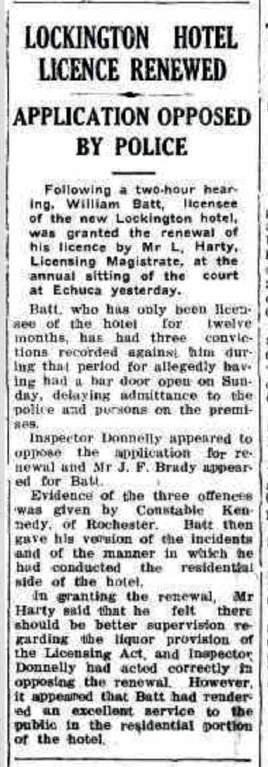
and came back with the concept of the townsfolk buying the pub. They called a community meeting at the footy grounds to see who was interested.
Brook was at the meeting.
“Maybe 100 – 150 people turned up, pretty much one person from every family in the town, and the principle was 5 grand a share and you could only buy a maximum of four shares, no more than 20 thousand in. But no matter how many shares you had, you still only had one vote at meetings.”
The response?
“We needed roughly $375,000 to buy
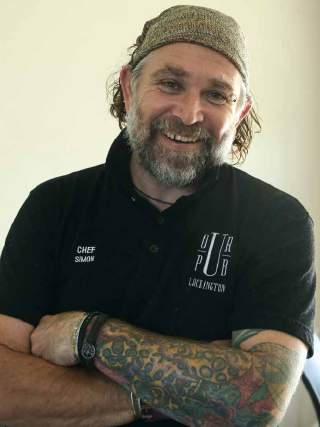
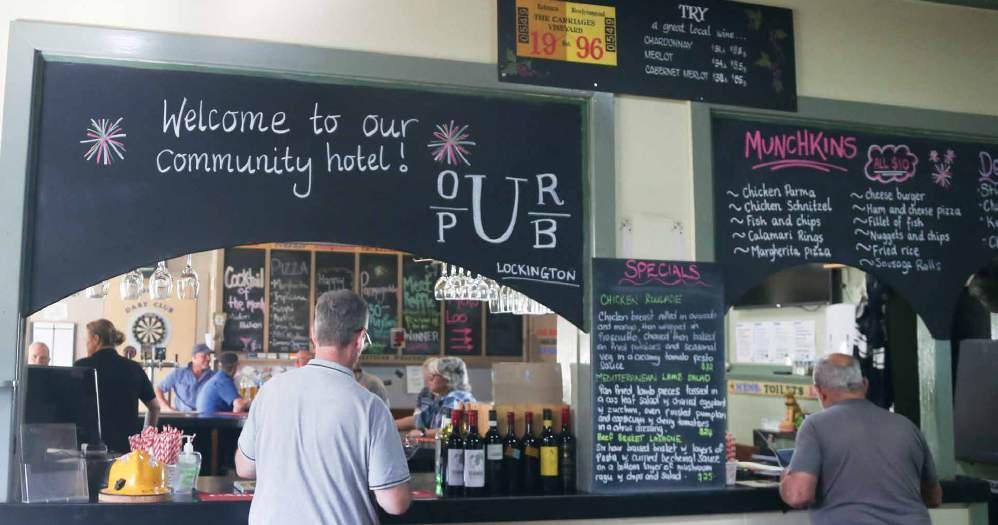
the pub, including the freehold and by the end of the meeting we had roughly $600,000 in pledges and everyone who committed on the day came throughnot a single defaulter.”
And pretty soon the town owned the pub.
The immediate priorities were the accommodation and the meals so the surplus was put to fixing up the rooms out the back and the pub’s dining room.
Then they replaced the carpark out the front - which “looked terrible enough to scare off first-timers” - with a landscaped beer garden.
Two years ago, Brook put himself up for the board and served on it for the next 18 months. The only reason he resigned was for his kids who’re “still at the stage that they like riding and hunting and fishing with their dad so I can’t let those valuable times slide by.”
But he remains staunch in the cause.
“The board’s an ego-free zone. It’s a really good mix of younger and older, male and female and farm and town,” he enthuses, not ruling out a return when his boys have grown a bit and prefer chasing potential partners on their own to chasing pigs with their dad.

“The place,” Brook reckons, “rocked from day 1, especially with the locals but then of course we got Simon.”
And this is where the Karma bit comes in.
In 2022 the Goulburn River burst its banks and Rochester was amongst the towns worst hit by the floods.
You’ll remember Rochester … just 15 miles away – with a pub which’d stopped Lockington getting one of its own for 21 years back around a century ago? Yes,
Above: Lockington Back Bar.
Below: Just some of the top quality meals on offer. u


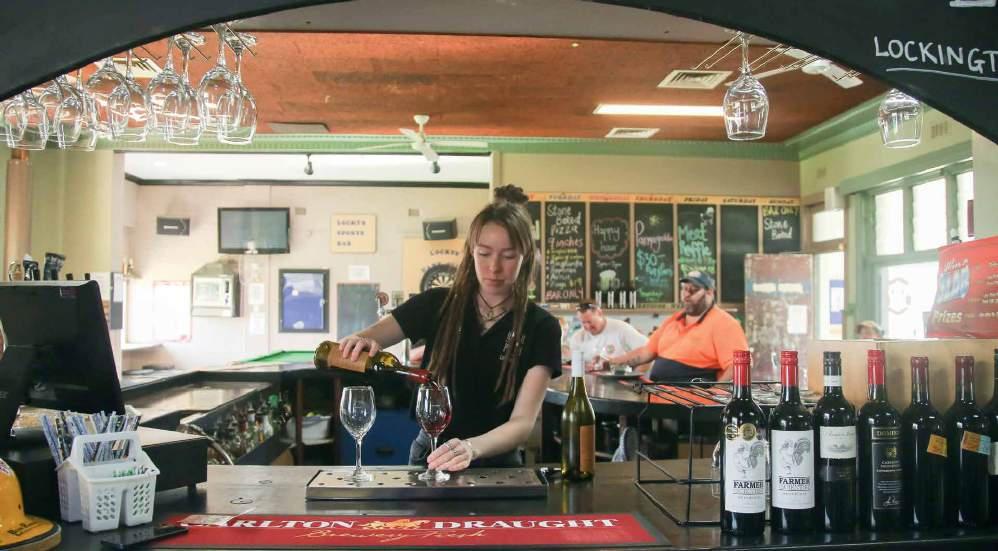
that Rochester.
The Simon who Brook mentioned is the pub’s chef but when the flood hit, he was running the kitchen of Rochester’s Shamrock Hotel and as he later tells me:
“I’d been in Rochester for 11 years and we had five beautiful kids in town but we were long-term renters and we were ousted in the floods. We ended up in a farmhouse and my wife and kids really struggled with it and Lockington reached out to me and said, ‘we’re busier than we’ve ever been would you like to come and give us a chop-out?’ I was like, a bit lost and I was eating into my savings and they’d done the right thing. They’d asked
my boss before they’d asked me and gone through all the right channels and my boss’d said, ‘well ask Simon and if he wants to then we understand’, so I was impressed by their methods and I thought I’d give it a shot.”
He came across in November with the idea of helping out for a few weeks but very quickly, “fell in love with the place and with the locals and I rang my wife and told her I thought we needed to think about relocating.”
Pretty soon the board called a meeting and told Simon they wanted him to stay. Simon told them it was 80/20. He was the 80 and his wife was 20 so he asked the



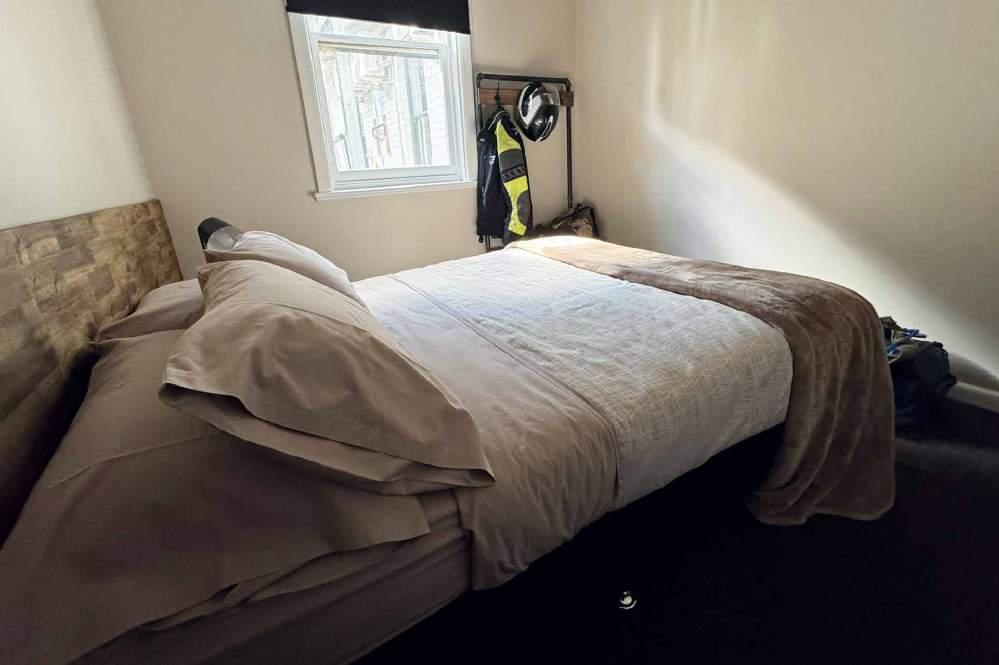
board to have a get-together with all their families and kids and he’d bring his.
“We all had this lunch and by the time I’d finished my meal my wife had told the board members that I’d be taking the job.”
They bought a house in town, put the kids in the local school, and as Simon gave the pub a new lease on life, so the town
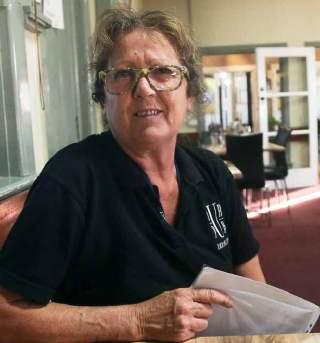
and the pub returned the favour. All his kitchenhands are local youngsters who’re looking to turn this into their careers.
“It’s put a whole new lease of life on
me as far as the teaching side of things goes and I’d forgotten maybe how much that adds to the process of cheffing – this teaching youngsters.”
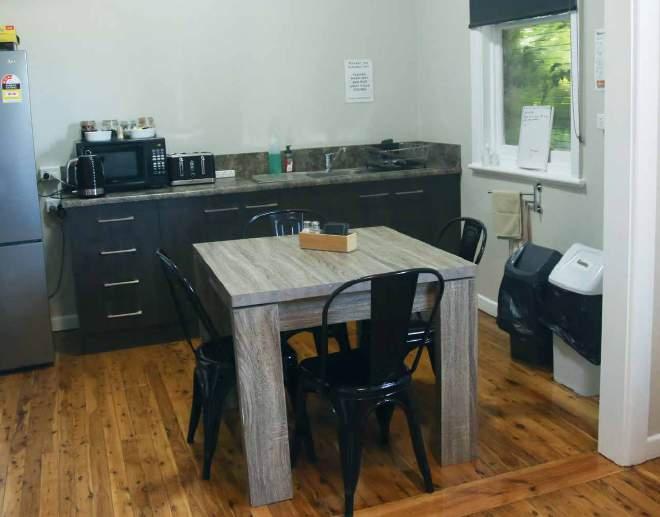
Before going on to add, “I’m 52 years old but I feel like I’m 40 as far as cheffing goes.”
And the proof of that is very much in the pudding. The team is turning out food which is nothing short of extraordinary in a town of less that 600 legal drinkers, the pub is averaging over 700 meals a week, and a quiet midweek dinner is around 100. The first time I visited I had an amazing slow cooked black angus beef cheek and this time I have the Chicken Roulade wrapped in prosciutto and stuffed with avocado and mango. Unforgettable.
The whole shebang’s kept together by Linda who worked here for ’15 years in the nineties’ (yeah, I know that doesn’t compute but that is what she told me) and who came back on board two years ago. She’s lived in town for just 35 years she’s 11 years shy of being considered a local and she keeps it all running smoothly: keeps the bar and house staff up to scratch and makes sure the punters on

I’mthe other side of the bar – especially any shareholders who think their stake entitles them to special treatment – all keep it real.
I don’t know if this is the best country pub I’ve been to in the last few years but sheesh, it must be close. It sets the benchmark for friendliness, for passionate staff,
having my first beer quietly at a corner table, when a bloke in green work shirt calls me over, telling me no-one drinks alone in this pub.
This is Ollie and like everyone I meet over the course of my stay, he exudes pride in what this pub – his pub – has become. Pretty soon we get onto his stories and they flow freely:
“I shore for twenty years and gave it away when I was 40. I was worn out. Body was gone. The only thing I have left from my shearing career is my thirst. After I retired I got a job with a wool store in Echuca and got to being the boss of a press. Stayed there for about 5 years. Ended up being the manager there.
I had some roughies working for me - blokes who’d not get a job anywhere else. I had one bloke who was late a lot of mornings so I chipped him and told him to be a bit more punctual. Anyway, he hadn’t quite got on top of his drinking habits but from then on when he got on the piss, he’d call a taxi to the pub and get the driver to drop him at the factory. Which was closed of course. So, he’d sleep in the gutter so I could wake him up when I arrived and he’d be on time.
That was the best job I ever had in my life. Part of it was to buy the skins and every morning I’d go to the abattoirs and I’d see all these mongrel sheep that’d given me the shits for so many years getting their fucking throats cut. Talk about job satisfaction.”
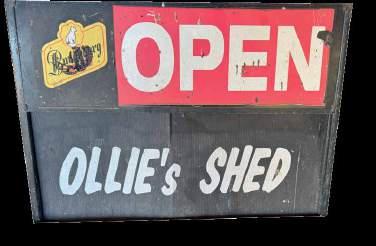
He lives 8 kms out of town and spent years creating his man cave from a remote shearing shed which he took apart and reconstructed in his back yard. With the pub closed on Mondays and Tuesdays, Ollie’s Bar is the place to be when the sun gets low. Bring your own and kick back. It doesn’t get much more real and they don’t come much finer than this bloke.
for good drinks and seriously good food.
But don’t trust me. Get there for yourself.
Then thank Karma …. Oh, and Rochester.

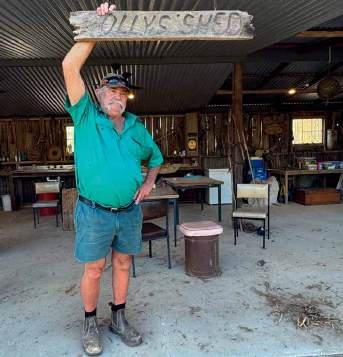

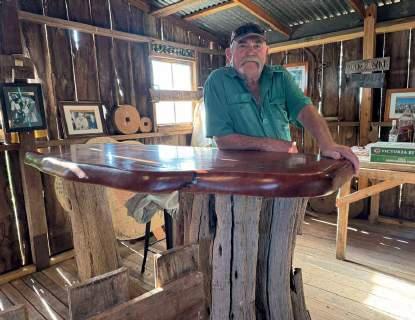
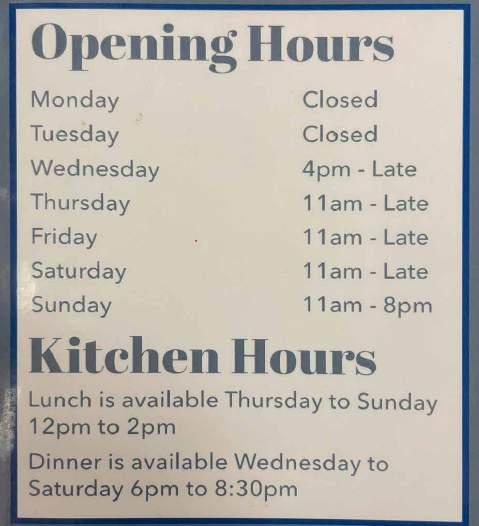
Archibald St, Lockington, Vic 3563
T: 03 54862501
FB: Lockington Hotel (the page with the pub’s logo)
Closed Monday and Tuesday, opens 4.00pm
Wednesday but the accommodation rooms are available 7 days.
No Undercover parking but there’s space right at the back door for your bike.
Ten rooms all up: 7 doubles, 2 with TV, 2 twin singles and 1 with a king bed. They all have air-con but the windows don’t open which is a negative for me. Plenty of strong hooks for your riding gear means there’s more floor space, but my double bed was just that, meaning it was just 180cms long. If you’re lankier, make sure you get a king. Showers and amenities are up to scratch and if you want to be near them, go for room 8.
The common room has a microwave, toaster and jug plus the makings for a brew along with a full-sized fridge with a freezer that’ll take water bottles and hydration bladders.
Proudly free of gambling although the pool comp can get fierce.
Four beers on tap: Meb Bitter, Carlton Dry and Draught and GN black Fish. Drinks only go up once a year and a schooner went up to 8 bucks on Feb 7th. Free wifi works well in the bar but not so in the rooms.
This is a brilliant, friendly, memorable pub.
Value is 150, Unique Character is 10/10 and the only thing costing it a fifth helmet is the lack of undercover and lockup bike parking and any reduction in room rates for single riders.
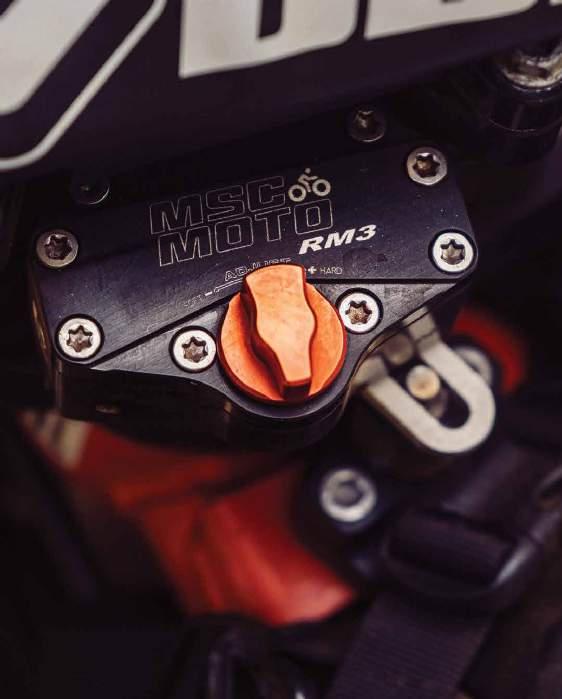


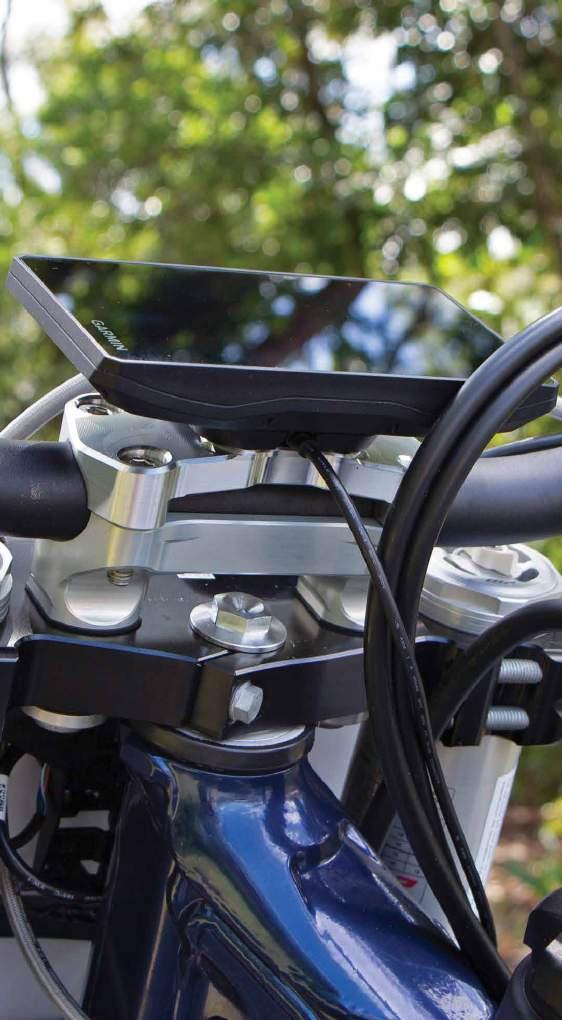

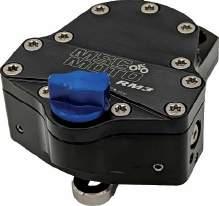


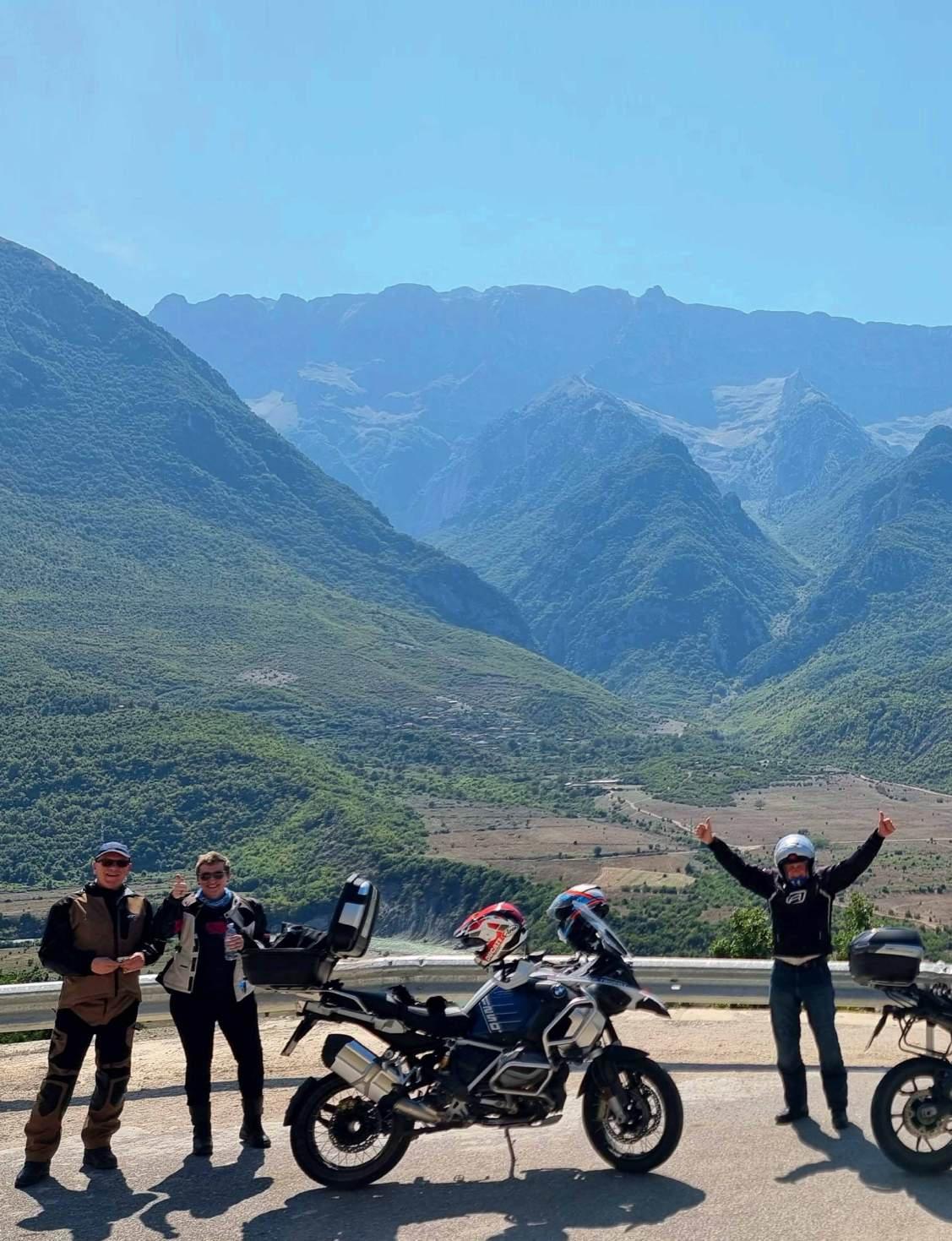
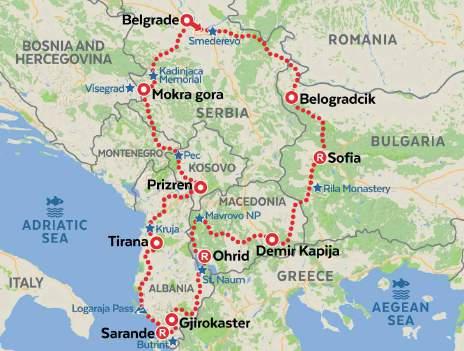
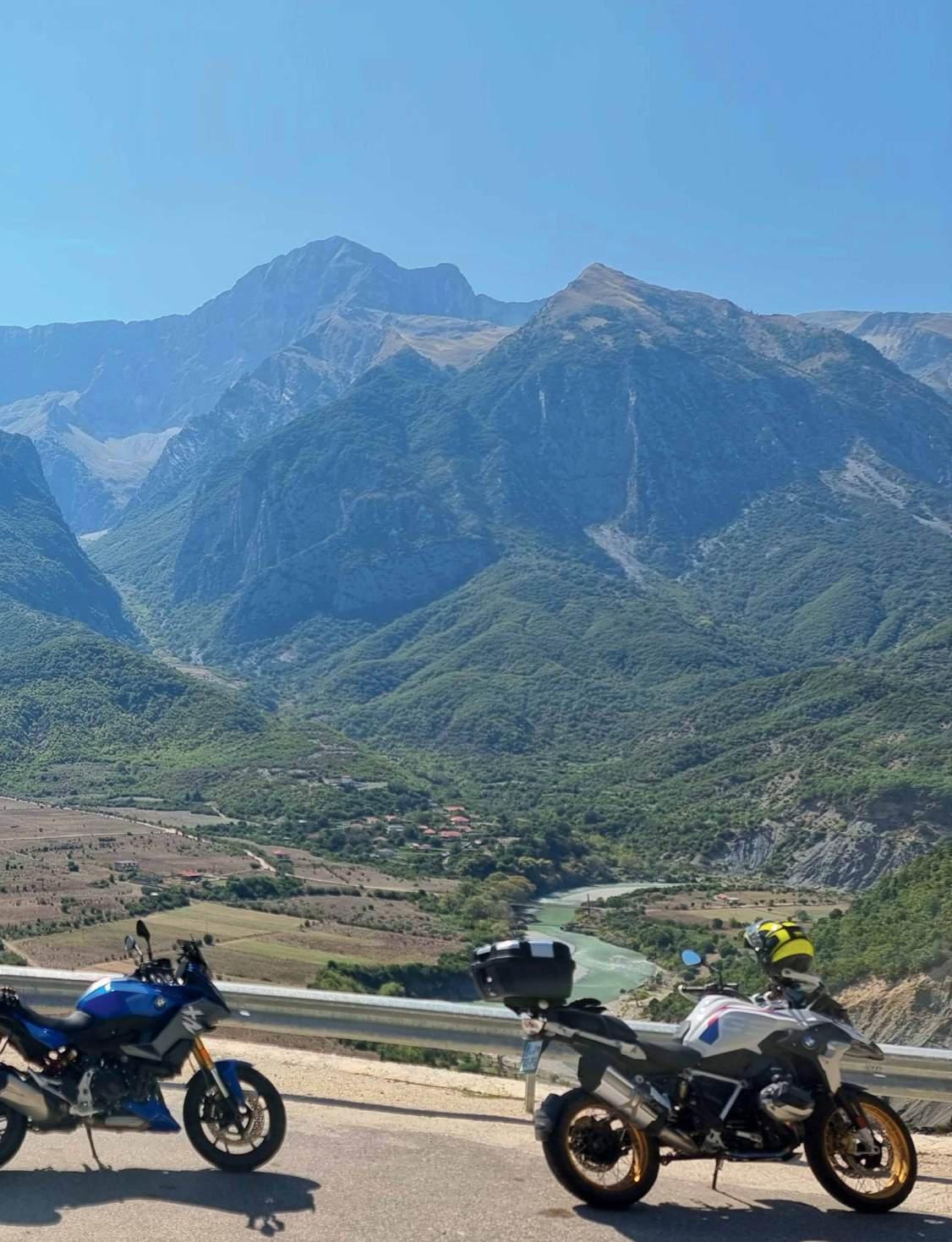
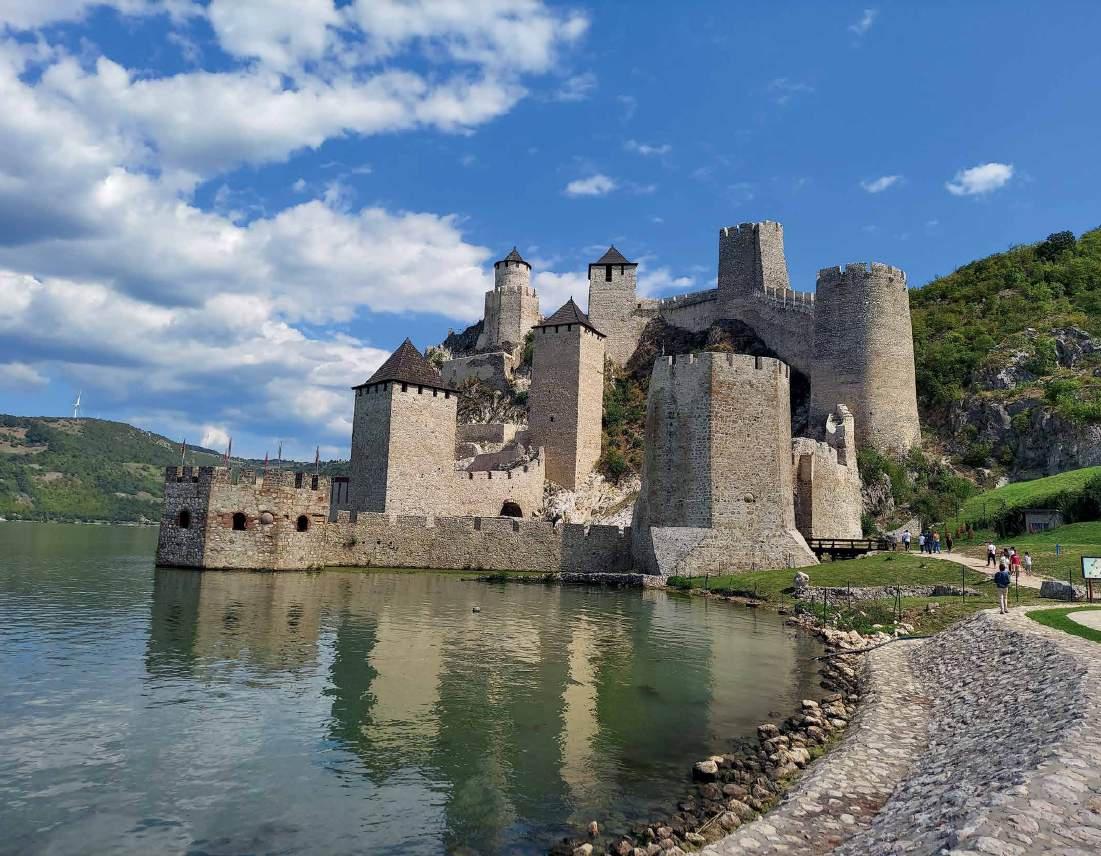
If one word could describe the riding experience in the half dozen Balkan countries on the AMT Intriguing Southeast Europe tour, that word would be variety.
That variety includes mountain
twisties, scenic and rugged shorelines, picturesque river valleys, lush forests, and rolling hills dotted with vineyards reminiscent of Tuscany.
This is definitely an off-the-beaten-path type of tour, so riders signing up for it will

have a blast getting off the main roads and visiting places that other tourists zoom right past.
Expect to tackle a few challenging roads, though. That’s to be expected when visiting countries new to tourism.
Experiencing — and overcoming — those challenges are what still linger in my mind from the time I took this 15-day tour couple of years ago.
The tour began just as most of the world was emerging from pandemic lockdowns. But covid fears still lingered, and all but two riders who had signed up for this tour dropped out.
I credit AMT for operating a tour catering to just me and Jim, the other rider, who hails from Florida. Many other tour companies would have canceled.
And I strongly recommend a guided tour for this part of Europe, especially for first-timers. That’s because the variety in the region also makes for some hassles: six countries (border crossings … ugh!), four languages, three alphabets, and four currencies!
So it’s best to have a Balkan native to guide you through this melange of countries. For Jim and me, that guide was Tomaž, a multi-lingual, native Slovenian with riding experience throughout the region.
The three of us gelled together immediately, which was a very good thing as we would be traveling and eating together for two straight weeks!
I teased Jim about living in a flat state, which has nothing like the mountain twisties we were about to encounter.
My home state, Minnesota, also lacks mountains, so Jim and I decided to treat this tour as a crash course — not literally, we hoped — on how to improve our navigation of mountain twisties.
We both teased Tomaž, too, and mocked him for the small tuft of hair centered under his lower lip. We did so kindly, of course, and in the process taught him some new English words: soul patch, pretentious, and hipster!
We started and ended in the vibrant city of Belgrade, Serbia, and took a clockwise path through North Macedonia, Albania, Kosovo, and Montenegro.
Bulgaria closed its borders due to covid just a week before our tour started, so AMT quickly rearranged the first three days of the tour. The current AMT Intriguing Southeast Europe tour includes Bulgaria once again.
I rode a new BMW F750 GS, which matched the weight and size of the 1989 Honda Transalp I ride at home.
Of course, the BMW had almost double the horsepower of my 30-year-old Honda, and included modern safety features such as ABS and traction control — which, I confess, were deployed a handful of times on the tour!
AMT sells all their bikes at the end of each riding season, and so all tours are outfitted with new or practically new machines, including BMWs, Hondas,
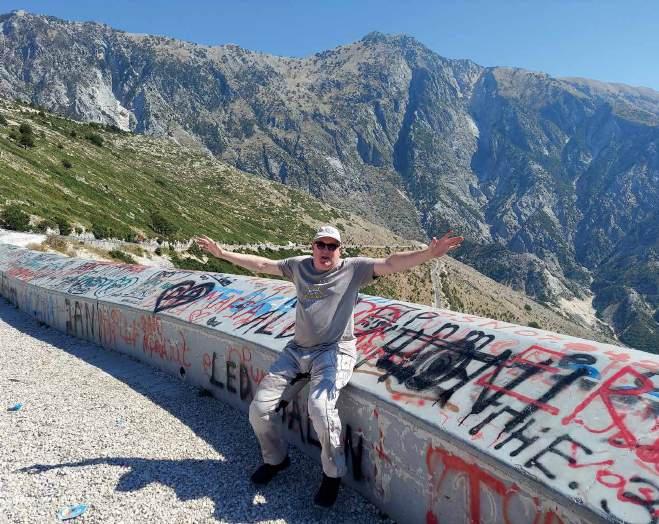

Suzukis, and Yamahas. All are equipped with ample storage cases and a preprogrammed, handlebar-mounted GPS showing each day’s route.
Our riding skills in curves were tested on our very first day when we rode alongside the wandering Danube River separating Serbia and Romania and through the foothills of the Serbian Carpathian Mountains. Riding in the foothills only whetted our appetite for eventually riding up into higher elevations. Those mountain twisties would come soon enough, Tomaž said, and there would be plenty of them. Yay, mountains!
We had a lunch at a roadside restaurant in the shadow of the massive Golubac Fortress, a strategically positioned military post that controlled access to the Iron Gorge, a narrow portion of the Danube River with steep, fjord-like embankments, which we rode alongside later that day.
The lunch was fabulous and was the first of many more tasty — and varied — dining experiences in our future.
The Balkan peoples have borrowed the best flavours from the cuisines of the many invaders who swept up and down the peninsula throughout history, including the Ottomans, Greeks, u


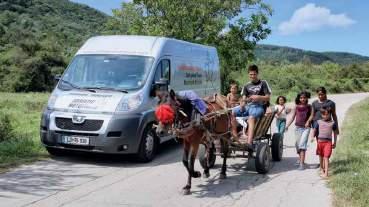
Romans, and Illyrians.
In addition to being a great motorcycle guide, Tomaž also helped guide us through menus to help us find the tastiest local food and drinks.
Evening meals were washed down with fresh-brewed local beers or national brands — all excellent — and local wines, mostly reds. And raki.
Raki, sometimes spelt rakija in the western Balkans, is a strong brandy made most often from plums (Slivovitz is a popular export), but peaches are also a common starting fruit.
But beware. Raki may be more than 80 proof, and it may be home-distilled. Even a shot served in a bar or restaurant could be the owner’s special creation. So, definitely enjoy raki with caution!
After spending a night in the Serbian town of Zaječar, we fortified ourselves with a lavish breakfast buffet at our upscale hotel (all AMT hotels are at least 3 or 4 stars, and all breakfasts are included), and rode through lush valleys and plains until we arrived mid-afternoon in North Macedonia’s capital Skopje.
We had time to explore this cosmopolitan city. The standout attraction was the absolutely massive central square and the enormous statue of Alexander the Great dominating it.
Except that to make nice with neighboring Greece — which claims Alexander the Great to be exclusively of Hellenic (Greek) heritage — the statue is officially named “Equestrian Warrior”.
Our dinners aside this square were very pleasant (if I were with my wife, I’d say they were romantic), as the statue and the entire square was brightly illuminated and full of people enjoying a nightlife vibe. I was elated seeing people in this region enjoying fuller, freer lives and no longer living drab existences under communist rule.
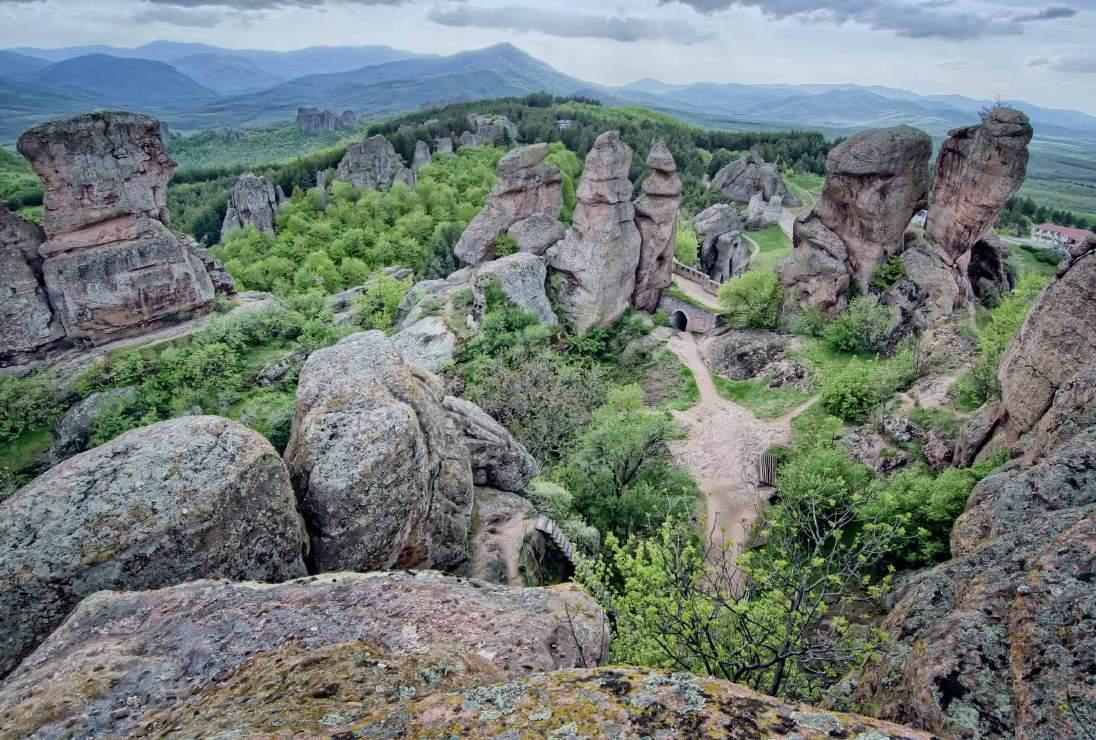
After an energizing rest day in Skopje, we traveled southeast, riding through the Demir Kapija gorge in Macedonia’s wine region, boasting gentle hills dotted with vineyards, reminiscent of Tuscany.
Fittingly, we stayed the night at a hotel
Above:
Below: Vivid Old Town of Prizren Kosovo. Below right: Tirana Central Square the capital of Albania.
connected to a vineyard where dinner included sampling the many different wine varieties produced in the area.
Our hosts told us that Macedonia is the fourth-largest supplier of bulk wine to Germany. Our taste buds told us the Macedonians save the good stuff for themselves!
The next day, we rode through the long, curving roads of southwestern Macedonia, through a sparsely populated, forested, and mountainous area. Jim and I are thoroughly enjoying the mountain highs.
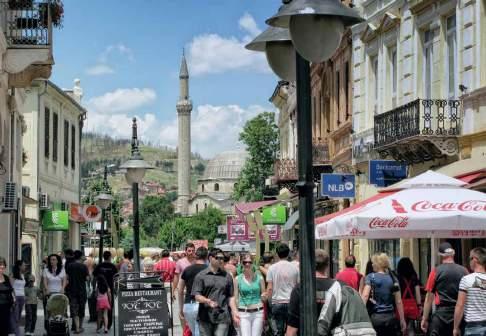
We arrived at Ohrid, a city on the northeastern shore of beautiful blue-green Lake Ohrid, one of the world’s deepest and oldest lakes, with 200 unique species.
Of particular note is the Lake Ohrid trout, a local delicacy tasting like a brown trout crossed with an Atlantic salmon.
Ohrid was the highlight of the tour for me, because my 1990 trip was a honeymoon with my wife, and one of our stops was Ohrid!
My fond memories of Ohrid came rushing back to me and I insisted — much to their annoyance, I suspect —
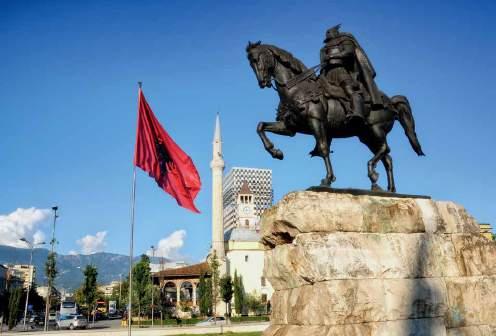
Right: Albanian Coast.
Middle right: Demir Kapija Winery Boutique hotel in Macedonia.
Bottom right: Author’s Tour Party of 3 - 2 riders and the guide, Roman Ruins Butrint Albania.
that Tomaž and Jim take a photo of me each time we came across a spot where my wife and I visited in 1990!
On our rest day in Ohrid, Jim and I took a pleasant and relaxing boat cruise on Lake Ohrid, under sunny skies and on beautiful clear water, with a stop at the monastery of Sveti Naum, the spiritual heart of Orthodox Macedonians.
The next day, the three of us rode along the lake’s northern shore past the monastery on our way to Albania.
It wasn’t too long after crossing the border that we see a defensive machinegun bunker, one of more than 750,000 built during Albania’s post-WWII communist regime.
Now all abandoned, the bunkers are a symbol of the extreme isolation and paranoia of the Albanian government, which feared armed invasion from the West and even from its communist neighbors.
I think Albania is my favourite Balkan country — this tour is my third time visiting the country on a motorcycle.
Part of the allure for me is that Albania is still mostly rustic and less touristy than its neighbors.
And although some Albanian roads are good — the country is undergoing a road construction boom preparing for an expected tourist boom — a good road can suddenly become a very, very bad road without warning.
Both Jim and I agreed it was good that Tomaž was in the lead!
The next day’s ride took us to Gjirocastër through the Gramoz mountains, where we thoroughly enjoyed climbing to the Barmashi Pass at 1759 m. Yay, mountain twisties!
In Gjirocastër, we visit the Cold War Tunnel Museum, an underground bunker that served as an emergency shelter for Albania’s top communist officials.
Like the innumerable small defensive bunkers found throughout the country, the Gjirocastër tunnels and its 59 rooms reflect the paranoid fear of a foreign invasion, and was designed to withstand a nuclear attack.
Our next stop was Sarande, a beach
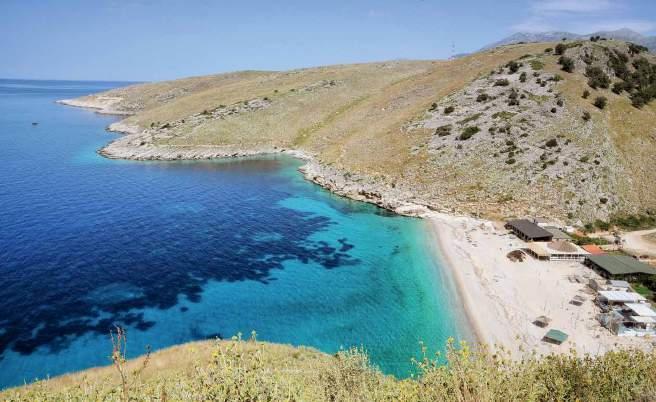
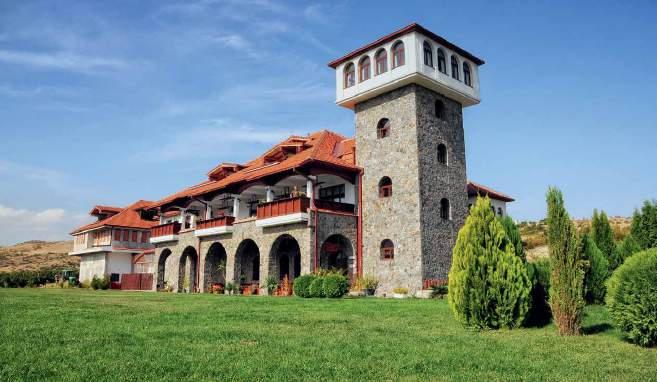

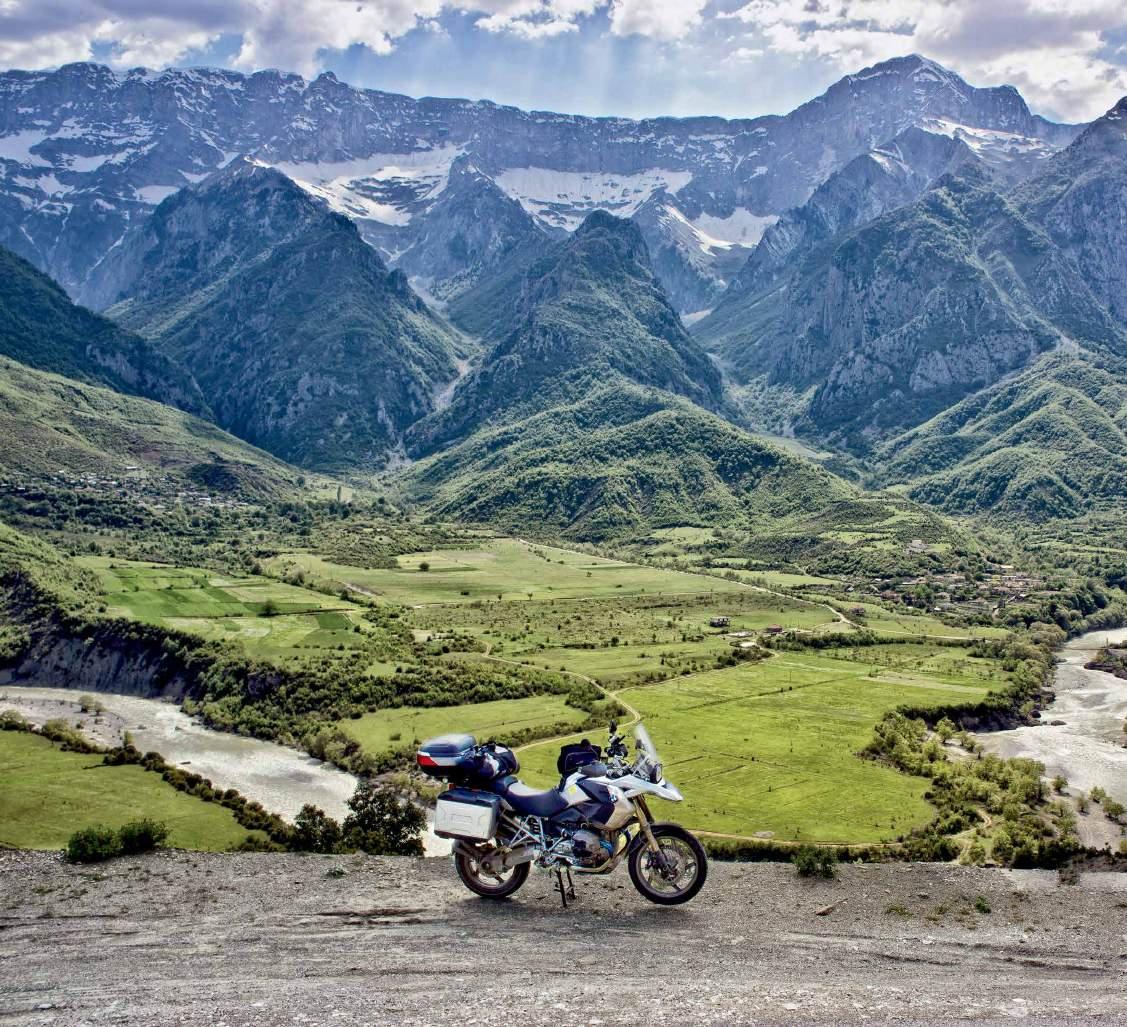
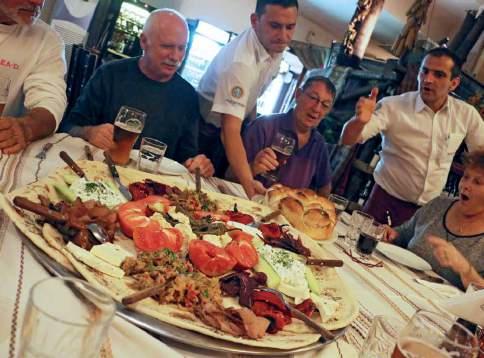

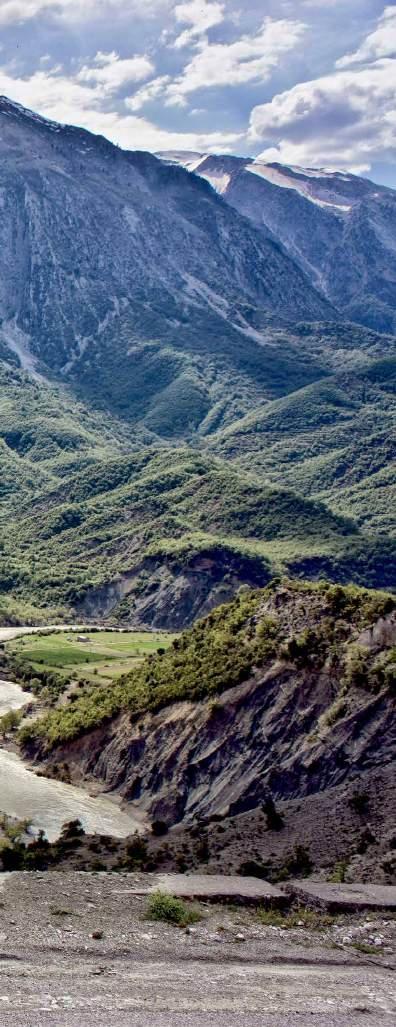

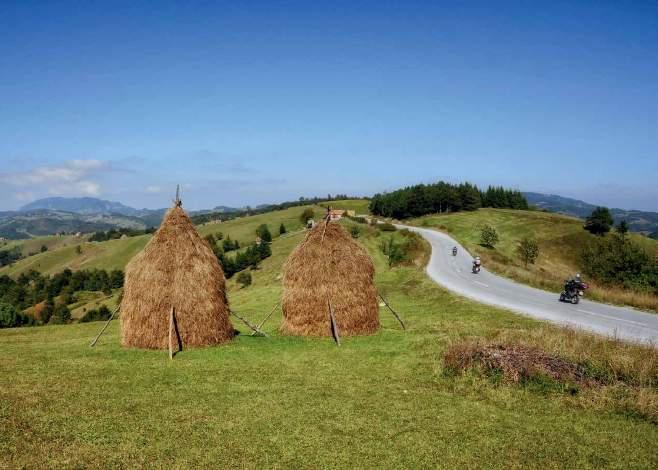
The deep-fried feta cheese we ordered had a perfect combination of flavour and texture that I’ve never experienced before, and it made the hassles of getting through Greek customs entirely worthwhile.
resort town on the southern tip of Albania with great swimming and fresh seafood.
We had a planned rest day at Sarande, but we opted to spend it riding south to Butrint, a UNESCO World Heritage site, where we strolled among Greek, Roman, and Byzantine ruins.
On a whim, we decided to ride even farther south and cross into Greece, where we had a pleasant seaside lunch in a small fishing village.
The next day’s ride was north toward Albania’s capital city of Tirana, and took us through two distinct landscapes.
In the morning, we rode 120 km on a beautiful coastal road, enjoying gentle sweepers with cliffs on one side and the shimmering blue Adriatic Sea on the other.
In the afternoon we went up and over the Llogara Pass (1027 m). This was a challenging, technical ride. Thank
goodness the road surfaces were new and the wandering animals few.
The incredibly wide central Skanderberg Square in Tirana is something to behold. It’s a busy and vibrant mishmash of architectural styles, crowds, and noise.
What a profound change from just a few decades ago when closed-off Albania was called the North Korea of Europe.
As our tour wrapped up, bittersweet feelings emerged. This was a moderately tough tour that even with three rest days can tire you out. u
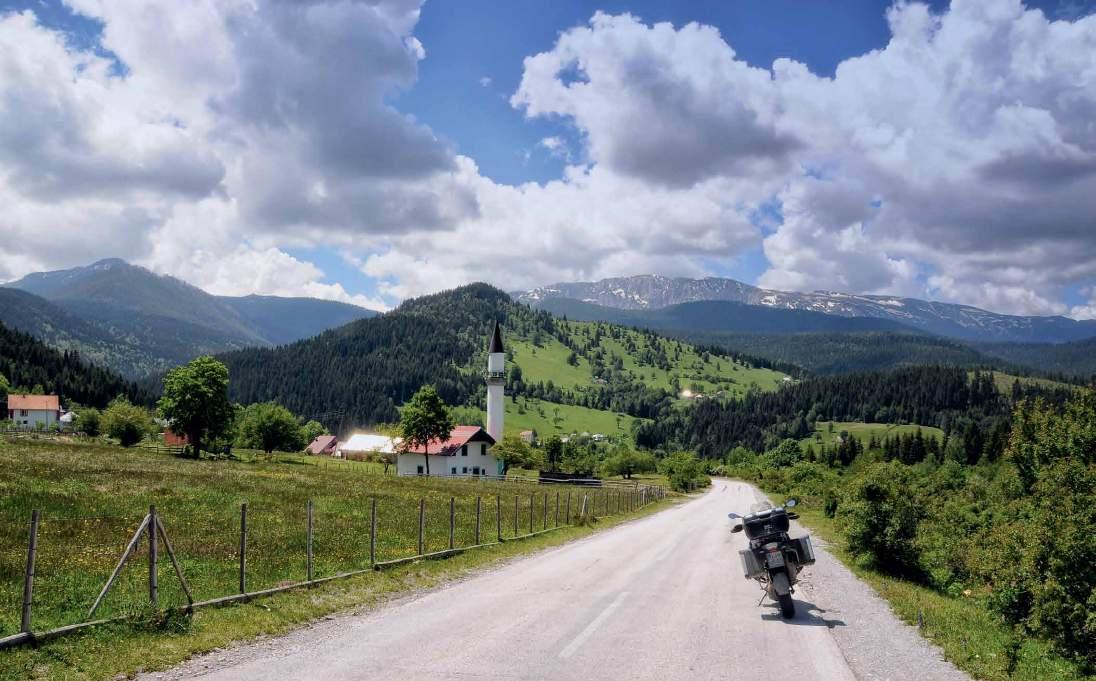
So I began to look forward to relaxing at the Belgrade hotel where we started, but not looking forward to losing the camaraderie that developed among the three of us.
But until then, there are a few more highlights to describe.
First was the mountainous ride north from Tirana to the town of Kruja, which for centuries was the center of Albanian culture and the linchpin in their fight to keep foreign invaders at bay. The huge citadel towering over the town is a testament to that need for armed resistance.
Another highlight was riding for more than 100 km on the brand new divided
motorway from Kruja, heading north through mountains and valleys towards the border crossing with Kosovo.
I’m guessing all three of us were probably riding quite a bit over the speed limit because the smoothness of the road and the lure of broad, sweeping mountain curves made it hard not to twist the throttle.
The roadway truly evoked the feeling of being on a German autobahn — but without the traffic. We felt like we were on a private race track!
We arrived in Prizren, Kosovo, in the mid-afternoon, still elated from our day’s ride and looking forward to exploring this charming city of mosques and
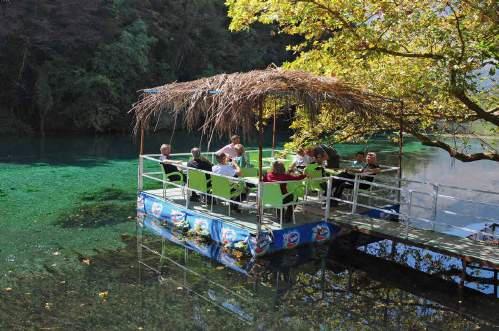
monasteries and Ottoman architecture dating back to the 14th century.
Leaving Kosovo, we crossed into Montenegro for only a short stretch. But that stretch was a pleasant ride up to the Kulina Pass, which at 1800 m makes it one of the highest passes in the Balkans.
This wasn’t a technical climb and descent — there were only a few hairpin
Above: Albanian Countryside.
Below left: Blue Lake Coffee stop Albania. Below: Defensive bunkers built during Albania’s postWWII communist regime; Albanian Macedonian Border. Top left: Wooden ferry boatAlbania.

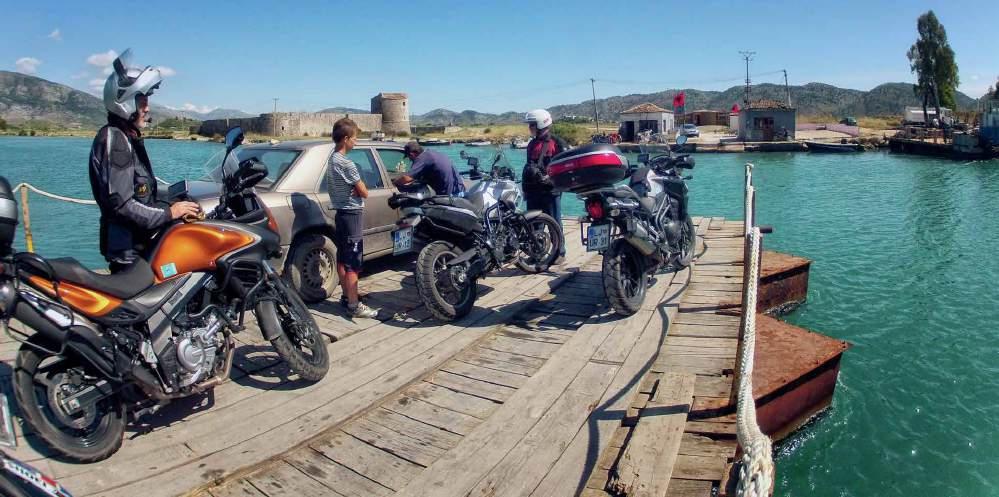
turns. Instead, a lot of moderate backto-back curves tested our skills. By this time, both Jim and I had taken our cornering skills up at least a couple of notches, and that’s a great feeling, innit?
Upon our return to Belgrade, we didn’t have the traditional AMT champagne toast. We needed rapid covid tests at the airport, and raising a toast in a parking lot there seemed like a bad idea.
So we said our goodbyes quickly, as Jim
and I had to pack up for early flights the next day and Tomaš had to load up the van for an all-night drive to the AMT home base In Ljubljana.
Along with memories of the thrilling riding, the tasty cuisines, the scenic landscapes, and the city scenes we experienced, I also have the fondest memories about the laughs and the stories the three of us shared.
Although our parting was rushed, we pledged to keep in touch — and we have.
Jim and I may meet each other again, as
we are both looking for opportunities to hone our cornering skills in new corners of the world.
We were both thoroughly impressed by our AMT experience, and are looking over the company’s Calendar for another mountain riding adventure.
in 2024, the intriguing Southeast europe tours run in late spring June 8 – 22 and autumn September 7 – 21, starting from Belgrade, Serbia. Visit AdriaticMotoTours. com for more information.

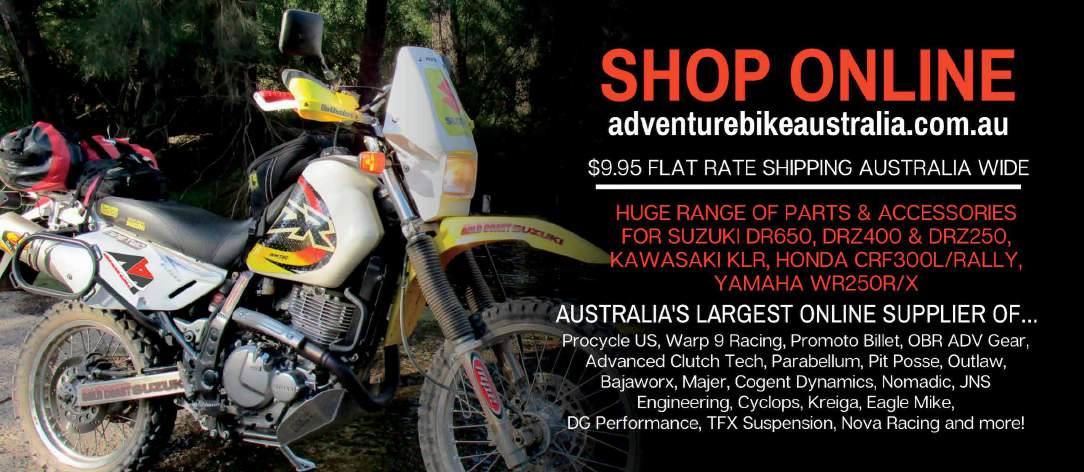
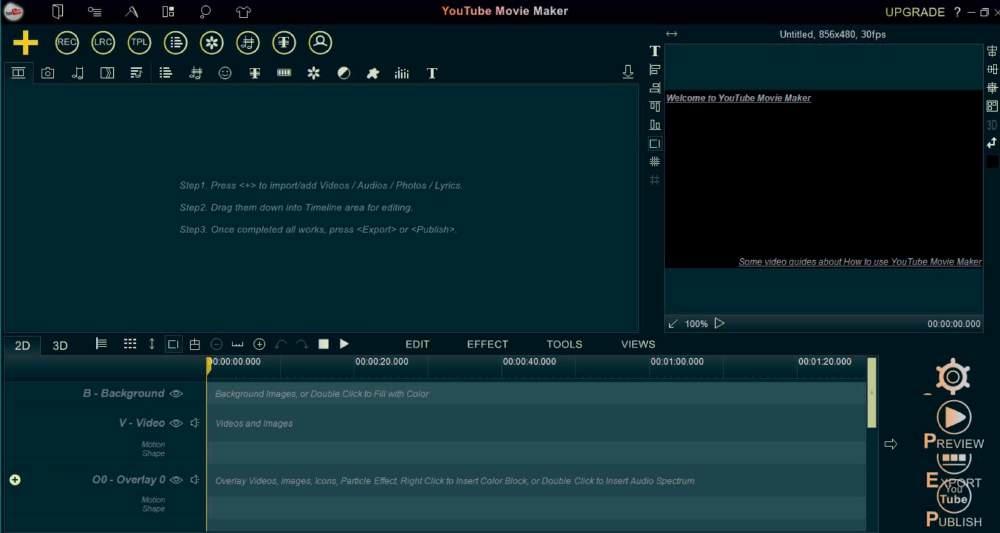
A fun way of showing off your ride is through a slide show on YouTube. It can make it more interesting, as well as a way of revisiting your past rides.
Having a soundtrack to accompany it makes it much more palatable to watch without intrusive dialogue and the drone of an engine. Each piece of music evokes certain memories. The sound track you choose also accentuates the feel or atmosphere of the ride. Everyone has their own taste in music whether that’s heavy metal, rock, country, folk or classical. Chances are, you’ll already have your favourites playing in the back of your mind while cruising along the highway or bouncing along a track.
The slideshows should ideally range from 3 to 8 minutes to keep audience
Words and images: Bob Wozga
attention focused. Multiple pieces of music or samples can be added to prevent silence between slides. The clips can be an amalgamation of stills and video and it’s your own choice as to what ratio to use. Try to keep video and stills samples to 3 to 4 seconds to retain the viewers engagement. Each person has their own style, and it is a matter of trial and error to get it right. You’ll never get it right the first time. (Prove me wrong!)
When planning the slideshow or video, focus on the motivation of what you are trying to portray. Showcase not only the final destination but also what you endured to get there. Keep it interesting and authentic and engaging.
There are several ways of creating videos and slideshows with many apps
that can be downloaded from the net. I tend to use You Tube Movie maker just because it’s easy to manipulate and use.
1. Sign into YouTube
2. Click onto your profile picture and create an account. You’ll be asked to create a channel
3. Check the details (with your google account name and photo) then press confirm and create
4. Open Youtube Movie maker and click onto “Make Videos” The free edition allows you to make clips up to 5 minutes duration. You can upgrade to Gold or Platinum for a US $29.99 or US $49.99 depending on your requirements or press NO to continue for the free edition.
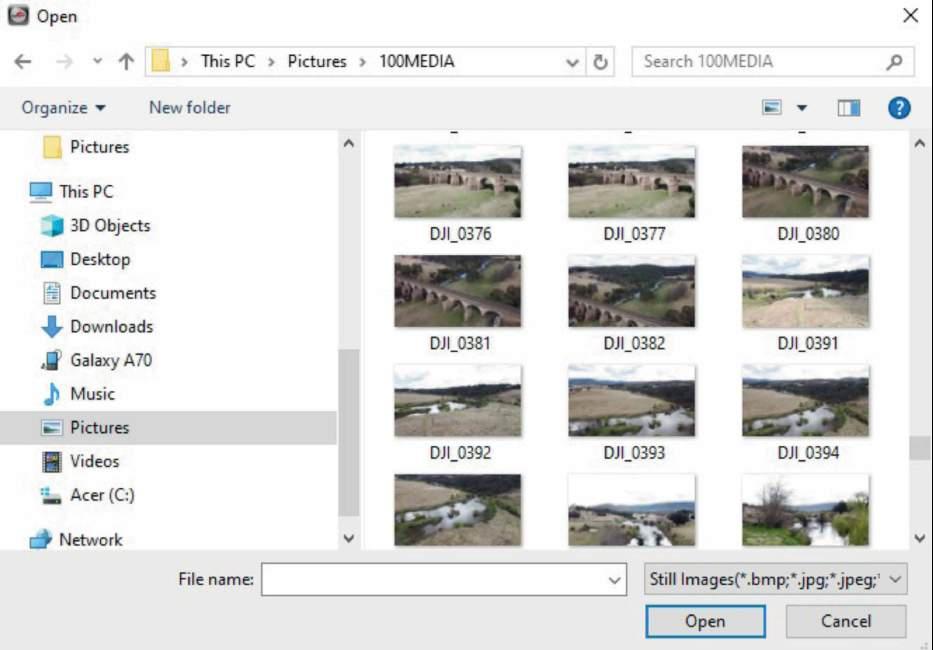
Above: 2. Clicking “import/ add image” opens your picture files where you choose which file to open to import your images. Below: 3. Select the images you want.

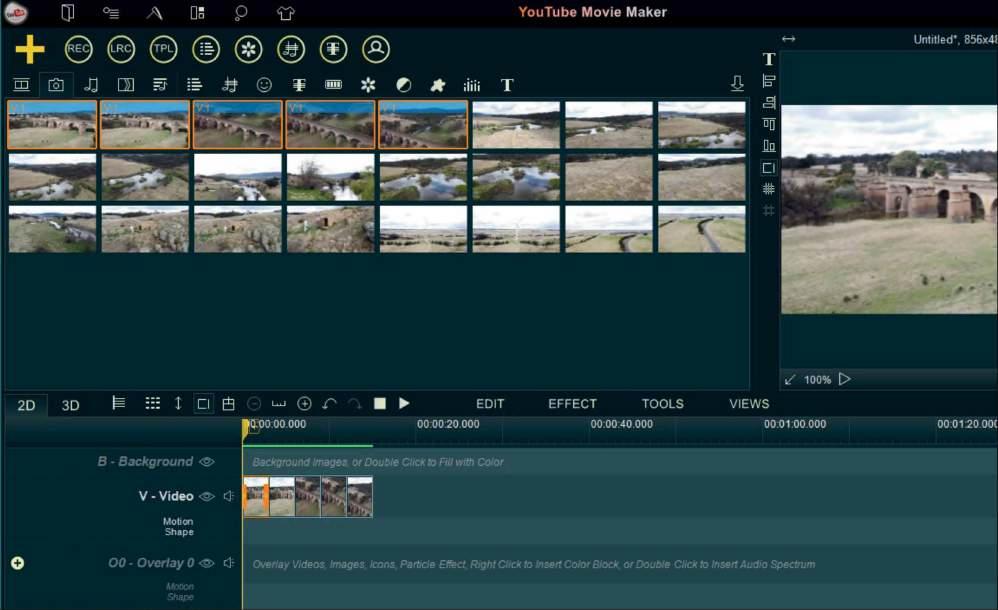
Above: 4. Drag the required images to the Video / Image line.
Below: 5. Do the same for video footage that you want to use. You can place video in between stills and adjust the video length to suit. Add the images one at a time to create the story you want to represent.
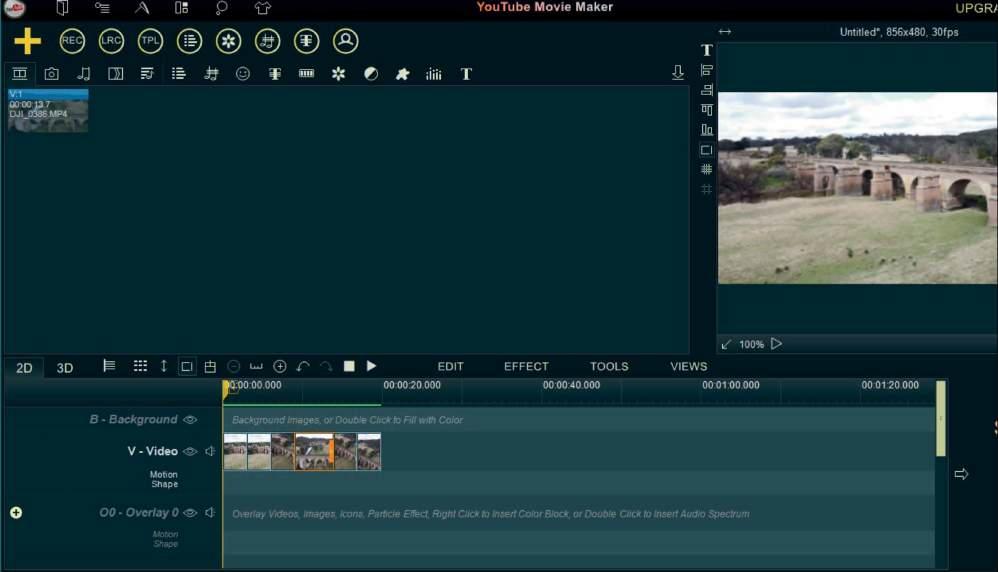
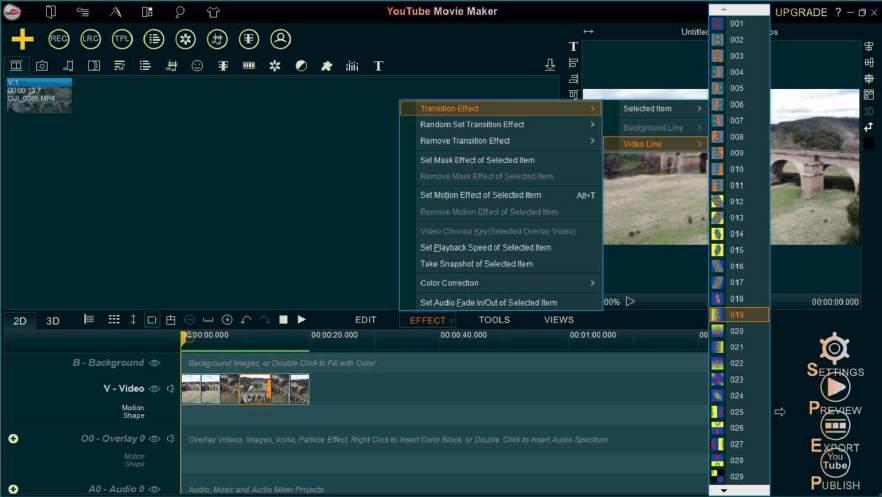
Above: 6. Clicking “Effects” allows you to add transition effects between images. Choose the one that fits your story best.
Right: 7. Adding music, click the yellow + and import audio from the drop down box.
Below: 8. Import from your source that you keep your music.


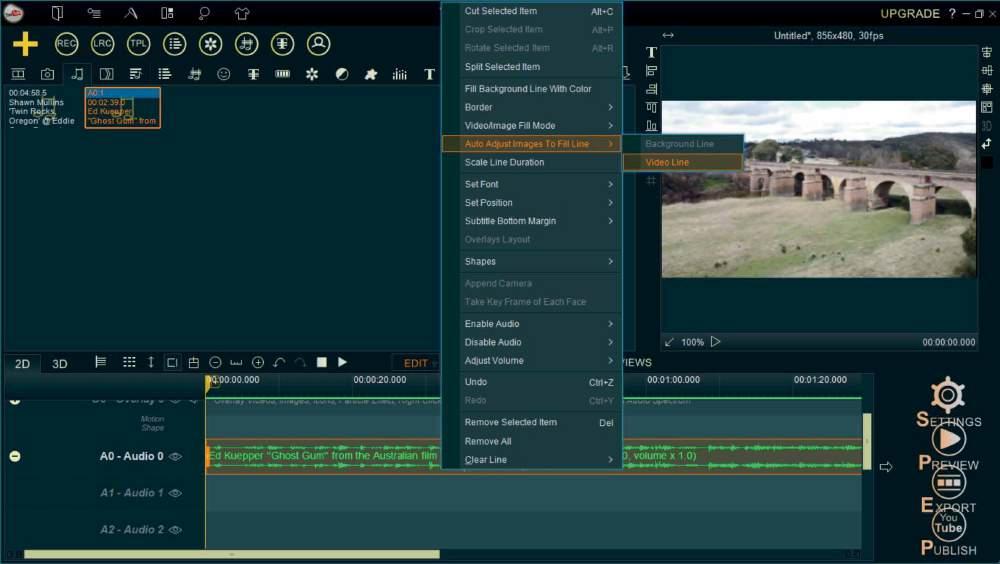
If the song is longer than the number of images to be shown.
down
- adjust images to fill line – video line. If the msic is too short, you can add extra music or adjust the music to add samples of the misic to suit your needs.
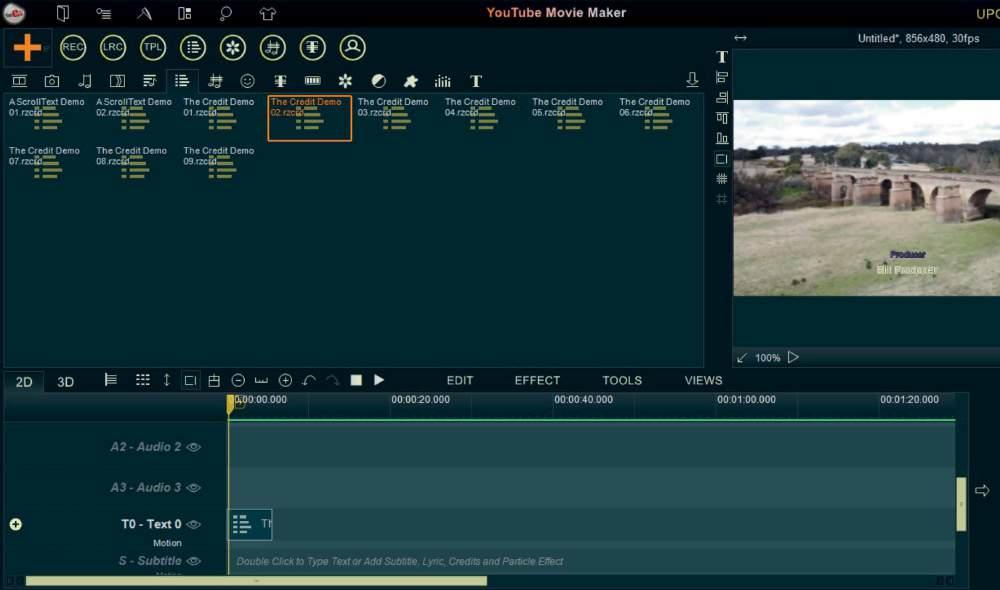
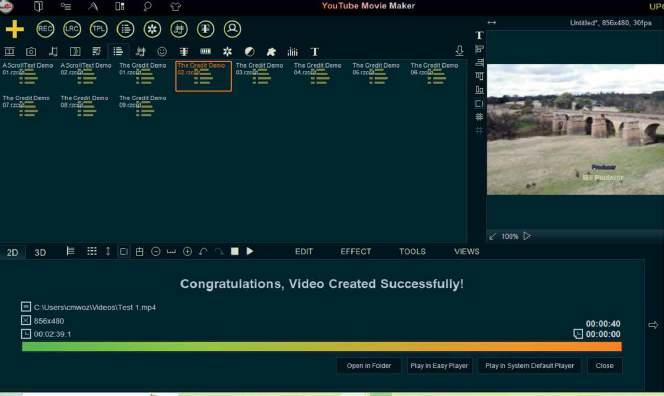
Above: 11. You can add credits to the beginning and end of the clip by clicking the edit icon from the too bar and use the templates provided, choose the one that best fits and the move the credits to the T0 –Text0 line.
Top right: 12. Clicking ”Play or Preview” enables you view the clip before making any adjustments or to export the completed clip.
13. Click Export to save the clip in the file you want to store it on your PC. Name the clip and save. This will convert and save the file, it may take a little while.
14. Once happy with the produced clip, Open Youtube an click the Create Icon, top right between the search bar and notofication button. Drop down box, Click Upload video.
15. Upload the selected file.


16. Fill in the requested details, title, description etc. It will flow through a number pages. It is mandetory to tesect whether it is made for kids or not and will do copyright checks to ensure nothing is copyright protected. Some pieces of music are protected. It will ask if the content is for private or public use and when you want it premiered.
17. Press Save and the clip will be uplaoded to YouTube.
Now all you need to do is load your bike and camera and put your rides out there.


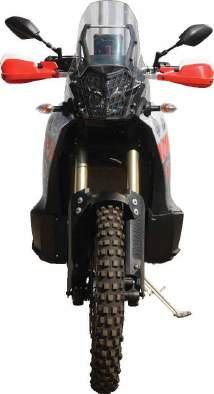



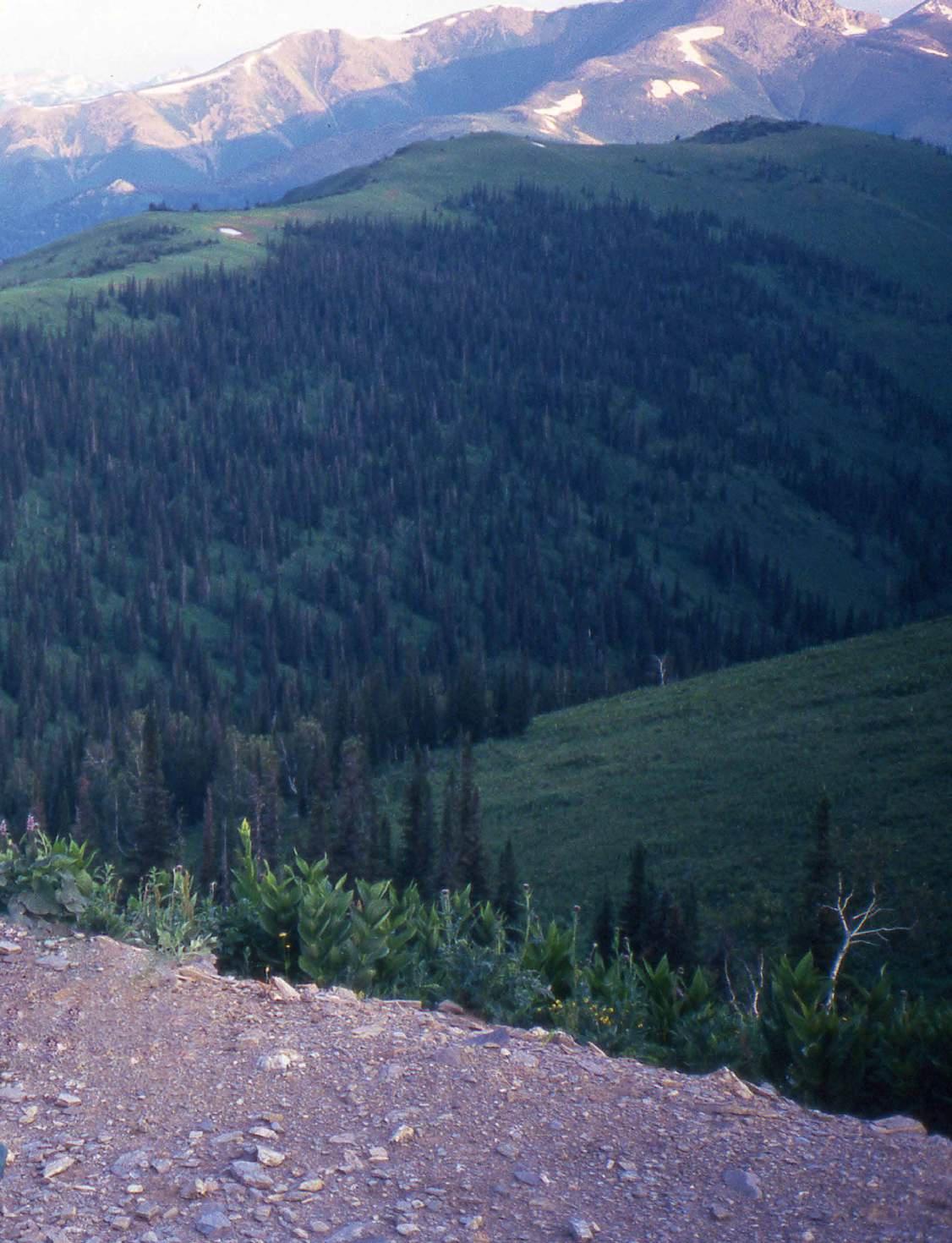

Right: Get off the beaten track and cross paths with Russian marmot shooters in Siberia.
Based on my ride through Africa and along the Silk Road from London to Hanoi riding my Yamaha TT600 from 1993 to 1997, here are a few tips to avoid a breakdown, but how to embrace it when the inevitable happens, and thoughts on what tools to carry for ‘Adventure Motorcycle Travel’.
I’m no expert. And I can’t strip down my bike and rebuild it on the side of the road or even in my shed (I doubt very few could either). I respect the art of motorcycle mechanics as this is a skill that takes training, aptitude and years of experience. And that’s why, I’m more than happy to leave the deep dive into motorcycle engines to the experts. For my beloved Yamaha TT600, this will be the guys at Just Dirt Bikes in Derrimut, Melbourne. www.justdirtbikes.com.au
My Yamaha TT600 is kickstart so there’s no electrics. The automatic decompression works most of the time so starting is almost as easy as pushing a button. The advantage of such a bike is its light weight (138kg wet). Today, you’d be hard pushed to find a 600cc adventure bike with a
wet weight under 200kgs. For adventure motorcycle travel it is a balance between power (and the more power the better), in proportion to weight (and the less weight the better). Unfortunately, powerful bikes are big bikes, which means they are heavy bikes. Weight is critically important to having fun on your adventure ride. There is no better feeling than using your bike’s power to take you far away from the maddening crowd to behold vistas on top of mountains, up over sand dunes, cruise along trails that wind through forests and across creeks, or feel the tires bite into mud to carry you through bog holes that not even adventure bike manufacturers thought existed. It is in these rugged off-road conditions where you open the throttle and know your bike in all its reliability and gutsy power can do its job. In an ideal world, there are no breakdowns, no punctures; and your bike (which for most will be electric start), always fires. However, even my trusty TT600 in all its rugged simplicity, had its fair share of punctures, minor running issues (worn clutch plates and a sticking
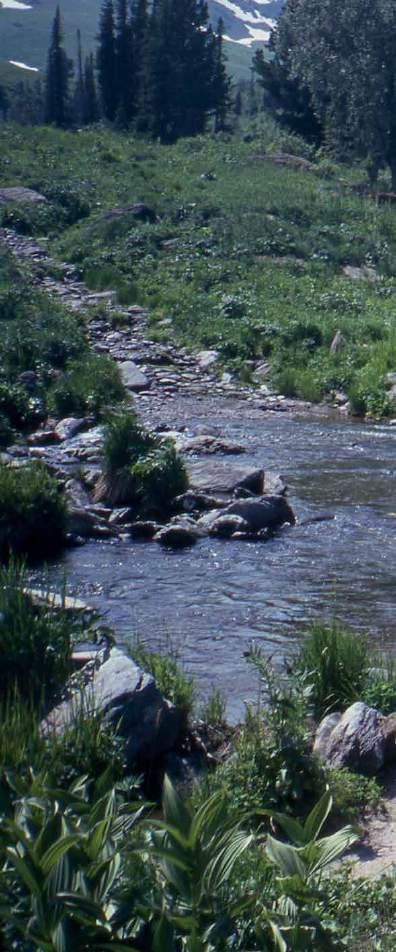
carburettor) and two major breakdowns. Regular servicing including checking and tightening any lose components; checking for wear and tear especially where this should not be occurring, must become your religion when on the road. Bed time reading of your bike’s workshop manual before and during your travels will forewarn you of the dangers. But breakdowns still happen. Through my own inattention, the TTs suspension failed in a remote part of northern Kenya. Friction from the rear tyre resulted in a tear in the hose joining the piggy back remote reservoir to the damper unit. If only I had checked the rather flimsy clamp securing it below the rear mudguard. Fortunately, a local suspension business in Nairobi managed this difficult repair. Another major mechanical failure were the two
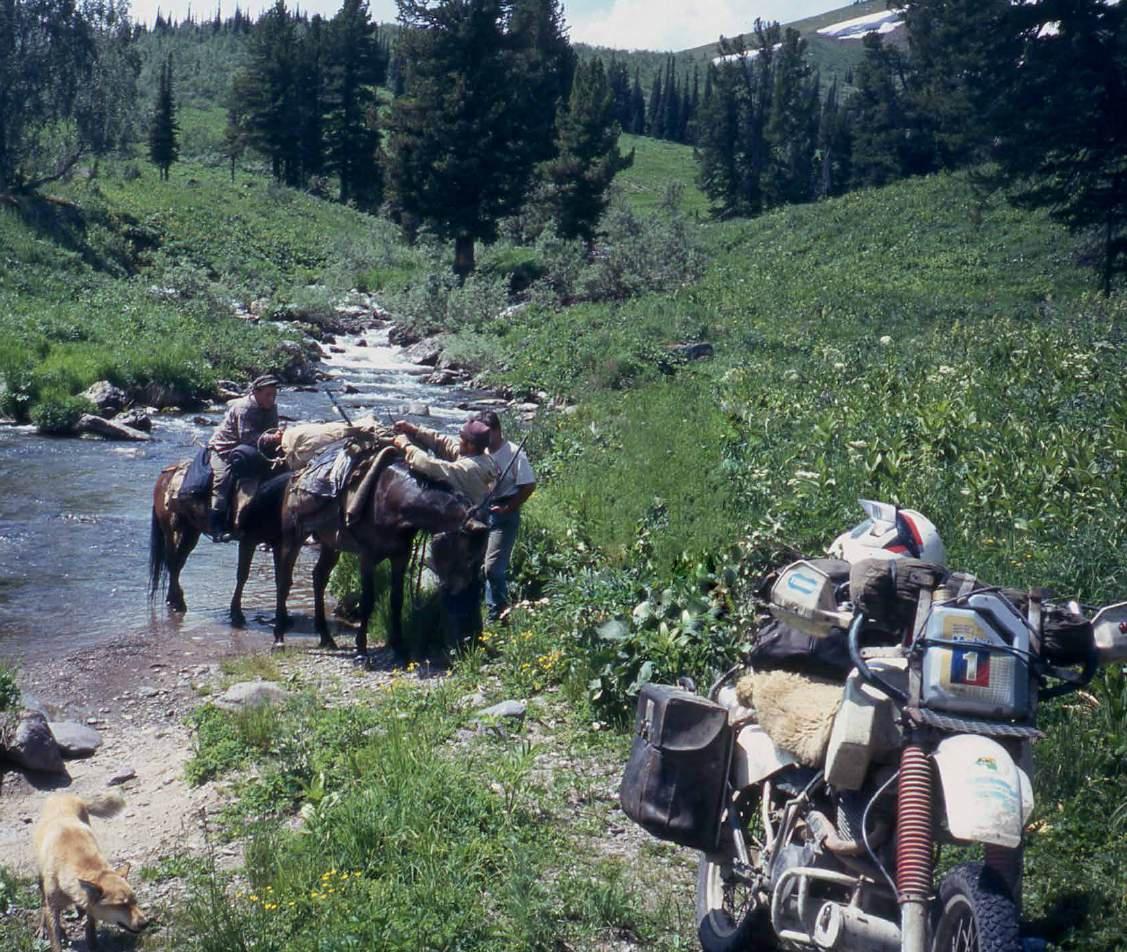
carburettor intake boots. Unbeknown to me, the outside rubber can become detached from the metal inner sleeve allowing unfiltered air to enter the engine and I had been riding through the Sahara at the time until the TT came to a grinding halt.
Tools, in the hands of the inexperienced will never see their full potential, unless you have your motorcycle’s workshop manual. But tools are heavy. Only carry those spanners that fit the nuts and bolts on your bike, plus a shifter, your bike’s sparkplug socket tool, a set of allen keys, feeler gauges (I have tappets), screwdrivers as needed for the bike, long-nose pliers, assorted spare nuts, bolts and washers, cable ties and wire. Plus, the all-important spare tubes, tyre pump (or compressor for those with electric start),
tire leavers and puncture repair kit.
In Africa, I had punctures often; sometimes several a day. This is because the wooden crates of trucks are held together with nails and on pot-holed and corrugated roads, the nails rattle off. Avoid pot holes at all costs. But with the tubeless technology of today and tyres having a high resistance to punctures, chances are you’ll never have a puncture. Even on my six-month ride on the Silk Road, I did not have even one puncture. But when you do have the inevitable breakdown, don’t have a minor meltdown because it is late afternoon and the hotel with cold beers and steak that you read about in your guidebook is just another two hours ride. Instead embrace your breakdown and what unfolds next: the people you meet, the culture you will experience in this
momentary stop that has brought your worlds together.
Such a breakdown happened to me when my clutch plates needed urgent adjustment as I had ignored the inevitable for quite a few kilometres. It was late afternoon in a township in the Altai region of Siberia near the Mongolian border. This is an extract from my second book Timeless On The Silk Road. And this is one such breakdown that I embraced on my journey.
Kosh-Agach is a desolate frontier township with pitched-roofed fibro cottages where entangled power lines hang from poles leaning at odd angles. The town was built on a barren depression where not a blade of grass could survive. But in its desolation under an eternally blue sky with snowcapped
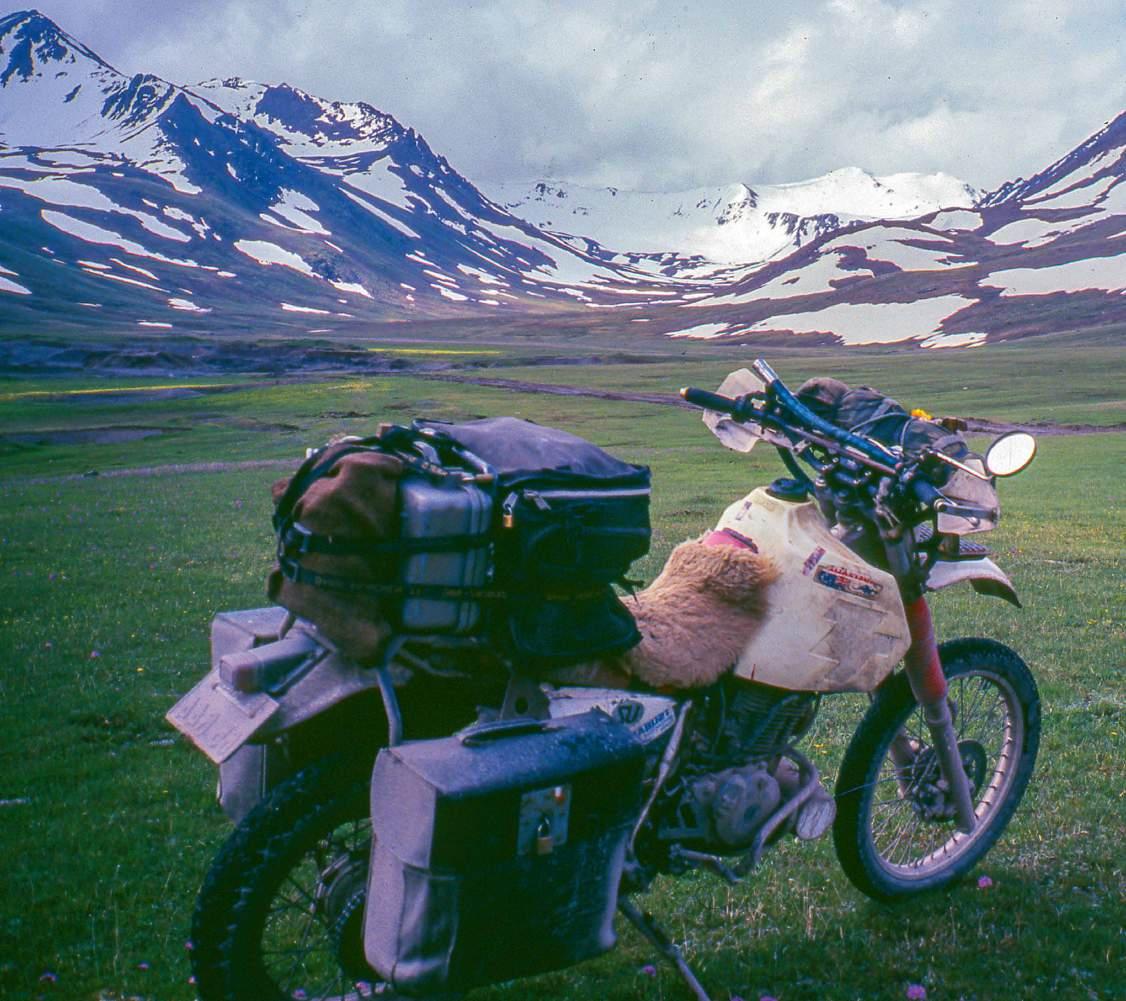
mountains rising in the distance, it was eerily beautiful.
It was late afternoon, and the TT’s clutch had finally reached the end of its wear, and I was forced to pull up outside a row of identical fibro cottages with pitched iron roofs, the walls painted bright blue. I had no choice but to perform ‘surgery’ right there where I’d stopped. I could only assume that the cottages, and the entire town, in fact, was built by the Soviets to house workers for a nearby gold mine. I retrieved my tools and workshop manual and laid the bike on its side. By now a group of children aged from toddler to teen had gathered to watch. One of the older children, a girl aged about twelve with an angelic face, elongated eyes and
the long sleek black hair of her Kazakh heritage, could speak a little English and bombarded me with questions, translating my responses to the others. ‘Where you come from? What you do here? Where you go? What is your name? Where is your husband? Do you have children? Is there a problem with mototsikl? Do you need mechanic? My uncle is mechanic!
As I deciphered the workshop manual’s instructions, I answered as best I could. After successfully adjusting the clutch plates, I was about to replace the engine cover when Aisha, the girl who’d bombarded me with questions, began tugging at my shirt.
‘Come. Quick. Not stay here. Mostiques,
mostiques,’ she repeated frantically.
‘I can’t leave the engine open,’ I said and seeing I would not budge, the children dashed into the nearby house as if an apocalypse was about to unfold. I heard the buzzing first. I looked up, and a black cloud of mosquitos swarmed towards me. As the first enormous blood-suckers landed, each about a centimetre long, boring their needle-sharp proboscises into my soft exposed skin, I quickly pulled on my jacket and helmet, closing the visor and tucking my scarf around my neck. I couldn’t put on my gloves as I needed bare hands to fit and tighten the bolts on the engine. The pain was almost unbearable as they feasted without opposition. In a matter of
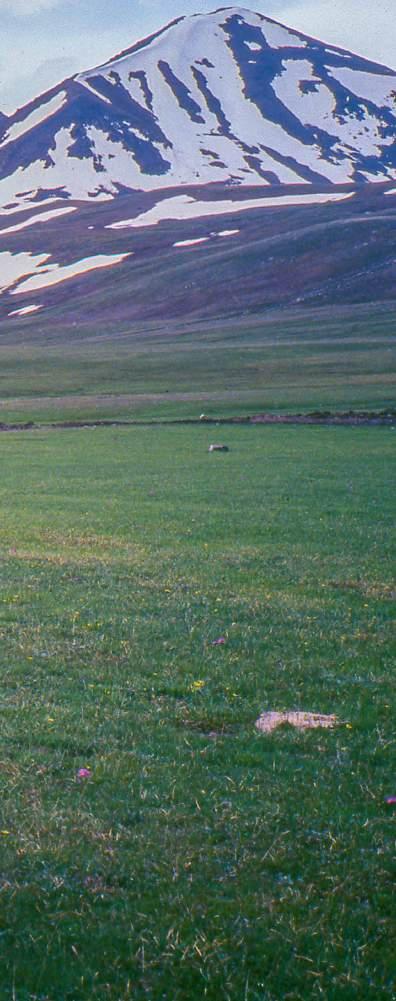
Above: With an adventure motorcycle you can go anywhere. The Talas Alatau mountain pass in Krygyzstan.
Top right: Embracing a breakdown in Siberia led to a chance meeting with Aisha where her family welcomed me into their home and another adventure unfolded.
Bottom right: Heather’s books, Timeless On The Silk Road and Ubuntu: One Woman’s Motorcycle Odyssey Across Africa are available on Amazon or www.heather-ellis.com
seconds, my hands were a mass of red welts, but once the engine covering was fixed, I dashed towards the house. Aisha quickly opened the door.
‘Mostiques very bad,’ she said, shaking her head as she held my swollen hands.
‘Does this happen every day?’ I asked.
‘Only in summer. Mostiques gone soon,’ she replied.
We waited about an hour then the children all filed out, following me back to my motorcycle where I re-tightened the bolts, packed away my tools and asked Aisha if the children could help me lift the TT. They eagerly agreed.
‘Come you stay with us. Very welcome,’ Aisha said and I pushed the bike to a flat-roofed one-room white-washed
cement block hut at the back of the fibro cottage painted bright blue. The blue cottage looked unlived in. As we walked past, I asked: ‘Don’t you live in there?
‘Sometimes in the summer when it is very hot. In winter, too cold. Too big to keep warm,’ Aisha said and ushered me inside the squat little hut, where I met her mother, a middle-aged petite woman, and her ageing grandmother.
Both Kazakh women smiled their welcome, and when Aisha told them she’d invited me to stay, they both nodded. It appeared the tiny room was home for the

already travelled.
“ Tools, in the hands of the inexperienced will never see their full potential, unless you have your motorcycle’s workshop manual. ”
two women and three children; Aisha, her younger sister and toddler brother. I asked about her father, and Aisha told me he and her uncles were out on the steppe grazing their animals for the summer. Tapestries hung on the white-washed walls. A dung-fired stove sat in the corner. The grandmother opened the door and threw in a dried cow pat. I sat at the table and was offered a small bowl of milky salted tea. Later, we ate a meal of soft white cheese, stale bread with rancid butter and a fragrant potato and herb soup. After the meal, I brought out my photo album and map, and Aisha translated my tales of adventure.
‘Tomorrow, I will go to Gorno Altaysk to ask the Altai governor permission to cross the Russian border into Mongolia. If I can’t get permission, I hope to get a lift on a truck to Barnaul and then another to Almaty,’ I said, speaking my plans out loud. The Russians had refused to let me exit Russia at the Tashanta border as it was not open to foreigners.
My rear tyre was already quite worn and with no prospect of buying a spare, I did not want to ride the 2000kms of straight tarmac back to Almaty, Kazakhstan, a road I had
‘Uncle Sergei is a truck driver. He drives from Mongolia to Barnaul. He gives me clothes,’ Aisha said standing proudly to show off her pretty T-shirt and blue jeans. She then exchanged a few words with her mother and beaming a smile said: ‘He stops here tomorrow.’
Just as Aisha promised, the next morning Uncle Sergei arrived bearing gifts. I was about to leave when she came running to tell me the good news. A convoy of six ageing trucks each carrying shipping containers were parked on the dusty street. The drivers climbed out, and a Kazakh man picked up Aisha, swinging her in the air. None of the men spoke English, and Aisha asked if they’d give me a lift to Barnaul.
(From Barnaul, the truck drivers arranged for another truck to carry me and my motorcycle all the way to Almaty, Kazakhstan and that is another adventure from Timeless On The Silk Road).
Heather’s books, Timeless On The Silk Road and Ubuntu: One Woman’s Motorcycle Odyssey Across Africa are available on Amazon or www.heather-ellis.com
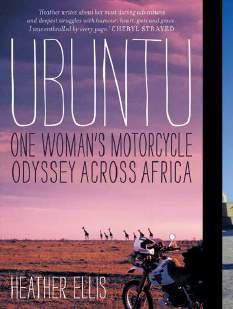

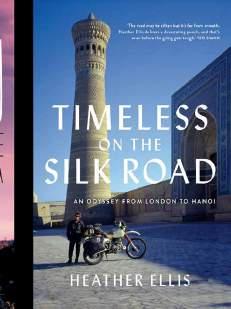

The rain woke me at 2am, with a ride planned for Broom Heads, postponed from the sunny yesterday to today to get a riding partner. The area is often dry so as I checked the weather radar only to find the whole area of the ride buried in rain. Morning might change things as I tried to get back to sleep.
Morning did change things, Jessie cancelled at 6am, and the rain was still over the entire route. The fact I should have gone yesterday was not lost as I geared up. I hate cancelling rides.
I turned off the computer, grabbed my rose-coloured glasses and ignored the wife’s cold hard reasoning that I was in for a crap wet day.
With the glasses on the world was a better place, if I squinted, I could almost see clear blue sky. Between the drops it was barely raining at all, so after a quick refuel and transport to sapphire it was on.
Just as I suspected, the rain stopped for a photo just before the dirt, perfect. i had to take the glasses off to put on my helmet and looking north off into the distance you could see heavy rain, i quickly turned around and put the glasses back on’.
Settlers road was a joy, the bush shined in the filtered light, the red clay shined, everything smelt new and fresh. With a few joggers and a man walking his dogs for company all was good.
Suckers stuck at home or work; a huge smile covered my face.
Crossing Bucca Rd and back into the bush, just as I hit forth one of nature’s joyful creatures seeing that I was alone rushed out to give me a cuddle, how cute.
The impact of hitting the mongrel roo nocked the glasses forward allowing the true light of day in. $%**## and a few more choice words were screamed inside my helmet, $%*# 32 km and i’ve hit a roo already, the impact jarred my wrists but as i was on the throttle we stayed up. I quickly pushed the glasses back up, shame I didn’t have more time or we could have stopped for a cuddle on the nice clean red clay. Thankfully the rain started in earnest washing any negative thoughts away.
For some reason I had always thought of this area as more gritty soils but I was
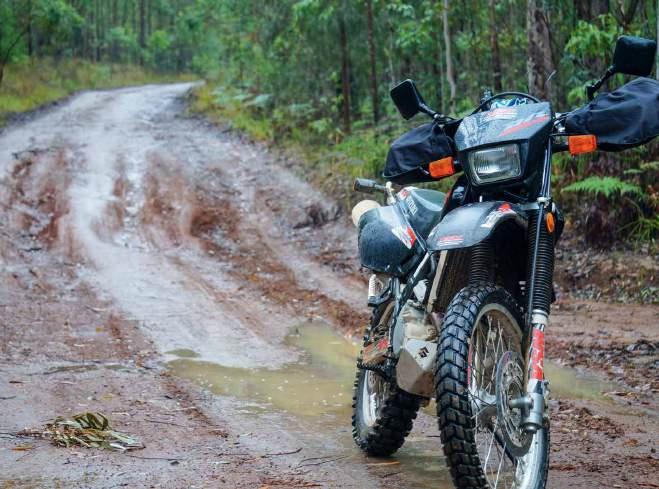
relieved there was so much red clay everywhere just like home. Anderson’s mountain road looked great, the extra slippery service and the rain drops hanging on the closed-in lantana offering refreshing swipes across the face was beautiful.
As the road opened out and speeds increased, I was worried that the ride would get boring. Thankfully the thick cloud and mist kept down the distracting views and a well-placed tree just around the corner provided some excitement and as it was hit at speed a nice jump. A few rutted slippery sections over hills had the heart racing with joy.
The mist had fogged the glasses so as i pulled them forward to see, reality hit me in the face light a bucket of cold water, no that was just the rain, shit, still close to home and i had nearly fallen around three times already, was i nuts, this is shit.
I stopped on red range road, cleaned my glasses and kept on going. This rain must really be helping the blueberries grow as I cruised through. I decided to take the Station Creek turn instead of the little used lookout trail as I was by myself. My joy was only enhanced when I found they had sort of graded the road, sure
u
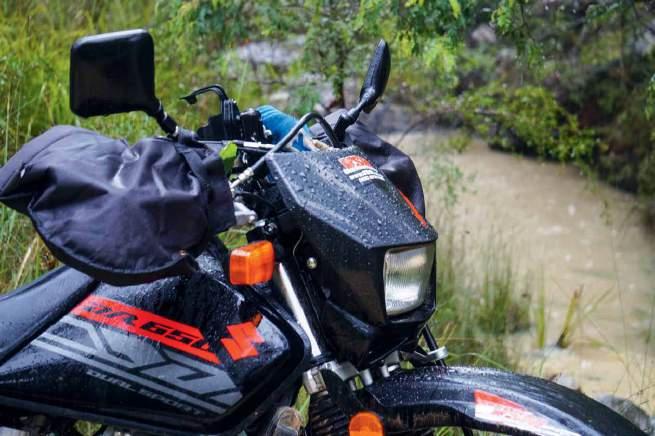
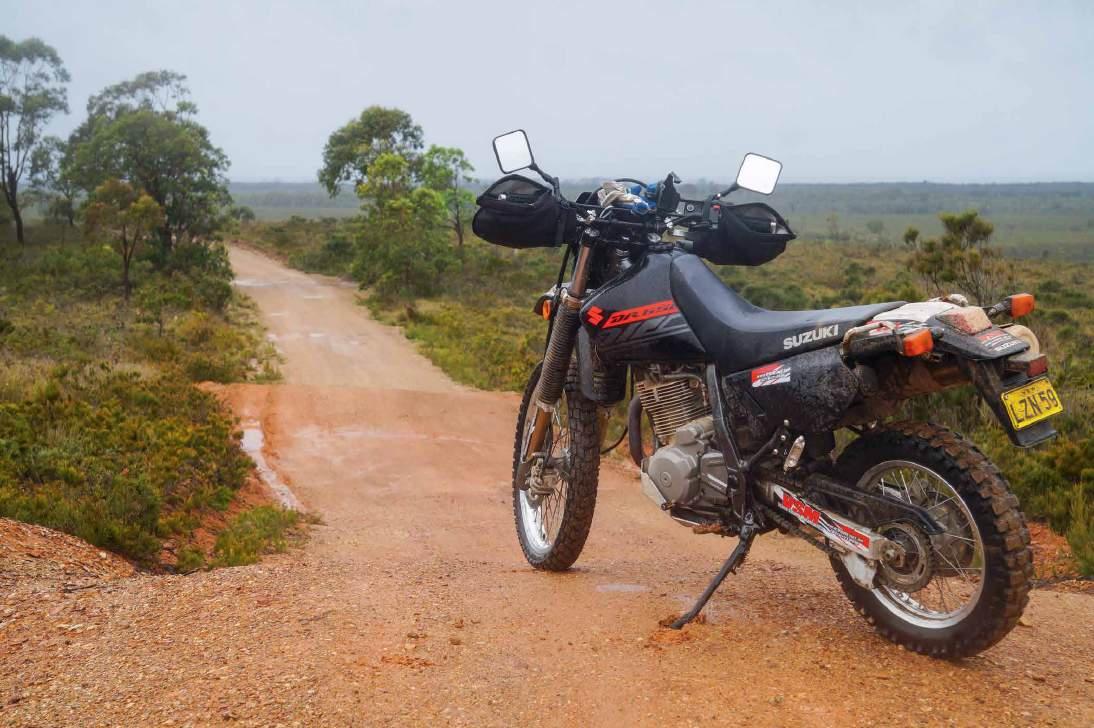
the huge pot holes were still there but loose soil in piles had an almost black soil feel as it sucked you down and grabbed at your front wheel. All this excitement and extra energy turned a boring road into a body warming section of excitement. It had even stopped raining, how good can it get.
Cruising up onto the range, the inability to slow on the slippery sections meant I was making good time. A photo stop was a slight disappointment, my bike was covered in mud and didn’t match the shiny bush. Oh well you can’t have everything and this section was fun.
Or can you, ask and you shall be rewarded, as extra heavy rain bucketed down cleaning my bike, does life get any better than this, With the bike clean I stopped again for photos, taking off the glasses for cleaning.
As i stood there trying to keep my camera dry, the clean bike did little to cheer me up, with chewed out rutted track everywhere, the only smooth sections were off-camber clay which repeatedly tried to take out my front wheel. The fact i had standard front tyre on while near new knobbies sat in the shed on my JTR wheels. What an idiot i thought as the water started to seep into
my sensitive regions, should i turn around at Wooli road? it will take me 3 hours to get back to here; doubt was starting to set in.
After cleaning the glasses again positive thoughts started to come back as the rain ran down my face. You can’t turn back just because things are a little bit difficult and this ride will bring fond
memories in a week or two.
Then it stopped raining, the sun almost came out as we turned into Candole Road, even the logging was called off today as harvesters sat idle. How lucky can you get?
Then it bucketed down, heavy as, the red water came running down the trail in nice patterns highlighting the ruts, the spotted gum shone, even the trickle into
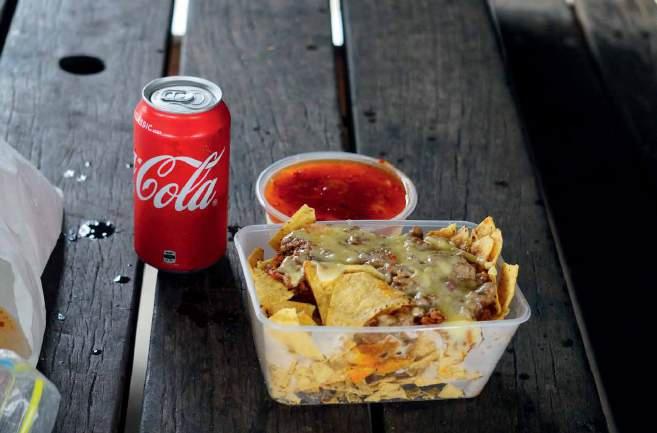
my private parts stopped, replaced by a constant stream that filled my boots. Was this great or what; spectacular and making good time.
The logging had churned the road up making it interesting, as I dreamt of the nachos from the beach hut at Brooms gave me a warm feeling of anticipation, as I licked my lips which strangely tasted a bit like muddy water.
A really bad rutted section of red clay snapped me out of my daydream, as i bounced through the slippery ruts and into the gutter my glasses came forward. Lots more swear words as i struggled to keep the big girl upright, at least the rough as guts drain had some traction, eventually we stopped only to do almost the same a couple of km further on this time ending in a deep red puddle of slime.
The rain stopped again, so I paused in an easy rutted section, snapped off a few photos, decided with only 20km to go to Brooms I might just slow down and concentrate on just getting there. Cleaning my glasses worked a treat, the notoriously slippery road seamed easy, the swampy sections looked fantastic ant the views of the clouds instead of a sparkling ocean had a rugged beauty. The last ten km the road firmed up, some nice jumps and the rain stopped, man this is great I thought, glad I didn’t stay home.
As I rode past campers wet and dirty, I couldn’t help but chuckle; who would be dumb enough to camp in weather like this: suckers.
As I tucked into the warm nachos overlooking the beach as the rain bucketed down outside, I couldn’t help but think what a great adventure this had been, a normally pleasant but easy ride had become interesting and character building and the best bit was as the heavy rain set in for the rest of the day, I got to turn around and do it all again.
Gotta love rose coloured glasses.

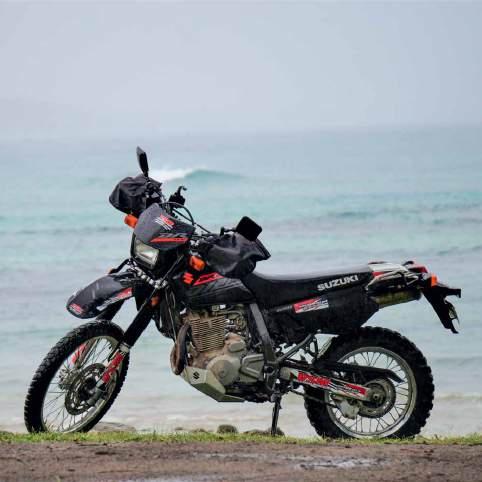
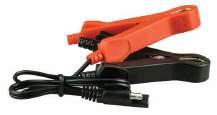

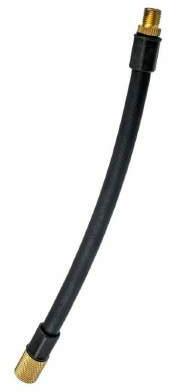
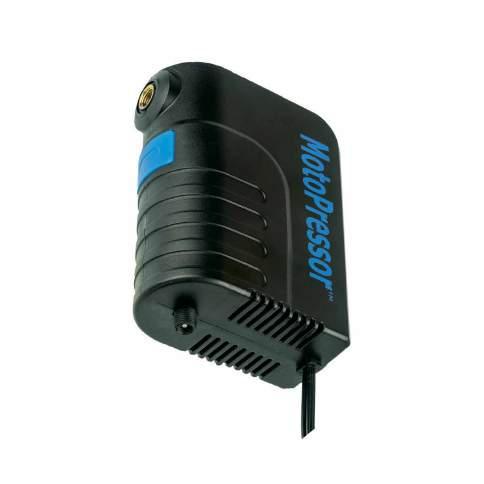
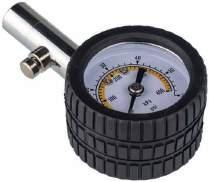




As you no doubt know by now, I’m a road rider convert, a late comer to the dark red, dirty side.
Ol’ mate Tontine the Plush, born in the shadow of the black stump, his first form of transport was a dirt bike. He never had a bicycle! His dirt skills were bumped into him while chasing cattle and are so innate that he can’t isolate them to pass them on. During a post ride, Beer Garden de-brief I asked… “How the hell did you make it through that last section without a near fatal main freckle pucker?” “I donno, just did it” he said while miming a sort of inco-ordinate upper body boogie. Bloody early learnt muscle memory!
I’ve got it over him when we go surfing, I just keep a wet towel handy so he doesn’t dry out before the wildlife service can get him back into the water. “You can just feel when the moment is right to stand up”, I tell him.
One of the biggest difference between our road riding brethren (and sisteren) and us Adventure riders is the amount our bikes move about under us.
Sometimes I still punt an old bike with things like kickstart, points, carburettors, throttle cables and right foot gear changes … a slide used to be a serious heart stop-
ping event. Having a rear wheel step out got the Fark Hormone coursing through every cell of my body. Now it’s a way to get the bike to turn a bit sharper on the dirt. It’s something I actually try to do! Who’d ‘ve ever thunk it!
Having a rear wheel step out got the Fark Hormone coursing through every cell of my body.
A couple of years ago at a ‘shits and giggles’ classic bike track day, I had the front end of the old jigger sliding into a particular corner. “Ha, I’m an Adventure rider these days, how cool is this”, I thought. A couple of laps later while tucked onto the tank on the main straight, I realised that I was actually sliding it on the front header pipe not the tyre. A strong waft of virtual Dettol convinced me it was time to put it away before I
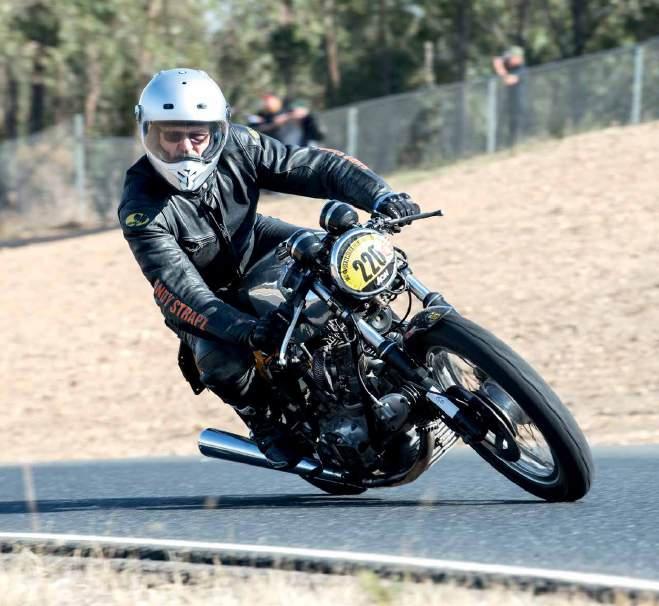

got a lift from Yvonne (Yvonne, Yvonne, Yvonne). The joys was, I never felt out of control. Twenty years ago I’d need critical incident de-brief and put on a clean pair. Dirt riding does so much for road riding skills. A step out on a wet road no longer is big deal. ’If in doubt power out’ (an elementary key to dirt riding) is becoming automatic. It often surprises me when my subconscious sorts out the issue and I realise the threat is already past. What a joyous feeling – “Ha, I’m finally getting it!”
When every ounce of our being is yelling, back off: Stop, don’t be a dickhead, take evasive action, WARNING! - We open the taps, hoping all goes away. And… It usually does! I reckon we all have a solid understanding of the physics - unloading the front wheel, reducing the tendency to divert off track by being pushed forward, yeah, but try telling that to the primitive survival instinctive voice inbuilt into a human brain.
Weird isn’t it. I’m happy to career through a dirt road at bookable speeds or bob about in the ocean as shark bait. But… Yer never gonna catch me jumping out of a perfectly good aircraft, why climb a sheer cliff? Free diving can get Fkd. Hanging off a few alloy tubes stretched with a bit of nylon is for the birds… (I reckon they’d refuse too).
So, what is it that draws us back to dust, sweat, noise, impracticality, aches and pains?
I think it’s the absolute and intense involvement in the moment. Every fibre of our being is involved almost every second. All our senses are working toward survival, all while we are actively turning the over-ride tube with our right hand as we do so.

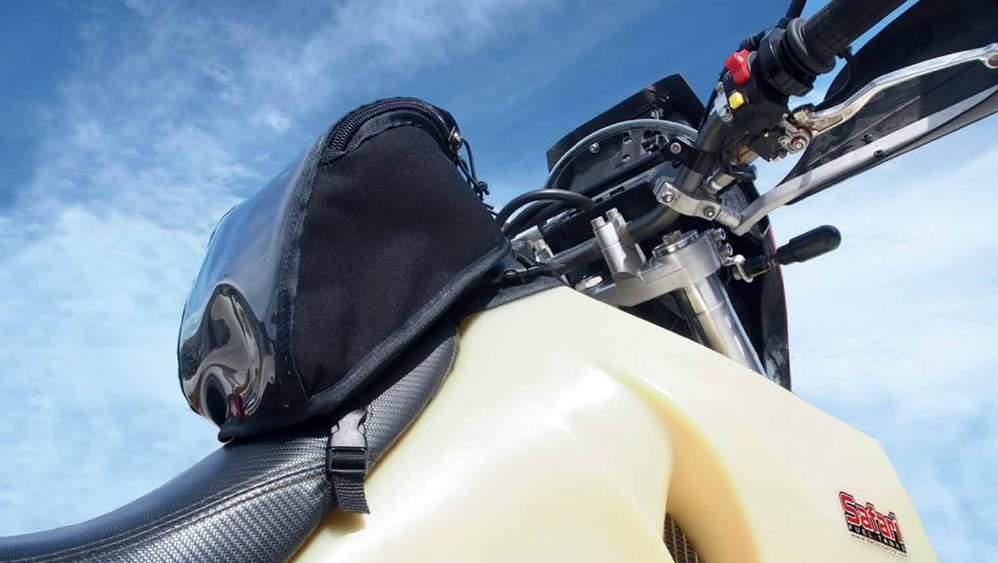
A unique Aussie take on Tankbags For Adventure bikes.
Andy of Andy Strapz’s reckons that the Mother Mother of Invention is the desire for something he wants for his own use.
Project Dr Z had him trying to track down a tank bag that would fit in the small gap available on a long range fuel tank, not get in the way, be stable, easily accessed, need not be fiddled with during re-fuelling and keep his “jatz crackers” safe when standing on the ‘pegs.
The bag shape came quickly as the space available between the Andy belly and the filler cap just required filling up. Logic kicked in, open it up more like a bucket with a lid than a traditional tank bag. This made access while still on the bike a cinch. Add a raincover that tucks up under the bag. The harness system holds the bag in place during the most rigorous riding and the bags stays put when refilling the tank.
The next part was to adapt it from the Safari Tank on the DRZ to his Kato so that it would fit most of the larger capacity bikes with ‘aircraft’ style filler caps.
There are two choices of ‘harness’ which are available separately. Riders can move the Safari Pod from one bike to another with no muckin’ about.
Extra harness are available so the bag can be moved from bike to bike.
Price: $295
Available from Andy Strapz
Phone 03 9786 3445
Email info@andystrapz.com www.andystrapz.com

